
Skylab in Orbit—A Pioneering Step in Space Habitation
This image captures NASA’s Skylab, America’s first space station, as it orbits Earth above a cloud-covered expanse. Launched in 1973 atop the final Saturn V rocket, Skylab was a monumental step forward in space habitation. Its cylindrical structure was once a repurposed Saturn V third stage, converted into a habitable space workshop that would support long-duration missions in low Earth orbit. Skylab’s solar arrays stretch outward like mechanical wings, collecting energy to power its onboard systems. The station carried a suite of scientific instruments, including the Apollo Telescope Mount, which allowed astronauts to observe solar flares, coronal mass ejections, and other dynamic processes on the Sun.
During its operational period from 1973 to 1974, three astronaut crews visited Skylab, conducting groundbreaking experiments in biomedical science, solar physics, and materials research—yielding a new understanding of how the human body adapts to microgravity. Skylab was also the first platform to test food preparation, waste management, and exercise routines for extended human occupation in space, paving the way for future stations like Mir and the International Space Station. Visible wear on its golden protective shielding reveals the damage Skylab suffered during launch when a micrometeoroid shield detached, compromising its cooling system and solar power. Nonetheless, emergency spacewalks and repairs made by the first crew ensured the mission’s success. This image immortalizes Skylab not just as a scientific outpost, but as a symbol of resilience, innovation, and the United States’ commitment to exploring life beyond Earth. It represents a defining chapter in humanity’s journey into the cosmos.

Skylab’s Fiery Descent — A Space Station’s Final Voyage
This striking image captures the dramatic reentry of Skylab on July 11, 1979, as it broke apart in Earth’s upper atmosphere, streaking across the night sky in a cascade of fire and vapor trails. After six years in orbit and three successful crewed missions between 1973 and 1974, Skylab became an uncontrollable mass of aging metal drifting above Earth. Initially planned for reactivation via the Space Shuttle, delays in shuttle development and increased solar activity—which expanded Earth’s atmosphere—accelerated Skylab’s orbital decay, sealing its fate. As it plunged into the thicker layers of the atmosphere at hypersonic speeds, the structure endured intense aerodynamic stress and heat, causing its components to disintegrate and burn.
Visible here are fragments of the space station illuminating the sky as they fall, a rare and unforgettable celestial display witnessed by thousands. Despite widespread fears that Skylab might strike populated areas, most debris safely fell into the Indian Ocean and the Australian Outback. The spectacle sparked global headlines and even humorous reactions, with Australians jokingly fining NASA for littering. Beyond the spectacle, Skylab’s fiery end marked a sobering reminder of the life cycle of orbital infrastructure and the challenges of managing space debris. Yet even in its destruction, Skylab advanced our understanding of atmospheric reentry dynamics and fueled renewed conversations about tracking and deorbiting satellites safely. This image encapsulates not just the end of a mission, but the transformation of space exploration—from bold first steps to lessons that would shape international space policy and orbital management for decades to come. It remains a powerful visual symbol of ambition, risk, and the awe-inspiring scale of our ventures beyond Earth.

From Orbit to Outback — Skylab’s Legacy in Metal and Memory
This composite image reveals two defining chapters in the life of Skylab: its operational grandeur in space and its unexpected impact on Earth. The upper section shows Skylab during its active phase in orbit, its large cylindrical body and solar arrays extended like wings against the black void. Originally a converted Saturn V rocket stage, Skylab served as America’s first crewed space station from 1973 to 1974. It hosted three missions that significantly advanced our understanding of life in microgravity, solar physics, and biomedical science. Its interior held laboratories, sleeping quarters, and a solar observatory. Though uninhabited after 1974, the station continued to orbit Earth—its fate sealed as rising solar activity heated the atmosphere, increasing drag on the aging structure. In the lower half of the image, we see the physical aftermath of Skylab’s demise: a large chunk of metallic debris lying in the remote bushland of Western Australia.
It is scorched, battered, and unmistakably manmade, with a man standing nearby for scale. This debris is part of the wreckage that survived the intense heat of reentry when Skylab plunged through Earth’s atmosphere on July 11, 1979. While most fragments burned up or splashed down in the ocean, some scattered across the Australian outback. Locals discovered tanks, panels, and other charred remnants in yards and fields—startling, tangible relics from space. The event triggered global media coverage and humorous public reactions, with local officials issuing a tongue-in-cheek littering fine to NASA. More than just space debris, this artifact embodies the closing chapter of an ambitious program. Skylab’s fiery end underscored the need for better end-of-life planning for spacecraft, paving the way for later protocols around safe deorbiting. These two frames—lofty beginnings and grounded conclusion—symbolize Skylab’s influence on human space exploration.

Skylab’s Crash Down Under — A Teenage Triumph and Media Frenzy
This black-and-white newspaper clipping captures a uniquely human angle of Skylab’s dramatic descent on July 11, 1979. The headline boldly declares, “A Skylab Claims Our Gold,” accompanied by images of scorched space debris and a teenage boy named Stan Thornton, who became a minor celebrity overnight. The charred fragments shown in the upper-left photo are actual remnants of Skylab that fell into his backyard in Esperance, Western Australia. These twisted metallic lumps—once part of a pioneering orbital laboratory—represent not just the uncontrolled fall of a spacecraft but the serendipity of its return. On the right side, young Stan is pictured holding a phone while a giant ceremonial check for $10,000 rests in his lap. The reward, issued by The San Francisco Examiner, was promised to the first person who could deliver a verified piece of Skylab debris to their newsroom. Stan boarded a flight to the U.S. with a sample in hand, earning his check and a wave of media attention.
This moment of levity contrasted with global anxiety—people tracked Skylab’s reentry path, unsure where it would land. In the end, it scattered across sparsely populated regions. The newspaper’s playful tone—“Aussie looks like the winner”—belies cultural questions about space debris and accountability. Though NASA avoided major fallout, the Esperance council cheekily fined the agency $400 for littering—a bill NASA never paid. This image captures how space history collided with everyday life, reminding us that even massive technological undertakings can leave a footprint on the most unexpected front lawns. Skylab’s fall wasn’t just an end—it was a moment when global science met local surprise, and a teenager answered the call.
On July 11, 1979, Skylab, the first U.S. space station, re-entered Earth’s atmosphere and partially burned up over Australia. Though its end was dramatic, Skylab laid crucial groundwork for future long-term human spaceflight missions.
#StayCurious #Skystorians #DiveIntoDiscovery
11.07.2025 21:03 — 👍 9 🔁 6 💬 0 📌 0
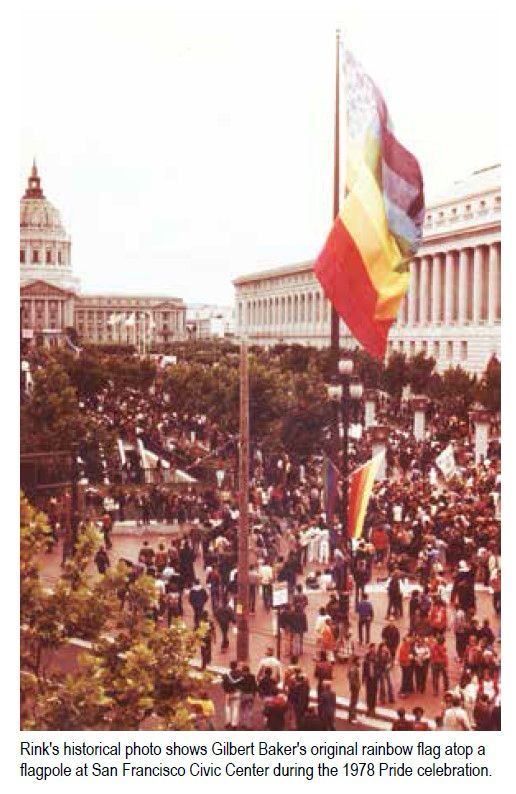
The First Flight of the Rainbow Flag at San Francisco Pride, 1978
This historic photograph captures a defining moment in LGBTQ+ history: the debut of the original rainbow flag at the San Francisco Civic Center during the 1978 Pride celebration. Designed by artist and activist Gilbert Baker, the original flag can be seen flying proudly atop a flagpole, its vibrant stripes rippling in the wind above the densely packed crowd below. With the stately dome of San Francisco City Hall visible in the background, the setting situates the moment firmly within a civic and political context—an important reminder that Pride has always been as much about visibility and protest as it is about celebration. The crowd stretches across the plaza, a sea of humanity unified in color, spirit, and purpose during a time when LGBTQ+ people were still largely marginalized and fighting for recognition and equal rights.
Baker’s original flag included eight stripes, each color assigned a specific meaning: pink for sex, red for life, orange for healing, yellow for sunlight, green for nature, turquoise for art, indigo for harmony, and violet for spirit. Unlike later versions of the flag, which often used six colors due to practical limitations in fabric dyeing, this initial design was rooted in symbolism, community expression, and radical joy. The image captures a grassroots movement beginning to take hold of its own iconography—declaring presence through color and claiming space in public life. The elevation of the flag itself mirrors the rising momentum of LGBTQ+ activism in the post-Stonewall era, reflecting not only resistance but resilience and pride. This moment, preserved on film, marks the birth of a symbol that would go on to unify communities across nations, signal safe spaces, and challenge societal norms through its very visibility. The image remains a visual cornerstone of queer history.

A Sea of Pride — Marching Beneath the Rainbow Banner
This vivid and electrifying photograph captures the exuberant spirit of a modern Pride parade, with thousands of people marching beneath a massive, undulating rainbow flag that stretches the entire width of a city street. Shot from above, the image offers a striking visual of coordinated community movement—an expression of collective visibility and joy. The rainbow fabric flows like a river through the urban canyon, its vibrant colors glowing in the sunlight. Red, orange, yellow, green, blue, and purple ripple in rhythm with the crowd’s energy, reinforcing the symbolic unity of diversity that the flag has come to represent. Participants of all ages, races, and gender identities walk together in solidarity, some carrying the flag, others raising their arms in celebration or snapping photos of the moment. Above them, apartment buildings and balconies are lined with onlookers and allies, reinforcing that this is not a fringe celebration—it is deeply rooted in the heart of the city.
This moment, while celebratory, is the culmination of decades of struggle. The flag they carry is the legacy of Gilbert Baker’s original 1978 design, now universally recognized as the symbol of LGBTQ+ pride and resilience. Each color represents more than a hue; it conveys an aspect of human experience and queer identity: life, healing, sunlight, nature, harmony, and spirit. In recent decades, the Pride flag has evolved to be even more inclusive, incorporating colors representing trans, nonbinary, intersex, and BIPOC communities—reminding us that the journey for justice is still ongoing. This image encapsulates both that progress and that purpose. It is not just a celebration of identity; it’s a living act of resistance and remembrance. The street becomes a stage, the flag a banner of defiance, love, and visibility, moving forward with every step, every beat, and every raised voice under its colors.

Gilbert Baker and the Birth of the Rainbow Flag
In this historically rich photograph, activist and artist Gilbert Baker stands proudly in front of an enormous rainbow flag—the original symbol he designed in 1978 that would become an enduring emblem of LGBTQ+ pride around the world. Dressed in a bright pink shirt, arms confidently crossed, Baker smiles as the massive flag unfurls behind him, held up by a long line of supporters. The image is both personal and political, capturing the joy, defiance, and artistry that Baker poured into his creation. The backdrop of a city street lined with parade-goers underscores the impact of Baker’s work, as what was once a grassroots design stitched by hand now stretches across entire blocks, waved by people who may not even know the name of its creator—but carry his legacy nonetheless.
The rainbow flag was not just a graphic statement; it was born out of urgent necessity. After the assassination of gay rights icon Harvey Milk and the rising backlash against queer communities, Baker sought a symbol that would unify and uplift. Inspired by movements of civil rights and social liberation, and steeped in his background as an artist and drag performer, he saw the rainbow as a spectrum that could include everyone. The first version had eight stripes, each with specific meanings: pink for sex, red for life, orange for healing, yellow for sunlight, green for nature, turquoise for magic, indigo for serenity, and violet for spirit. As production evolved, it was pared down to the six-color version more commonly used today, but its symbolic depth remained intact.
This photograph, though casual in composition, captures a watershed moment in cultural history. Baker’s smile radiates fulfillment, but the scale of the flag behind him reminds us of the collective effort it took to bring the LGBTQ+ movement into public consciousness. It’s a quiet portrait of revolution—one stitched in fabric, carried by many, and still rippling through time.

A River of Pride – The Rainbow Flag in Motion
This powerful image captures a sweeping overhead view of a massive Pride parade, where a giant rainbow flag stretches above the heads of thousands of marchers. Held aloft by a diverse and jubilant crowd, the fabric surges forward like a river of color, transforming the urban street into a living symbol of LGBTQ+ solidarity. People of all ages and backgrounds can be seen reaching up to support the flag, smiling and chanting as they move in unison. Taken from a high vantage point, the image captures both the scale and emotion of the moment, offering a visceral reminder of the sheer magnitude of global Pride celebrations. Cars line the edges of the packed street, swallowed in a sea of people, underscoring how the public realm has been fully claimed in joyful defiance.
This photo likely hails from São Paulo, Brazil, home to one of the world’s largest Pride parades. The rainbow flag here isn’t just decorative—it’s a statement of resistance, resilience, and identity. First flown on June 25, 1978, during San Francisco Pride, Gilbert Baker’s original rainbow flag has grown from a handmade symbol to a global emblem. Each color has a meaning: red for life, orange for healing, yellow for sunlight, green for nature, blue for harmony, and violet for spirit. In this image, those meanings breathe through the collective movement, animated by thousands who refuse invisibility.
This photograph immortalizes not only a flag in flight but a movement in motion. It affirms that Pride is more than a celebration—it is a demand for justice and dignity, stitched into every stripe and echoed in every raised hand.
On June 25, 1978, the rainbow flag was flown for the first time at San Francisco Pride. Designed by Gilbert Baker, the flag became a global symbol of LGBTQ+ identity, unity, and activism—redefining how movements use design to spark change.
#StayCurious #Skystorians #DiveIntoDiscovery
26.06.2025 02:32 — 👍 42 🔁 13 💬 1 📌 0
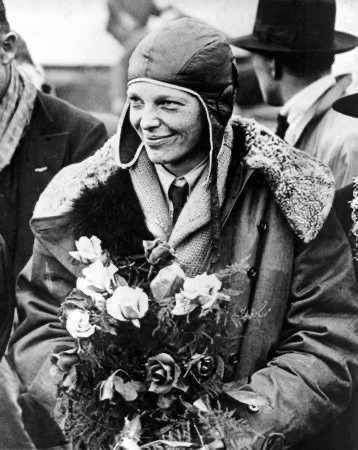
Amelia Earhart Celebrated After Her Transatlantic Solo Flight
In this historic black-and-white photograph, Amelia Earhart stands with a modest smile as she clutches a bouquet of roses. Clad in a heavy flight jacket, wool scarf, and her signature leather aviator cap, she is surrounded by well-wishers and onlookers, their faces turned toward the pioneering aviator in admiration. The image captures a moment of triumph shortly after Earhart’s groundbreaking solo transatlantic flight in May 1932—a daring 15-hour journey from Newfoundland, Canada, to a pasture in Northern Ireland. Her achievement was a milestone not only in aviation history but also in women’s rights, proving that women could match and surpass the feats of male aviators.
This photograph was likely taken during her return to the United States, where she was honored with widespread accolades and decorations. Most notably, on June 24, 1932, Earhart became the first woman awarded the Distinguished Flying Cross by the U.S. Congress, recognizing her courage and leadership in advancing aviation. At a time when women were expected to remain grounded—both figuratively and literally—Earhart took to the skies and rewrote the narrative. Her achievement made global headlines, inspiring generations of women to defy societal expectations and reach new heights.
The symbolic contrast between the flowers in her hand and the rugged aviation gear she wears reflects the dual image Earhart projected: grace paired with steel determination. This image thus not only commemorates a personal victory but also encapsulates a seismic cultural shift in public perception of women’s capabilities. Earhart didn’t just fly—she soared into history, earning her place not only in the sky but in the hearts of millions around the world.
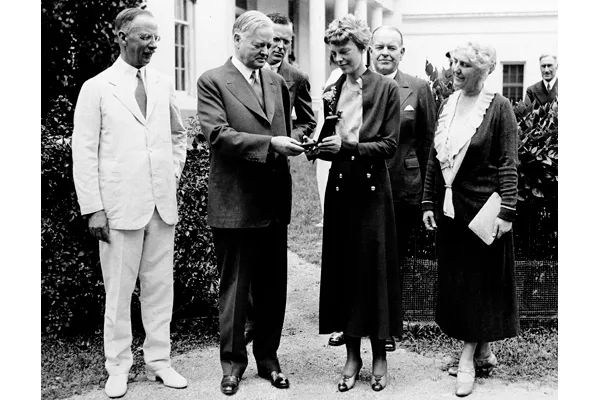
Amelia Earhart Receives the Distinguished Flying Cross from President Herbert Hoover
This historic black-and-white photograph captures a defining moment in Amelia Earhart’s storied career: the ceremonial presentation of the Distinguished Flying Cross by President Herbert Hoover on June 24, 1932. The scene is set outdoors on the White House lawn, with five individuals forming a semicircle of recognition around the famed aviator. At center, President Hoover, dressed in a dark suit, leans forward to present the medal to Earhart, who stands with quiet dignity, eyes lowered, and hands gently clasped to receive the honor. Her simple yet elegant attire—a tailored, double-breasted dress with buttons running down the front—underscores her practical nature and unassuming style, even as she makes history.
Surrounding them are Vice President Charles Curtis and First Lady Lou Hoover, joined by other dignitaries and aviation leaders, all bearing witness to this symbolic moment. The event marked the first time the Distinguished Flying Cross—a military decoration usually reserved for valor or achievement in aerial flight—was awarded to a woman. Earhart earned this recognition after completing her daring solo transatlantic flight on May 20–21, 1932, becoming the first woman to cross the Atlantic alone by air. Her flight not only mirrored Charles Lindbergh’s solo achievement five years earlier but surpassed it in difficulty due to poor weather and mechanical troubles.
This image speaks volumes about changing societal tides. Earhart’s presence at the White House was more than ceremonial—it was a statement of progress. In an era when female pilots were still rare and often doubted, Earhart shattered gender barriers with quiet confidence and unmatched courage. This moment helped cement her role as both an aviation pioneer and a cultural icon whose legacy would continue to inspire future generations of women in science, exploration, and leadership.
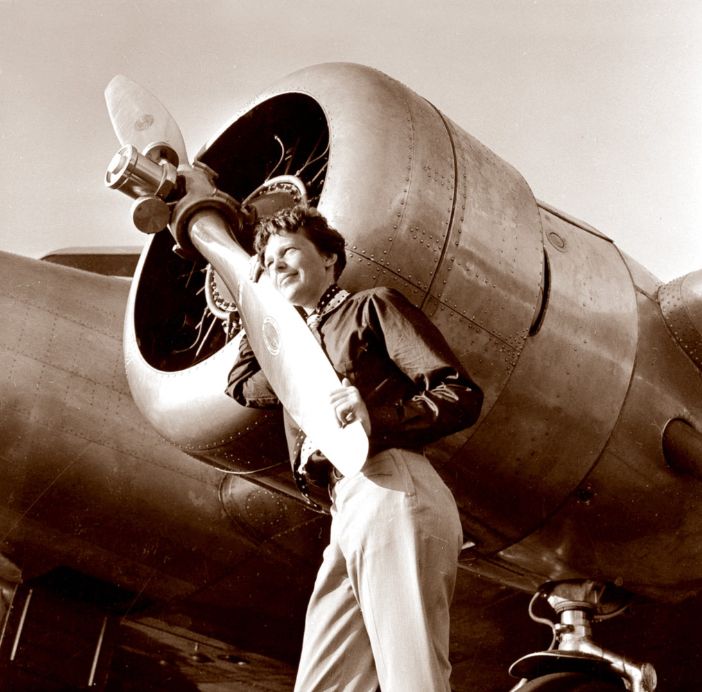
Amelia Earhart with Her Lockheed Electra – A Portrait of Pioneering Spirit
In this evocative sepia-toned photograph, Amelia Earhart is seen leaning affectionately against the propeller of her Lockheed Electra 10E, the aircraft she would later pilot during her final around-the-world attempt in 1937. The image captures not just a moment of calm before a great challenge but an enduring symbol of human ambition, technological progress, and personal resolve. Earhart, dressed in practical slacks and a buttoned-up blouse, gazes contentedly toward the horizon, her hand resting gently on the polished propeller blade. Her body language conveys deep familiarity with the machine behind her—an embodiment of the harmony she achieved between pilot and aircraft.
The Lockheed Electra, with its twin radial engines and advanced all-metal design, represented cutting-edge aviation technology of the 1930s. It was specially modified for Earhart’s ambitious circumnavigation of the globe, outfitted with extra fuel tanks and advanced navigation systems for long-distance flight. The aircraft’s engine cowling, propeller assembly, and meticulously riveted fuselage glisten in the sunlight, reflecting the industrial optimism of an age that looked skyward for its heroes. This photograph likely dates from 1936 or early 1937, during Earhart’s meticulous preparations for the historic journey that would ultimately end in mystery and international fascination.
Amelia’s serene expression and relaxed posture reveal her deep confidence and passion for flight, even in the face of looming uncertainty. As one of the most famous aviators of her era, Earhart’s relationship with her aircraft symbolized the possibilities that aviation offered for transcending gender roles, geographical limits, and societal expectations. Her pioneering efforts not only broke records but inspired millions—this image freezes one such moment of inspiration in time, reminding us of the boldness it takes to reach for the unknown.
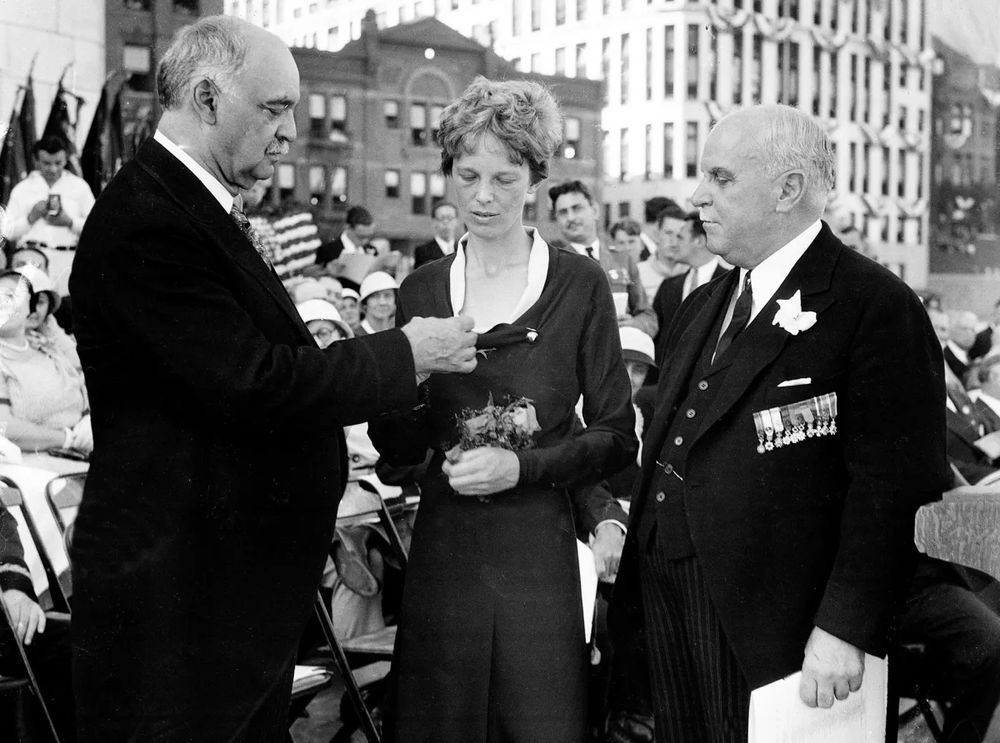
Honoring a Legend – Amelia Earhart Receives the Distinguished Flying Cross :
A Milestone in Aviation and Gender Equality
This evocative historical image captures Amelia Earhart standing with quiet poise as she receives the Distinguished Flying Cross on June 24, 1932—a moment that cemented her status as a pioneering force in aviation. Dressed modestly and holding a bouquet of flowers, Earhart is flanked by officials and onlookers as a dignitary pins the medal to her chest. This scene commemorates her record-setting solo transatlantic flight and marks the first time a woman received the prestigious honor, awarded by the U.S. Congress for extraordinary achievement in aerial flight. Just a month earlier, on May 20–21, 1932, Earhart had flown alone across the Atlantic from Newfoundland to Northern Ireland in 14 hours and 56 minutes, piloting a Lockheed Vega 5B. She became not only the first woman but only the second person in history to complete such a journey, following Charles Lindbergh.
The crowd surrounding her reflects both awe and respect—a mix of military figures, civic leaders, and members of the public gathered to witness the recognition of a groundbreaking accomplishment. Earhart’s calm, introspective expression seems to transcend the moment, as if she’s already thinking ahead to future adventures. The medal ceremony, though brief, stands as a cultural landmark, symbolizing not only personal courage and technical skill but also the broader evolution of women’s roles in society. This image memorializes a point in time when one woman’s flight helped shift public perception and inspired generations to aim higher—both literally and figuratively.
On June 24, 1932, Amelia Earhart became the first woman awarded the Distinguished Flying Cross. The honor recognized her historic solo transatlantic flight, cementing her as a global aviation icon and symbol of women’s achievement.
#StayCurious #Skystorians #DiveIntoDiscovery
25.06.2025 02:01 — 👍 21 🔁 6 💬 0 📌 0
Pluto will always be a real planet in our hearts 😂❤️
25.06.2025 01:46 — 👍 0 🔁 0 💬 0 📌 0
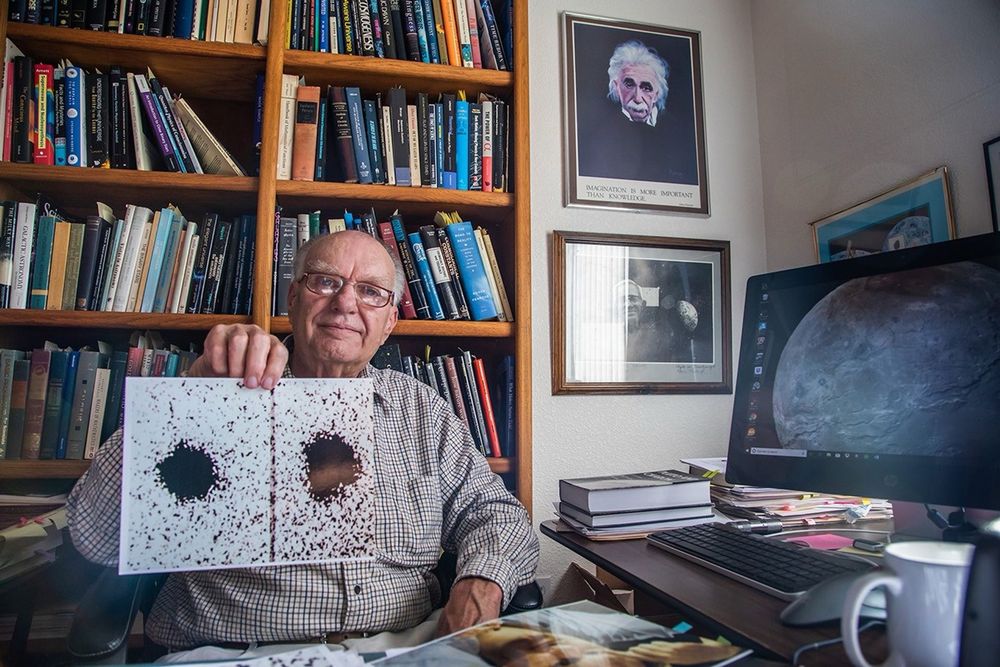
James Christy and the Discovery of Charon – A Breakthrough in Outer Solar System Astronomy
This image captures American astronomer James Christy proudly displaying the photographic plates that led to his 1978 discovery of Charon, Pluto’s largest moon. Seated in his office at the U.S. Naval Observatory in Flagstaff, Arizona, Christy is surrounded by shelves of astronomical texts and scientific journals, a reflection of decades of celestial research. On the wall behind him hangs a portrait of Albert Einstein, symbolic of the scientific legacy Christy contributed to with his revelation. The photograph he holds shows two distinct images of Pluto, one slightly elongated—evidence of an accompanying satellite. This subtle bulge, first dismissed as a photographic artifact, was scrutinized by Christy, who hypothesized that Pluto’s image wobble indicated the gravitational presence of a moon. His insight was confirmed on June 22, 1978, revolutionizing the understanding of Pluto as a binary planetary system.
Charon’s discovery was not only remarkable for its location at the fringes of the solar system but also for what it revealed about planetary classification, orbital dynamics, and moon formation. Christy’s work laid the foundation for subsequent missions, including NASA’s New Horizons flyby in 2015, which captured detailed images of Charon’s surface. The find significantly impacted Pluto’s fate as well; the realization that Pluto and Charon orbit a barycenter outside of Pluto itself played a key role in its 2006 reclassification from a planet to a dwarf planet. This image of Christy bridges the personal and the astronomical—his modest smile underscoring a moment when quiet observation reshaped planetary science. Through one man’s persistence and a few specks on a photographic plate, an entire world came into clearer view.

Tracking Charon – From Blurry Specks to Planetary Precision
This composite image showcases the evolution of Charon’s visibility—from an indistinct blur to a fully resolved celestial body—demonstrating humanity’s growing capacity to peer into the distant reaches of the solar system. On the left, a 1930 telescope image shows a faint circle around Pluto, taken the same year Clyde Tombaugh discovered the dwarf planet. At the time, no one knew Pluto had a moon; the image’s resolution was too limited to reveal more. In the center, the 1978 photograph that led to the official discovery of Charon is presented. The red circle highlights a bulge—subtle yet consistent in repeated exposures—observed by James Christy, who noticed Pluto’s “odd shape” during routine analyses at the U.S. Naval Observatory. Christy’s persistence, aided by advances in photographic techniques and timing, confirmed that the bulge was not a defect but a companion moon orbiting Pluto. This pivotal moment transformed our view of Pluto from a lone wanderer to a binary planetary system.
The third and most striking image on the right comes from NASA’s New Horizons spacecraft, which flew past Pluto and Charon in July 2015. It reveals a heavily cratered, complex world with distinct geological features and reddish surface hues—suggesting ancient collisions, possible cryovolcanism, and a dynamic history. With this side-by-side visual comparison, the composite illustrates nearly a century of technological progress: from ground-based telescopic limitations to space-based precision imaging. More than a testament to Charon itself, the image reflects the story of scientific patience, layered discovery, and the transformative power of evolving observation tools. Charon, once a ghostly distortion, now stands as a major figure in planetary science—its journey from photographic anomaly to mapped terrain is one of astronomy’s most rewarding detective stories.

Pluto and Charon – A Binary System Revealed
This vivid color-enhanced image captures Pluto and its largest moon, Charon, in unprecedented detail, revealing not only their striking surface differences but also their unique gravitational relationship. Captured by NASA’s New Horizons spacecraft during its historic flyby in July 2015, the image illustrates one of the most unusual pairings in the solar system. Pluto, the larger body in the foreground, displays a diverse and dynamic surface with deep red and orange hues, likely caused by tholins—complex organic molecules formed when solar radiation interacts with methane and nitrogen in Pluto’s atmosphere. A massive heart-shaped plain known as Sputnik Planitia dominates its face, hinting at active geology, possible subsurface oceans, and atmospheric processes.
In contrast, Charon appears in the background with a muted, greyish tone, marked by dark patches near its poles and a network of ridges, fractures, and impact craters. Despite its smaller size—roughly half Pluto’s diameter—Charon’s mass is significant enough that the center of gravity between the two bodies, or barycenter, lies outside of Pluto itself. This makes Pluto-Charon a binary system rather than a traditional planet-moon configuration, a distinction that played a role in debates about Pluto’s planetary status and its eventual reclassification as a dwarf planet in 2006.
The two bodies are tidally locked, meaning the same sides always face each other, adding to their mystique. This image helped scientists understand more about planetary formation, surface evolution, and the complex interplay between celestial bodies in the distant Kuiper Belt. It also symbolized a triumph of long-range exploration, as New Horizons revealed not only what Pluto and Charon look like, but also how rich and surprising the outer solar system can be—redefining our concept of what constitutes a planetary system.

Mapping Charon – Unveiling the Surface of Pluto’s Mysterious Moon
This annotated image of Charon, Pluto’s largest moon, showcases key geological features revealed by NASA’s New Horizons spacecraft in 2015. Prior to this mission, Charon was barely pixel in telescopic images. But as New Horizons sped past the Pluto system, it captured stunning views of Charon’s rugged terrain, bringing this distant satellite into sharp scientific focus for the first time in human history. The left side of the image displays a view of Charon’s sunlit hemisphere, while the right includes labels identifying prominent features, such as probable impact craters, possible chasms, and a darkened polar region at the top
The dark north polar area, informally nicknamed “Mordor Macula,” is thought to be formed by tholins—organic molecules created when methane escapes Pluto’s atmosphere and freezes onto Charon, later altered by ultraviolet radiation. The visible chasms and fractures, including features like Serenity Chasma, suggest tectonic activity and support the idea that Charon may once have harbored a subsurface ocean that froze and expanded, cracking its outer ice shell. These tectonic features run for hundreds of kilometers, far longer than the Grand Canyon on Earth, hinting at a dynamic past
Charon’s surface, heavily cratered in parts, tells a story of billions of years of cosmic impacts and geologic processes. Unlike Pluto’s relatively youthful terrain, which shows signs of recent activity, Charon’s more ancient and battered crust suggests a body that has been geologically quiet for much of its existence
This reshaped scientific thinking about icy moons and dwarf planets. It highlighted how even remote bodies in the Kuiper Belt could be geologically complex and geochemically active. Reinforcing the significance of planetary missions in uncovering the secrets of the outer solar system, showing that even moons can deepen our understanding of planetary evolution and celestial mechanics
On June 22, 1978, Charon, Pluto’s largest moon, was officially discovered by astronomer James Christy. This finding transformed how scientists studied distant planetary systems and eventually helped justify Pluto’s reclassification as a dwarf planet.
#StayCurious #Skystorians #DiveIntoDiscovery
23.06.2025 03:43 — 👍 12 🔁 2 💬 2 📌 1
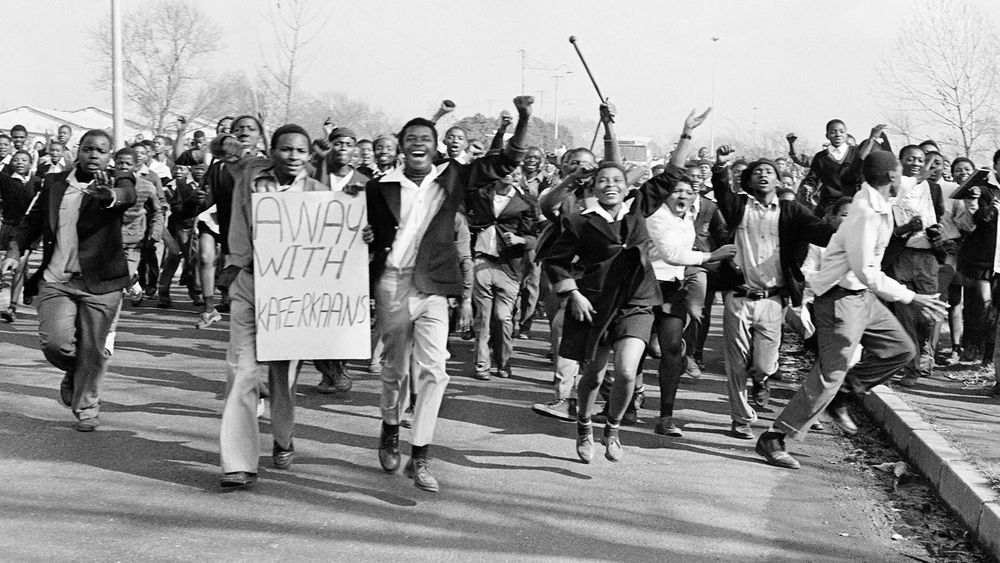
“Away with Afrikaans” – Youth Resistance During the Soweto Uprising
In this powerful black-and-white photo, a large crowd of South African students marches forward with determination and urgency during the Soweto Uprising of 1976. At the forefront, a young man holds a handmade sign reading “AWAY WITH KAAFERKAANS,” a direct protest against the apartheid government’s policy enforcing Afrikaans as a medium of instruction in schools. The faces of the students are filled with resolve, many raising clenched fists—a global symbol of resistance. They wear school uniforms, linking their protest to the educational system they are resisting. The movement is dynamic; the students are in mid-motion, some shouting, others gesturing, their unity palpable as they occupy the street. Behind them, a sea of young protestors stretches into the distance, underscoring the widespread outrage felt across Soweto and beyond. The image captures the early days of what would become a pivotal anti-apartheid movement, sparked on June 16 and continuing through the weeks that followed, including June 20. This image reflects the historical significance of youth activism, the brutality of state oppression, and the symbolic rejection of cultural erasure. The photo has become one of the most iconic visual records of defiance during apartheid, encapsulating the courage and conviction of a generation that challenged one of the most oppressive systems of the 20th century. Their stand laid the moral groundwork for international condemnation of apartheid and galvanized solidarity movements around the globe.

Hands Raised in Defiance – Confronting Apartheid Power
This striking black-and-white photograph captures a tense and heartbreaking moment from the Soweto Uprising. Two young Black South African men are seen kneeling on the grass with their hands raised in surrender, directly facing a white South African security officer who is leaning out of a vehicle, weapon aimed. The young men’s expressions are unreadable from the photo’s angle, but their posture—arms lifted in submission, knees grounded—is a haunting depiction of vulnerability under authoritarian force. Behind them, a crowd of onlookers looms in the background, their presence simultaneously witness and silent protest. This image speaks volumes about the brutal power imbalance that characterized apartheid South Africa. The act of raising hands, a universal gesture of “don’t shoot,” becomes here a chilling symbol of systemic violence and the cost of peaceful protest. Taken during the escalation of demonstrations that followed the June 16, 1976 massacre, including events on June 20, it highlights the militarized response of the apartheid regime to youth-led demands for justice and education. The uniformed soldier, partially shielded by the vehicle’s open door, represents a faceless state apparatus—mechanized, impersonal, and lethal. The stark contrast between the young men’s simple clothing and the soldier’s gear emphasizes the imbalance of force. This photograph encapsulates not only the terrifying risks protestors faced, but also their defiant courage. It serves as a historical reminder of how movements are met with resistance—and how even unarmed voices can rise to confront institutionalized oppression. The image is both a document of injustice and a testament to resilience.

A Tide of Resistance – The March of Soweto’s Youth
This powerful black-and-white photograph captures an immense procession of Black South African students and youth marching in unison during the Soweto Uprising of June 1976. Taken from a frontal angle, the image shows thousands of demonstrators moving resolutely down a wide street, their faces serious, focused, and unafraid. In the front row, several young men walk shoulder to shoulder, leading the march with signs held high. One placard pleads: “KRUGER PLEASE DETAINEES CRIES,” referencing South African Minister of Police Jimmy Kruger and the brutal detainment and torture of students following the June 16 massacre. The scale of the demonstration is staggering; the crowd stretches into the distant horizon, creating a wave-like impression of relentless determination. This march likely took place on or around June 20, during the sustained protests that followed the initial killings by police. What began as a school walkout against the forced instruction of Afrikaans rapidly became a nationwide rebellion against the entire apartheid system. The orderly defiance of this image contrasts starkly with the violence these students would soon face. There are no weapons here—only resolve. The photograph evokes the spirit of youth-led civil disobedience, echoing movements around the world yet grounded in the specific brutality of apartheid. Every face in the crowd is part of history: children turned freedom fighters, armed only with voices, signs, and the will to be heard. This image embodies the raw courage and unified resistance that turned Soweto into a symbol of revolution and lit a fire that would burn through the decades until apartheid’s end. It is a visual record of humanity’s fight for dignity, one step at a time.

Brutal Repression – Police Crackdown During the Soweto Uprising
This harrowing black-and-white image captures the violent clash between apartheid police forces and Black South African protesters during the height of the Soweto Uprising in June 1976. In the foreground, uniformed officers wielding batons and rifles strike at a fleeing crowd, enveloped in a chaotic cloud of dust and panic. The officers, some mid-swing, wear helmets and boots, moving aggressively through a sea of civilians—many of whom appear to be students and bystanders caught in the melee. Their raised weapons and hostile posture contrast with the defenselessness of the people they attack, some of whom are on the ground, while others attempt to shield one another or retreat. In the background, the crowd stretches deep into the frame, underscoring the massive scale of the demonstration and the indiscriminate nature of the crackdown. This scene is emblematic of the state’s response to the uprising, which began on June 16, 1976, as a peaceful protest by schoolchildren against the enforced use of Afrikaans in Black schools. The government’s brutal suppression—resulting in the deaths of hundreds of students and the injury of thousands—marked one of the most traumatic turning points in South African history. This image lays bare the grim reality of apartheid-era policing, where armed force was used not just to maintain order, but to uphold a system of racial domination. The photograph stands as a visual indictment of institutional violence, reminding us of the cost of justice and the resilience of those who fight for it. In this image, the dust does not merely obscure—it becomes a symbol of erasure, resistance, and the long shadow of state-sanctioned brutality.
On June 20, 1976, the Soweto Uprising escalated in South Africa as students protested apartheid education laws. Facing brutal repression, their courage sparked global solidarity and became a turning point in the anti-apartheid struggle.
#StayCurious #Skystorians #DiveIntoDiscovery
20.06.2025 22:39 — 👍 36 🔁 9 💬 0 📌 0
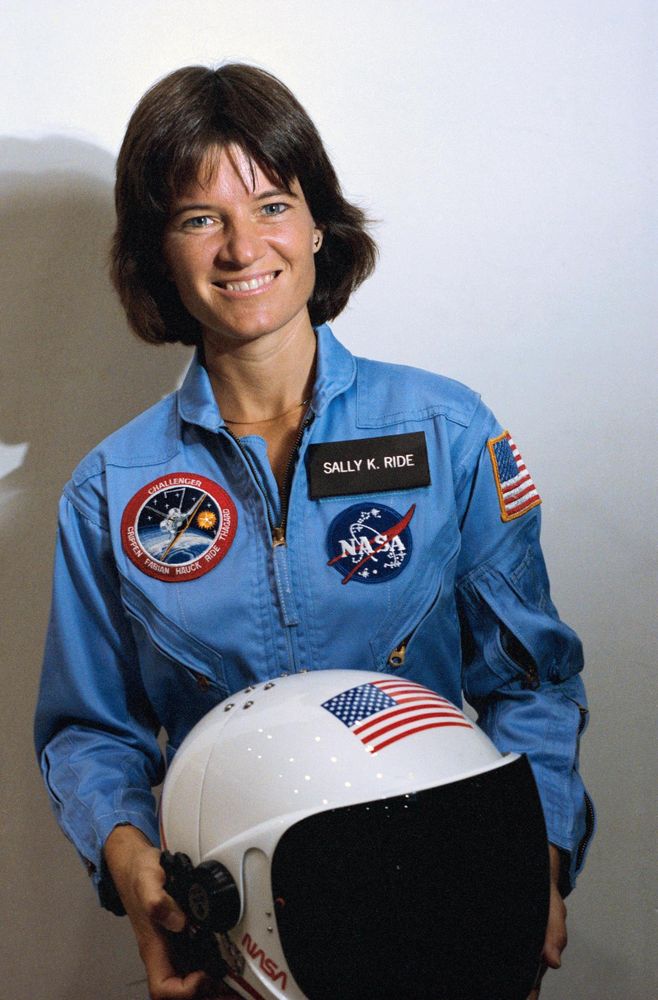
Sally Ride – Breaking Barriers Beyond Earth
This image captures a defining moment in American space history: astronaut Sally Ride, standing proudly in her NASA uniform and holding her white helmet adorned with the U.S. flag. Taken shortly before her pioneering mission aboard the Space Shuttle Challenger on June 18, 1983, the photo immortalizes Ride as the first American woman in space. Her uniform, with the STS-7 mission patch prominently displayed, symbolizes a milestone not just in NASA’s legacy but in the broader arc of gender equality in science and engineering. Her confident smile reflects the spirit of a trailblazer stepping into the unknown, representing not only her crew but the aspirations of countless women and girls previously excluded from the space race narrative.
Ride’s mission aboard Challenger lasted six days, during which she helped deploy communications satellites and conducted science experiments using the shuttle’s robotic arm. But her impact extended far beyond the mission’s technical successes. At a time when aerospace was dominated by men, her selection and flight proved that women could perform equally in the rigors of spaceflight—shattering lingering stereotypes within the military-industrial complex, academia, and public imagination.
In the years that followed, Sally Ride became an outspoken advocate for science education and equality in STEM fields. She founded Sally Ride Science to inspire young students, particularly girls, to pursue careers in science and engineering. This image, often used in classrooms and media retrospectives, continues to resonate as a symbol of courage, excellence, and representation. It is not just a portrait of one astronaut—it is an emblem of a turning point in space history and the ongoing journey toward inclusivity and innovation.

STS-7 Crew in Orbit – Teamwork Aboard Challenger
This image offers an intimate look inside the Space Shuttle Challenger during its historic STS-7 mission in June 1983. At the center foreground is Sally Ride, the first American woman in space, surrounded by her fellow crew members—Robert Crippen, Frederick Hauck, John Fabian, and Norman Thagard. The five astronauts, dressed in their navy NASA flight suits, are seen floating in zero gravity, smiling for the camera amid a backdrop of intricate switches, displays, and flight panels inside the shuttle’s flight deck. The camaraderie captured in their expressions reflects the spirit of collaboration and trust that defines successful space missions.
Launched on June 18, 1983, STS-7 was a landmark mission in many ways. It marked not only a critical advancement in U.S. crewed spaceflight but also demonstrated how diverse teams could thrive in high-stakes scientific environments. Ride operated the shuttle’s Canadarm to deploy and later retrieve satellites, solidifying the role of robotic technology in shuttle operations. The STS-7 mission also carried experiments designed to study the effect of space travel on various materials and biological samples, pushing forward both commercial and academic research.
The setting is rich with detail—overhead panels, communication headsets, floating pill containers—all representing the controlled chaos of life in orbit. Though visually informal, this captures a powerful message: the future of exploration depends on teamwork, adaptability, and breaking barriers. For many, it became the visual embodiment of NASA’s gradual shift toward inclusivity, not only welcoming women but preparing for a more collaborative and scientifically driven space program.
The mission ended safely on June 24, but its influence is ongoing. This photo, often featured in documentaries and educational materials, is more than just a snapshot of a crew—it’s a time capsule of a transformative era in human spaceflight.

Sally Ride’s Official NASA Portrait – Breaking Ground, Inspiring Generations
This formal NASA portrait of Dr. Sally Ride captures one of the most iconic figures in space exploration history at a defining moment in her career. Posed in front of the American flag, Ride wears her STS-7 flight uniform, complete with mission patches and NASA insignia. Her calm, confident expression and relaxed posture subtly reflect both her pioneering spirit and the gravity of her achievement. To her side is a scale model of the Space Shuttle, the very spacecraft that launched her into history on June 18, 1983, as the first American woman to travel into space.
The symbolic elements of the photo—flag, shuttle model, and official attire—reinforce the national significance of her journey, which occurred during a time of profound cultural and technological transformation in the United States. Her STS-7 mission aboard the Challenger wasn’t just about satellite deployment or orbital experiments; it was about redefining who could be an astronaut. Until that point, space had been largely male-dominated. Ride’s inclusion on the crew, following rigorous training and academic excellence in physics, shattered that mold and opened doors for generations of women and underrepresented groups in STEM.
Ride also became a symbol of quiet resilience. She was known for her intellect, humility, and laser focus, often avoiding the media frenzy that followed her historic flight. After her time at NASA, she continued to advocate for science education, founding Sally Ride Science to inspire young people—especially girls—to pursue scientific careers.
This portrait, widely distributed in newspapers, museums, and classrooms, is more than an official photo—it’s an image of legacy. It reminds viewers of the human face behind technological triumphs and speaks to the power of representation. For many, especially young women looking to the stars, this image of Sally Ride wasn’t just aspirational—it was revolutionary

Sally Ride Aboard the Challenger – Inside the Orbiter That Changed History
This photo captures astronaut Dr. Sally Ride mid-mission aboard the Space Shuttle Challenger during STS-7 in June 1983. Ride is pictured floating effortlessly in zero gravity, her hair slightly raised and a headset attached—signs of the weightless environment and her active communication duties. She holds onto a drink pouch and appears relaxed yet focused, fully immersed in the rhythm of life in orbit. Surrounding her are panels filled with switches, wires, data pads, and flight manuals—a complex and controlled chaos that defines the working quarters of a space shuttle mission.
This moment in the cockpit encapsulates the groundbreaking significance of Ride’s presence. As the first American woman in space, her participation aboard Challenger didn’t merely represent a gender milestone; it symbolized the evolving future of spaceflight. Her responsibilities on the mission included operating the shuttle’s robotic arm (Canadarm), which she used to deploy satellites—an extraordinary technical task requiring precision and calm under pressure.
The reflects the human side of space exploration—the adaptability, collaboration, and trust in each crew member’s ability, regardless of gender. It was a quiet rebuttal to years of skepticism about women in space, especially in operational and command roles. Ride’s confident presence amid such a high-tech, high-stakes environment helped reshape the perception of what an astronaut looked like.
More than just a scientific pioneer, Ride became a role model for generations. This image—her body language, professionalism, and seamless integration with her male colleagues—embodies the normalization of diversity in elite scientific spaces. It served as an inspiration not only to aspiring astronauts but also to young scientists, engineers, and dreamers everywhere.
This photo reminds us that space exploration is as much about who we send as it is about where we go.
On June 18, 1983, Sally Ride became the first American woman in space aboard the Space Shuttle Challenger. Her historic flight not only broke gender barriers in STEM but also inspired a new generation of scientists and explorers.
#StayCurious #Skystorians #DiveIntoDiscovery
18.06.2025 22:57 — 👍 41 🔁 7 💬 2 📌 0
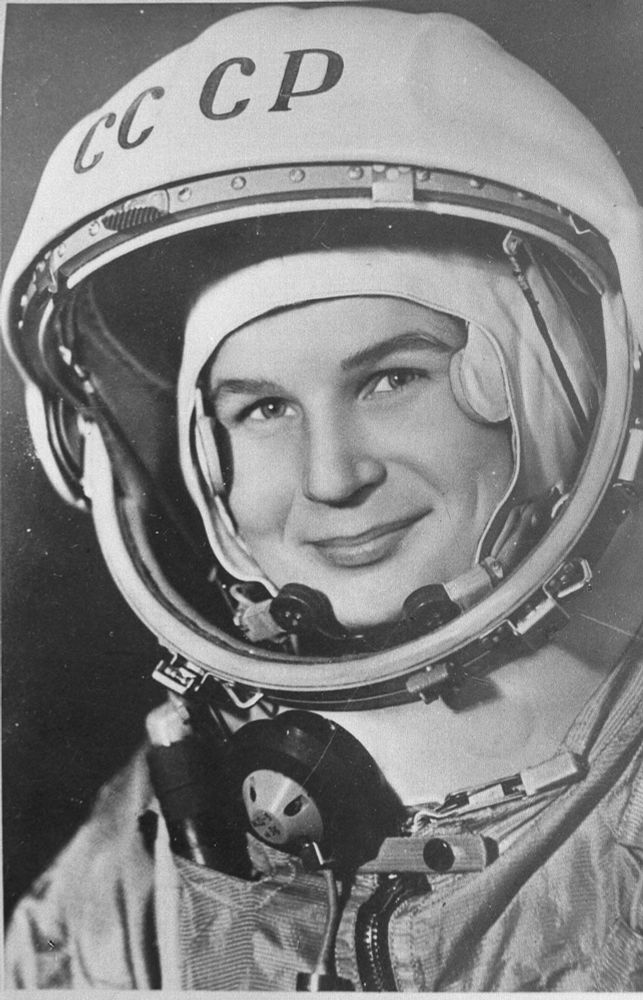
Valentina Tereshkova in Cosmonaut Suit – A Pioneering Moment in Space History
This iconic black-and-white photograph captures Valentina Tereshkova, the Soviet cosmonaut who became the first woman in space, smiling proudly in her flight suit and helmet marked “СССР” (USSR). Taken in 1963, the image commemorates the launch of Vostok 6 on June 16 of that year, a mission that lasted nearly three days and marked a pivotal moment in both space exploration and the global perception of women’s capabilities. Tereshkova, a former textile factory worker and amateur parachutist, was selected from more than 400 applicants to make this historic flight, not merely as a symbolic gesture but as a rigorous scientific endeavor. Her mission placed the USSR ahead of the United States in the space race once again—this time in gender inclusion.
The simplicity and clarity of the photograph contrast with the technical complexity of her achievement. The helmet, lined with communication equipment and sealed for spaceflight, reflects the utilitarian design of early Soviet space gear. Her composed expression belies the intensity of the training she underwent, including weightlessness simulations and isolation tests. Tereshkova manually operated the spacecraft, recorded physiological data, and kept detailed mission logs—essential contributions to the study of human endurance in space.
More than just a Soviet hero, Tereshkova became an international icon of gender equality and scientific advancement. Her flight shattered assumptions about the limitations of women in extreme environments and opened doors for future generations of female astronauts. Her legacy endures today not only in Russia, where she was named a Hero of the Soviet Union, but also globally, as a trailblazer whose journey redefined the boundaries of who could represent humanity in the cosmos.
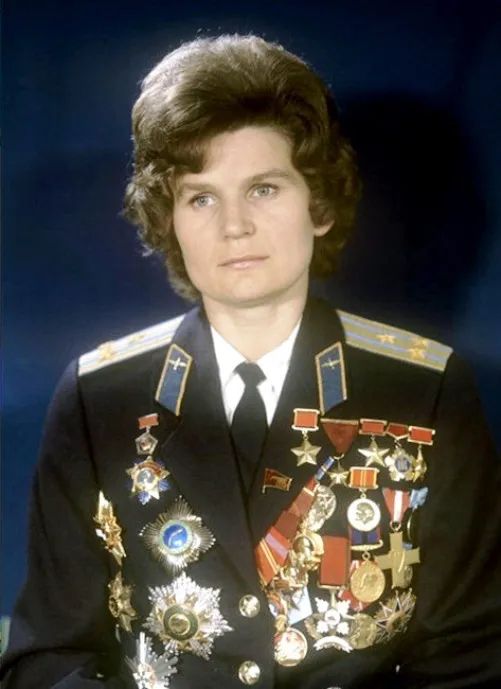
Heroine of the Cosmos – Valentina Tereshkova Decorated with Honors
This striking color photograph features Valentina Tereshkova, the first woman in space, wearing a formal military uniform adorned with an impressive collection of medals, ribbons, and Soviet insignia. Captured in the years following her groundbreaking 1963 mission aboard Vostok 6, this portrait underscores how Tereshkova’s historic spaceflight transcended scientific achievement and became a defining symbol of national pride, ideological triumph, and global inspiration. Her stoic expression and polished appearance reflect the dual role she assumed in the aftermath of her flight—both as a cosmonaut and as a celebrated political and cultural figure within the Soviet Union.
Prominently displayed on her uniform are the Hero of the Soviet Union medal and the Order of Lenin, two of the highest honors awarded by the USSR. These decorations recognize not only her bravery in venturing into space at just 26 years old, but also her significance as a symbol of gender progress in a world where female astronauts were still decades away in other nations. The photograph captures a moment when Tereshkova was no longer merely a cosmonaut, but a state icon, used in Soviet propaganda to promote the ideal of gender equality under communism.
Yet the image also conveys personal accomplishment. Tereshkova came from humble beginnings—raised in a working-class family and employed in a textile mill before becoming a paratrooper and eventually a cosmonaut. Her rise to global prominence was a remarkable example of upward mobility through merit and state sponsorship, illustrating the USSR’s emphasis on showcasing its social and scientific superiority during the Cold War.
Beyond Soviet borders, Tereshkova became a global figurehead for women in science and leadership, eventually serving in prominent political roles. She later came to represent in the ongoing fight for equity, representation, and space exploration.
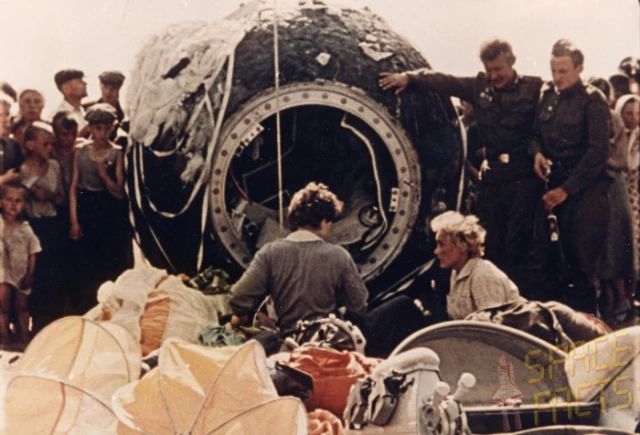
Touchdown of Vostok 6 – The Return of the First Woman in Space
This rare, colorized photograph captures the immediate aftermath of the landing of the Vostok 6 capsule, which carried Valentina Tereshkova safely back to Earth on June 19, 1963. Surrounded by curious villagers and uniformed military personnel, the spherical descent module sits scorched and battered, a testament to its fiery re-entry into Earth’s atmosphere. Parachutes and equipment are strewn around the scene, and a small group, including Tereshkova herself, appears to be recovering gear and inspecting the landing site in a moment that blends both triumph and fatigue.
After orbiting Earth 48 times over nearly three days in space, Tereshkova made a manual re-entry and ejected from the capsule shortly before touchdown—parachuting to the ground near a rural area in the Altai region of Siberia. This was standard procedure for the Vostok program, whose capsules were not designed to land with the cosmonaut still inside. The landing took locals by surprise. According to accounts, Tereshkova’s sudden appearance in a flight suit and helmet alarmed residents until she calmly explained she had come from space. She was offered milk and bread by the villagers, underscoring the surreal intersection between high technology and rural life.
This image is more than a snapshot of a landing—it is a visual testament to the full arc of a mission that shattered barriers. Tereshkova’s return to Earth completed the journey of the first woman in space, proving that gender posed no biological obstacle to space travel. The Soviet Union used the event to trumpet its progressiveness and scientific superiority on the world stage. Yet for all the geopolitical significance, this image grounds the story in something human: a young woman emerging from a metal sphere in a field, met by ordinary people whose lives would never reach orbit, but who bore witness to someone who had.
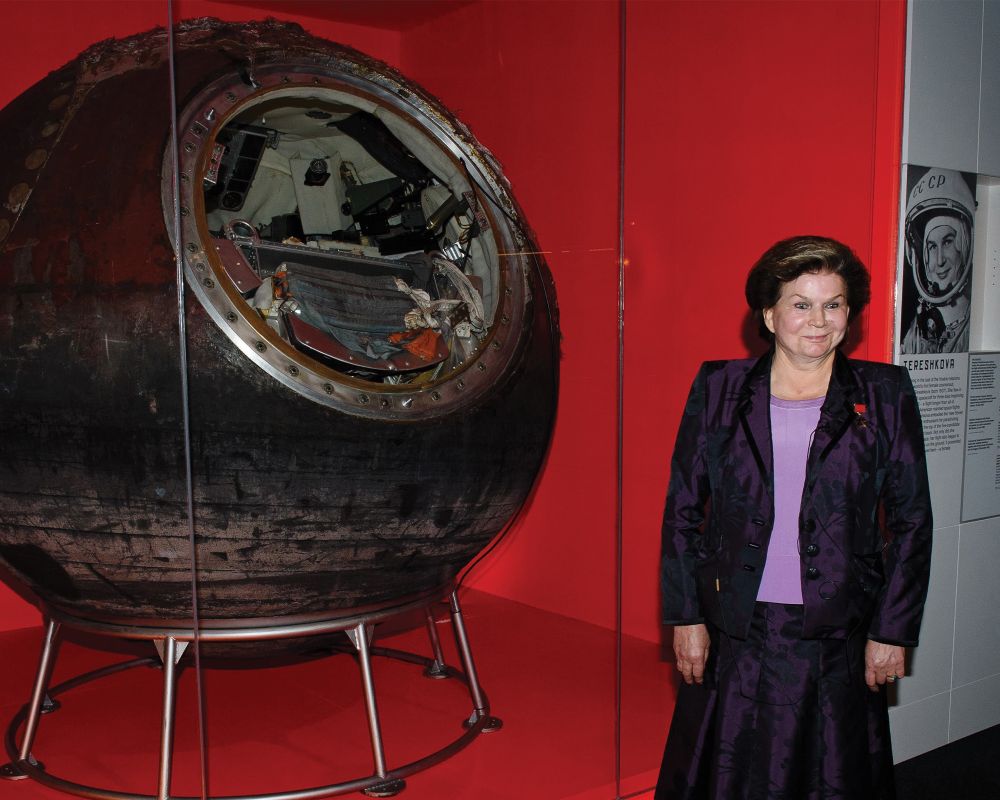
Legacy and Artifact – Valentina Tereshkova and the Vostok 6 Capsule
In this photograph, Valentina Tereshkova, now an older woman and decorated veteran of space history, stands proudly beside the very spacecraft that made her a global icon: the Vostok 6 descent module. Encased in a museum display and scorched black from atmospheric reentry, the spherical capsule bears the wear of one of the most historic journeys in space exploration. Its compact interior is visible through the open hatch, revealing the cramped, utilitarian design of early Soviet spacecraft. Tereshkova, dressed in a formal plum-colored suit, smiles gently—embodying both dignity and quiet pride—as she poses before the vessel that launched her into history on June 16, 1963.
This moment is more than a reunion with an artifact; it is a meeting of legacy and memory. The Vostok 6 capsule represents a pivotal era when the Soviet Union competed fiercely in the Space Race, and Tereshkova’s mission was a major geopolitical and cultural milestone. She became not only the first woman in space, but also the only woman to fly solo in orbit—a feat unmatched to this day. Her mission challenged entrenched gender roles and sparked global conversations about women’s roles in science and engineering.
The juxtaposition of Tereshkova and the capsule decades after the flight emphasizes the endurance of her legacy. It reflects how pioneers in space exploration are not merely participants in scientific milestones but also powerful symbols of human potential, courage, and change. The exhibit surrounding her includes a poster with her flight portrait and name in Cyrillic script, underscoring her continued reverence in Russian memory and global history. Today, her flight is remembered not just as a Cold War achievement, but as a human story of aspiration, resilience, and the determination to reach beyond what had previously been deemed possible.
On June 16, 1963, Soviet cosmonaut Valentina Tereshkova became the first woman in space aboard Vostok 6. Her groundbreaking mission shattered gender barriers and proved that women could endure the rigors of space travel, decades ahead of many nations.
#StayCurious #Skystorians #DiveIntoDiscovery
16.06.2025 21:23 — 👍 55 🔁 15 💬 1 📌 1
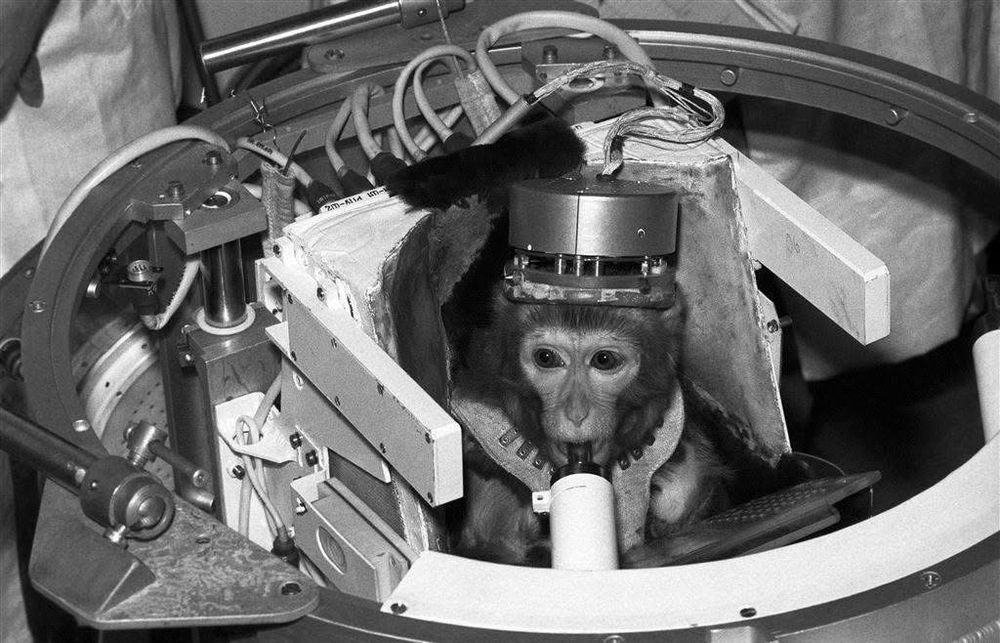
Albert II – The First Primate in Space and the Price of Progress
A haunting yet historic milestone in the story of space exploration: the moment before launch for Albert II, a rhesus macaque, who became the first primate to travel to the edge of space on June 14, 1949. Strapped into a complex restraint system inside a repurposed U.S. V-2 rocket, Albert II was part of a groundbreaking mission orchestrated by American scientists seeking to understand how the human body might withstand spaceflight. While fruit flies and mice had already made suborbital trips, Albert II represented a new phase—testing the biological responses of primates, whose physiological similarities to humans offered more reliable predictions.
The image shows the rhesus monkey secured in a custom capsule, surrounded by a tangle of analog wires and metal brackets. His small frame, fitted with biomedical sensors, is confined within a pressurized aluminum shell lined with padding. A breathing apparatus rests near his mouth—essential for the simulated atmospheric conditions he would encounter. Scientists hoped to measure respiration, heart rate, and neurological function under extreme G-forces and microgravity.
Launched from White Sands Missile Range in New Mexico, Albert II reached an altitude of 83 miles, officially crossing the Kármán line and becoming the first living mammal in space. Unfortunately, while the flight itself was a success, a parachute failure during reentry caused the capsule to crash, killing Albert II on impact. His sacrifice, however, was not in vain. Data gathered from the flight laid critical groundwork for future missions, including those of Alan Shepard and Yuri Gagarin over a decade later.
This moment encapsulates the early tensions of the space race—scientific ambition shadowed by ethical dilemmas. While Albert II never returned to Earth alive, his name lives on in aerospace history as a symbol of the many unsung non-human pioneers who helped humans reach the stars.

Preparing Albert II’s Capsule – Engineering the Edge of Life
This powerful image captures a pivotal and sobering behind-the-scenes moment in the development of space biology: the engineering preparation of Albert II’s capsule before his historic 1949 flight. Two technicians—members of the U.S. Army medical and aeronautical research teams—are shown handling the life-support system and containment chamber designed to carry the rhesus monkey into space. Their expressions reflect both focused precision and the weight of responsibility. This was no ordinary test; the experiment would push the boundaries of life as it was known at the time.
The capsule in their hands is a compact, cylindrical steel and aluminum container, rigged with an internal framework of padded restraints, biometric sensors, and a breathing system. One technician holds the pressure-sealed inner housing—designed to protect Albert II from the vacuum of space—while the other examines the structural integrity of the surrounding shell. The open frame is pierced with ventilation holes and mounting joints, giving it an industrial look that underscores the experimental nature of early spaceflight technology. Nearby, rudimentary analog instruments monitor vitals like pulse, body temperature, and respiratory rate, essential for capturing biometric data during the high-altitude ascent and descent.
Developed using remnants of captured German V-2 rocket parts and adapted wartime technology, this mission marked a critical transition from theoretical physics to applied biology. The engineers and scientists behind this project were stepping into uncharted territory, confronting not only the technical challenges of sending a living organism to the edge of space but also the moral questions it raised. Albert II’s brief journey and tragic end exposed both the promise and peril of this new scientific frontier. This photo freezes in time the engineering ingenuity and ethical ambiguity at the dawn of space exploration.
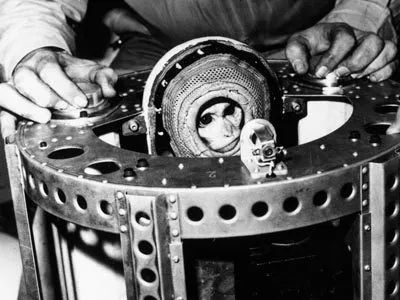
Albert II Secured for Launch – The Face of Early Space Biology
This haunting yet historically vital image shows Albert II, a rhesus monkey, moments before becoming the first primate launched into space on June 14, 1949. Strapped into a tightly fitted capsule, Albert’s eyes peer out from a narrow opening in his restraint system—eyes that reflect a mixture of curiosity, confusion, and vulnerability. The cylindrical metal frame surrounding him is dotted with holes for access, airflow, and sensor monitoring, a stark reminder of the rudimentary technology that defined early space missions. The monkey’s snugly secured body is surrounded by padded walls to reduce trauma from acceleration forces, while his head protrudes through a reinforced ring designed to keep him upright and conscious throughout the flight.
The apparatus around Albert is a cross between medical life support and industrial engineering. Wires and small analog devices are visible on the frame, each connected to biometric sensors tracking vitals such as heart rate, respiration, and neural activity. These were critical to understanding how a living organism responded to the intense stresses of launch, microgravity, and descent. Though he reached an altitude of 83 miles—crossing the Kármán line that marks the edge of space—Albert II died on impact due to a parachute failure upon re-entry. His death was not in vain; it led directly to safety enhancements in future capsule design and marked a critical transition toward human spaceflight.
The image also raises enduring ethical questions. Albert II’s flight was conducted without the benefit of informed consent, sparking decades-long debates over the use of animals in research. Yet his journey laid the groundwork for the biomedical protocols used in Mercury, Gemini, and Apollo missions. Today, Albert II remains both a scientific pioneer and a symbol of sacrifice in humanity’s quest to explore beyond Earth’s atmosphere.
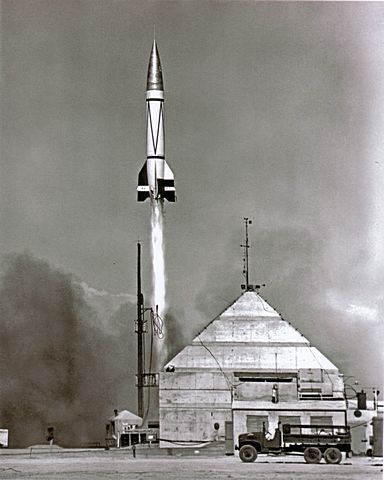
The V-2 Rocket Launch – Propelling the First Primate Into Space
Captured in a striking moment of ascent, this photograph shows a modified German V-2 rocket lifting off from White Sands Proving Ground in New Mexico on June 14, 1949. Inside the nose cone of this missile—concealed from view—is Albert II, a rhesus monkey and the first primate to journey into space. Originally developed by Nazi Germany during World War II, the V-2 became the backbone of early American rocketry through Operation Paperclip, a secret U.S. intelligence program that brought German scientists, including Wernher von Braun, to the United States to advance aerospace development.
In the image, a billow of smoke and fire erupts beneath the rocket’s fins, signifying the ignition of its liquid-fueled propulsion system. The rocket itself stands tall and narrow, painted with alternating black-and-white bands for visibility during flight tracking. At the base, a conical concrete blockhouse can be seen—engineered to withstand blast force and monitor telemetry in real time. The image evokes both awe and gravity, showcasing not only a technological leap but also the sobering legacy of wartime engineering repurposed for peaceful exploration.
The rocket carried Albert II past the Kármán line, reaching an altitude of 83 miles, a milestone that proved living organisms could physically survive the journey into space—at least biologically. Unfortunately, a parachute failure during descent resulted in a fatal crash, making this mission a blend of groundbreaking achievement and tragic loss. Despite the outcome, the mission advanced biomedical instrumentation, capsule design, and telemetry protocols. It marked a pivotal moment in astrobiology and aerospace engineering, directly informing human spaceflight systems a decade later.
Albert II’s journey aboard this rocket remains a significant chapter in the story of life beyond Earth and the complex ethics of experimentation at the frontiers of science.
On June 14, 1949, Albert II, a rhesus monkey, became the 1st primate in space aboard a U.S. V-2 rocket.
Though the mission ended tragically, it marked a key moment in space biology, paving the way for spaceflight & our understanding of life beyond Earth.
#StayCurious #Skystorians #DiveIntoDiscovery
14.06.2025 21:22 — 👍 10 🔁 2 💬 0 📌 0
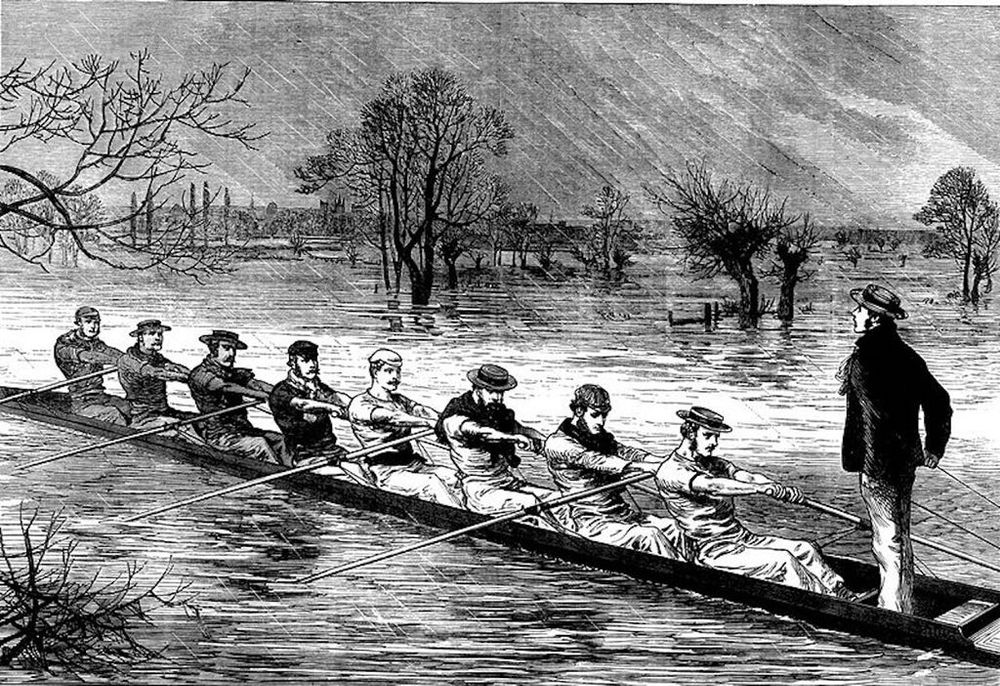
The Historic Beginning – The Oxford-Cambridge Boat Race of 1829
This illustration captures the inaugural Oxford-Cambridge Boat Race, held on June 10, 1829, on a flooded stretch of the River Thames near Henley-on-Thames. Depicted in period-appropriate attire, the rowers from each university are seated in long, slender racing shells, powered by precise and rhythmic oar strokes. At the stern, the coxswain stands upright, steering and calling cadence to synchronize the team’s efforts. The landscape around them is barren and flooded, a subtle but telling detail that emphasizes the perseverance of tradition despite adverse conditions. This iconic rivalry between Britain’s two most prestigious universities began not as a formal regatta but as a friendly challenge between old classmates: Charles Merivale of Cambridge and Charles Wordsworth of Oxford. The outcome of that first race—Oxford’s victory—ignited a sporting legacy that would grow into one of the world’s most celebrated and enduring contests.
The image reflects the early 19th-century values of discipline, amateur sportsmanship, and collegiate identity. The long, sweeping lines of the rowers in unison convey the strategic elegance of crew racing. This event marked a shift in how organized sports were perceived in British culture—moving from informal leisure activity to structured competition, eventually becoming a national spectacle. The race not only reinforced intercollegiate pride but also laid the groundwork for international rowing competitions and collegiate athletic programs globally.
Though modern races feature sleek composite boats, digital tracking, and international broadcasts, this image is a portal to the origins of a tradition that has endured world wars, cultural shifts, and changing athletic norms. It stands as a tribute to how a simple bet between friends became a cornerstone of British sporting heritage and a metaphor for persistence, rivalry, and unity through sport.
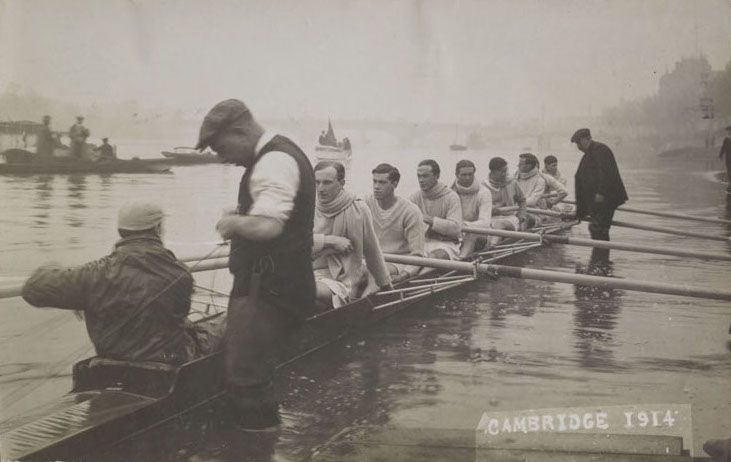
Cambridge 1914 – Rowing on the Eve of War
This photograph, taken in 1914, captures the Cambridge University Boat Club crew preparing to launch from the banks of the River Thames. The image is a moment of poised concentration as the oarsmen, dressed in thick woolen jerseys and layered uniforms, sit shoulder-to-shoulder in a narrow racing shell. They are attended by a coach or boatman, who makes final adjustments before they push off into the cold, misty water. Behind them, the dim outlines of other vessels and support boats populate the grey horizon, while the atmosphere evokes the quiet intensity of athletic discipline amidst historical uncertainty. This was the final Boat Race before World War I would abruptly halt the tradition for six years, and many of the men pictured here would soon exchange their rowing gear for military uniforms.
The image is haunting in hindsight—this quiet river scene frozen in time just months before Europe was engulfed in conflict. Of the 16 oarsmen and coxswains who participated in the 1914 Oxford-Cambridge Boat Race, many would serve in the Great War; several would never return. The race, therefore, is remembered not only for its sporting value but also as a symbolic bookend to an era of relative peace. The faces in this photo reflect youth and determination, unaware of the weight of history about to descend upon them.
Beyond its emotional impact, the image also highlights the evolution of the sport. By 1914, rowing had become more structured, with refined training techniques, boat design, and team management. The uniforms, posture, and composition of the crew demonstrate the rising professionalism of amateur sport during the Edwardian period.
This photograph stands as both a celebration of tradition and a poignant reminder of its fragility. In preserving this moment, the image honors not only the legacy of the Boat Race but the lives and aspirations of a generation whose futures were irrevocably changed.
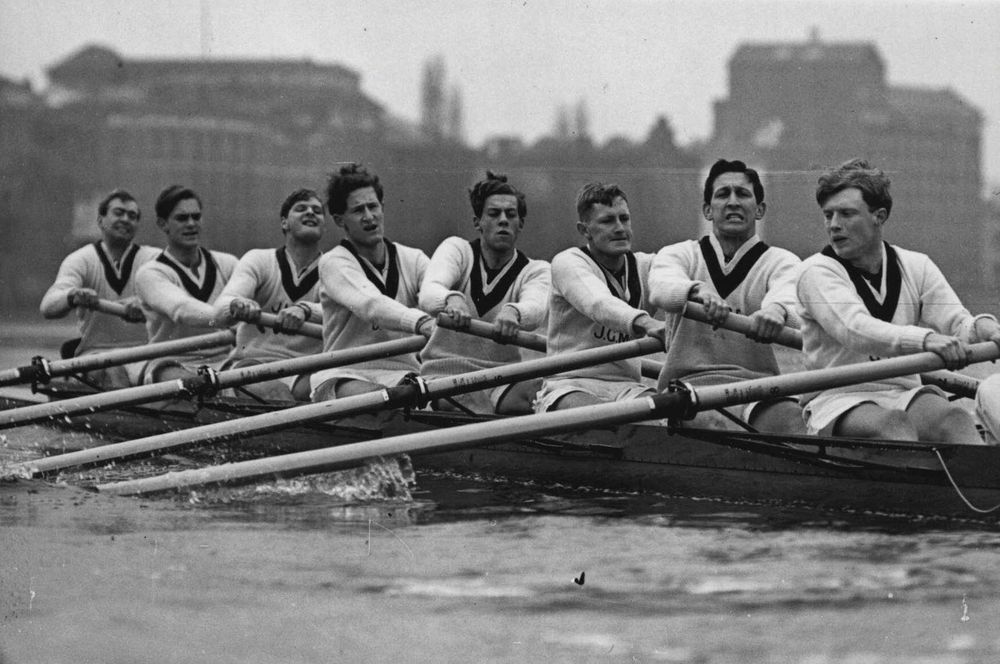
Oxford vs. Cambridge – Mid-20th Century Rivalry in Full Stroke
This powerful black-and-white image captures the Oxford rowing crew during a mid-20th-century edition of the Oxford-Cambridge Boat Race, likely in the 1950s or early 1960s. The rowers, clad in matching white sweaters with dark v-neck stripes, are caught in unison mid-stroke, their faces marked by focus and exertion. The boat cuts sharply through the water, oars perfectly aligned, reflecting the discipline and synchronicity required at the highest level of competitive rowing. The background shows a soft silhouette of London’s riverside architecture blurred by a foggy sky, situating the race in its historic setting along the Thames.
This era marked a golden period for the Boat Race in terms of both prestige and public fascination. Broadcast on radio and later television, the race attracted massive audiences across the UK and internationally. The 1950s and 60s saw an evolution in rowing technique and training regimens, driven in part by advances in sports science and growing university athletic programs. During this time, both Oxford and Cambridge began to more formally incorporate coaching expertise from former Olympians and national team rowers, pushing the level of competition to new heights.
The image exemplifies not just athletic prowess but also the camaraderie and pressure unique to team sports. Each athlete relies entirely on the rhythm, strength, and mental fortitude of those around them. Success is not individual—it is forged in absolute collective unity. This photo offers a compelling visual metaphor for cooperation, tradition, and the endurance of academic and sporting institutions.
The Boat Race during this period had become more than a university event—it was a cultural fixture. Political leaders, royals, and international dignitaries regularly attended. And yet, its essence remained unchanged: eight rowers and a coxswain, rowing not just for victory but for legacy.
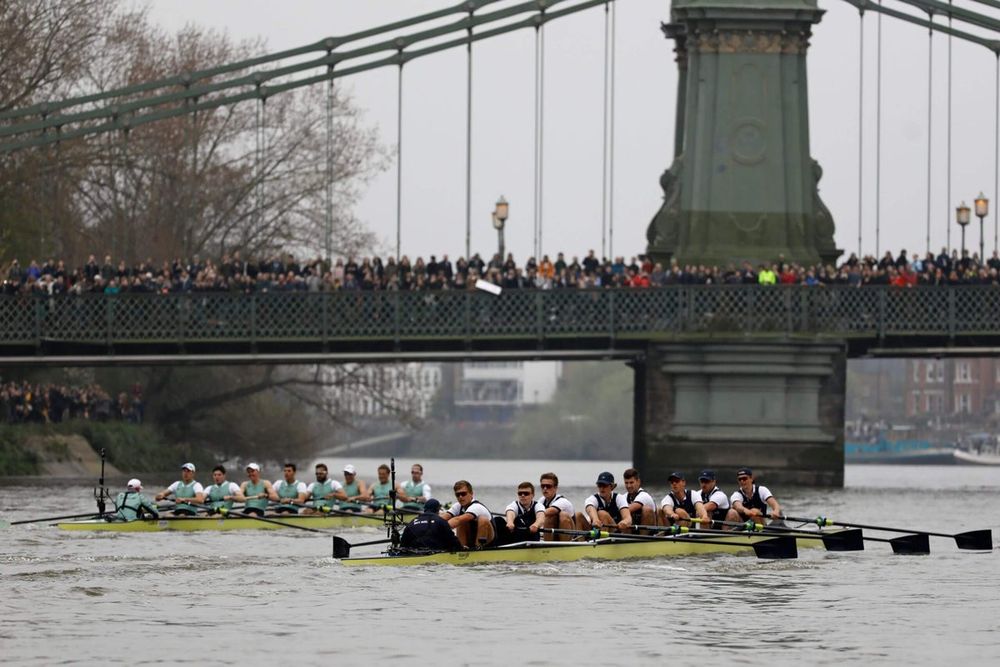
A Tradition in Motion – Modern Oxford-Cambridge Boat Race on the Thames
This captures the Oxford and Cambridge rowing crews in the midst of a modern-day Boat Race on the River Thames, passing beneath the Hammersmith Bridge. Both boats, sleek and brightly painted in their traditional colors—dark blue for Oxford, light blue for Cambridge—are in fierce competition, rowers in matching uniforms pulling in perfect synchronization. On the bridge and along the riverbanks, large crowds of spectators gather to watch, signaling the enduring popularity of this storied event. Smartphones and modern attire among the crowd contrast with the timelessness of the race itself, merging history with the present.
Held annually since 1829, the Oxford-Cambridge Boat Race has evolved from a gentleman’s challenge into a global sporting spectacle. This modern image reflects advancements in both athletic preparation and broadcasting. Today, teams train year-round with sports physiologists, nutritionists, and Olympic-level coaches. Sophisticated GPS tracking, drone footage, and real-time analytics now accompany each race, bringing new dimensions to strategy and storytelling. The introduction of women’s and lightweight races in recent decades has also modernized the tradition, expanding its inclusivity and reach.
The photo captures a pivotal moment—every stroke is an assertion of legacy, pride, and institutional rivalry. Each crew races not just to win, but to etch their names into the long annals of Boat Race history. The symmetry of the rowers, the focus in their eyes, and the crowd’s collective anticipation create a tableau of high athletic drama. Hammersmith Bridge, itself an emblem of Victorian engineering and London’s urban identity, looms as a silent witness to this clash of elite endurance.
This underscores how some traditions, even as they modernize, retain their soul. The Oxford-Cambridge Boat Race continues to embody competition, camaraderie, and the unbroken spirit of tradition.
On June 10, 1829, the first Oxford-Cambridge Boat Race was held on the River Thames. What began as a friendly challenge between two British students became a centuries-long tradition and one of the world’s most iconic sporting rivalries.
#StayCurious #Skystorians #DiveIntoDiscovery
11.06.2025 01:59 — 👍 11 🔁 1 💬 0 📌 0
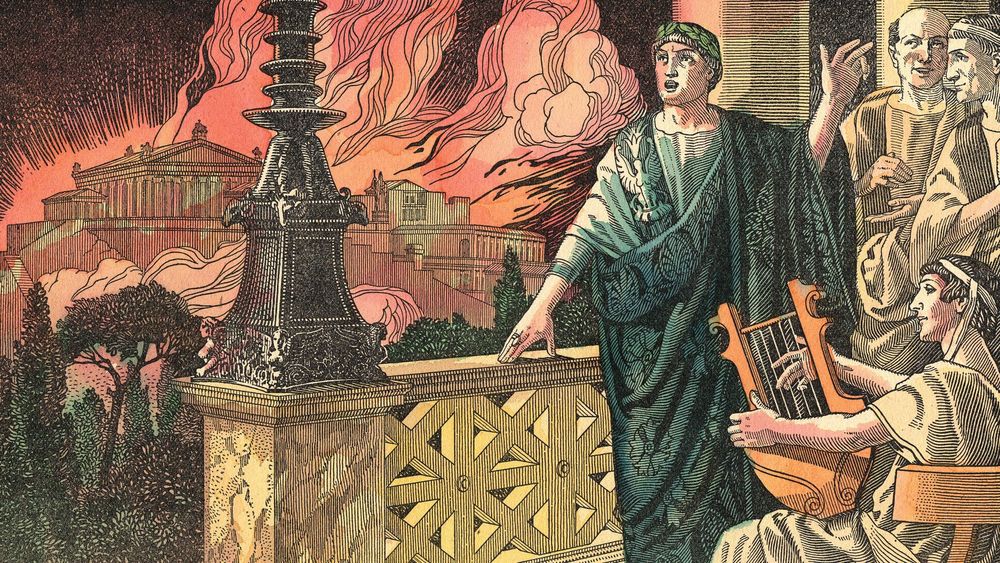
Nero Watches Rome Burn – The Legend and the Legacy
This dramatic illustration captures one of the most enduring and controversial legends in Roman history: Emperor Nero watching the Great Fire of Rome unfold. Set against a backdrop of stylized flames and classical architecture, the image visualizes the popular tale that Nero stood on a balcony overlooking the inferno while playing a lyre. To his right, a seated musician strums the ancient stringed instrument as Nero gestures toward the chaos consuming the city. Although historians widely dispute the accuracy of this story—most notably that Nero was actually in Antium at the time and returned to Rome to aid in relief efforts—the image reflects how deeply embedded this narrative has become in Western cultural memory.
The buildings ablaze in the distance include idealized depictions of Roman temples and forums, suggesting not only the destruction of infrastructure but also the symbolic disintegration of Roman order and civic pride. The sky, awash in red and orange hues, emphasizes the apocalyptic tone often associated with the event, which took place in 64 CE and burned for six days. The fire devastated much of the city, displacing thousands of Romans and creating a vacuum of trust in the imperial leadership.
Nero’s political opponents later used the story of his supposed indifference during the fire to undermine his reign. He deflected blame by accusing Christians of starting the blaze, marking one of the earliest major persecutions of Christians by the Roman state. This response would further darken Nero’s legacy, branding him a cruel and unstable ruler.
Whether fact or fiction, this image distills the complexities of Nero’s rule into a single visual narrative: an emperor absorbed in his own grandeur while his city—and his reputation—burns around him. It exemplifies how art and propaganda can outlast truth, shaping our understanding of historical figures for generations.

The Face of a Tyrant – Nero in Stone and Flesh
This composite image juxtaposes two representations of Emperor Nero: a digital facial reconstruction on the left and a classical marble bust on the right. Together, they reveal both the ancient Roman perception of Nero’s appearance and how modern forensic artistry reimagines historical figures with greater realism. The left side features a lifelike rendering developed from archaeological evidence and 3D scans, showcasing Nero with ruddy, freckled skin, a prominent jawline, and distinctive reddish-blond hair styled in the recognizable imperial fashion of his era. His eyes and expression evoke a mix of youthful arrogance and detached contemplation—a humanizing yet unsettling portrayal of one of history’s most infamous emperors
The right side displays a traditional marble bust from antiquity, a Roman sculptural medium often used to communicate both likeness and propaganda. Nero’s head is slightly turned, his face chiseled with full cheeks, a downturned mouth, and a powerful neck. The wavy hair is meticulously detailed, consistent with Julio-Claudian stylistic preferences. Notably, the bust omits imperfections and exaggerates features associated with strength and control, aligning with how Roman emperors often sought to portray divine favor and authority through idealized portraiture
By presenting these two versions side by side, the image invites viewers to consider how history is both preserved and reshaped. Ancient Romans crafted likenesses to assert legitimacy; today, we use technology to peel back myth and approximate physical truth. Nero’s legacy—marked by cruelty, political paranoia, artistic ambition, and the infamous persecution of Christians—remains controversial. Yet in these visual depictions, we see the evolving dialogue between past and present, myth and reality. They underscore the tension between public image and private identity, and how even a tyrant’s face continues to command scrutiny across millennia
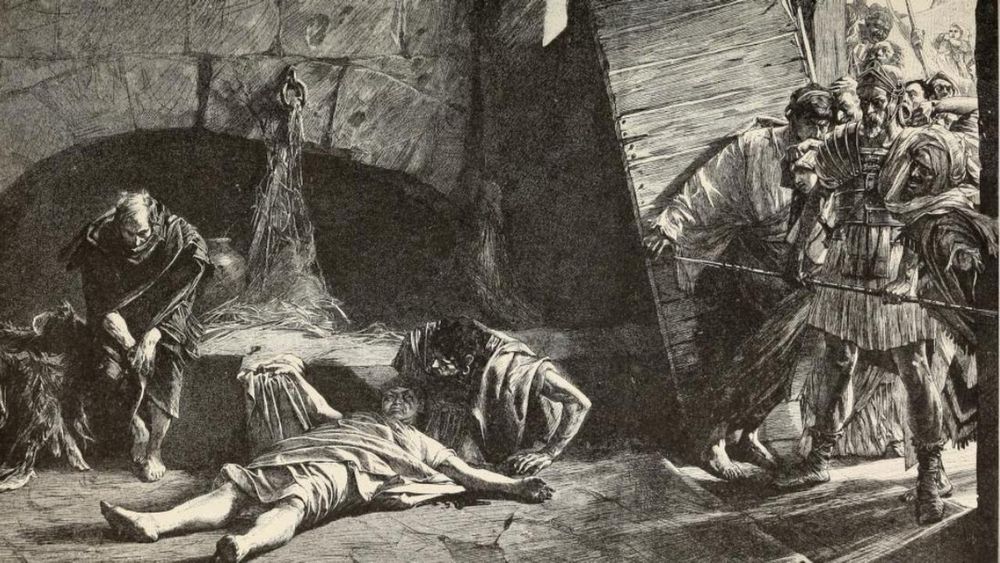
The Death of Nero – A Turning Point in Roman History
This dramatic engraving captures the final moments of Emperor Nero, the last ruler of the Julio-Claudian dynasty, whose reign ended in suicide on June 9, 68 CE. Depicted in a dim, stone-walled chamber—perhaps inspired by the villa of his freedman Phaon where he ultimately met his end—the image evokes the chaos and desperation surrounding Nero’s fall. At the center, Nero lies collapsed and weakened, his body sprawled across the floor in a contorted pose. Two loyal attendants lean toward him in anguish, reflecting the loyalty of a few companions who remained as the Senate declared Nero a public enemy. One figure, often interpreted as Epaphroditus, Nero’s secretary, prepares to assist in the fatal act—reportedly driving a dagger into the emperor’s throat at his request when Nero lost the courage to finish it himself.
The expressions of the surrounding figures heighten the tension. Some Roman soldiers burst into the chamber, too late to apprehend the disgraced ruler alive. Others stand horrified or uncertain, a visual metaphor for the power vacuum and political chaos his death triggered. The atmosphere is thick with shadow, hinting at the collapse not only of a man but of an entire imperial lineage. Nero’s final words, “Qualis artifex pereo!”—“What an artist dies in me!”—are echoed in the tragedy of this scene. He saw himself as a poet and performer, yet history remembers him as a tyrant who burned Rome, killed his own mother, and ruled with cruelty and paranoia.
This visual dramatization serves as a narrative bridge between myth and recorded history. Whether embellished or accurate, it symbolizes the fall of a regime and the end of dynastic rule that began with Augustus. Nero’s death ushered in the tumultuous Year of the Four Emperors, forever altering Rome’s political landscape and demonstrating how personal ambition, unchecked power, and public disfavor can lead to sudden imperial collapse.
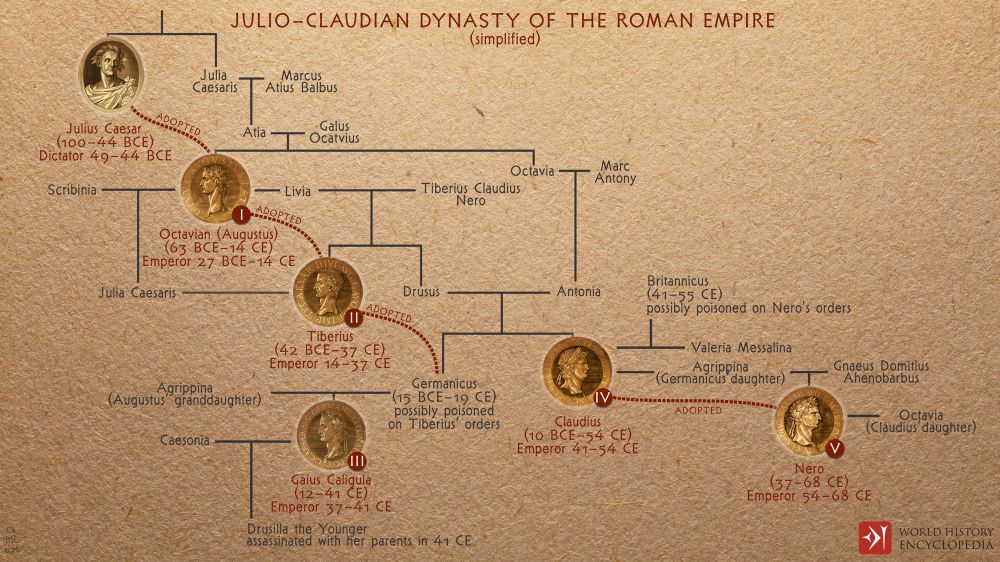
The Julio-Claudian Dynasty – Rome’s First Imperial Lineage
This detailed genealogical chart presents the complex and influential Julio-Claudian dynasty, the first line of emperors in the Roman Empire, stretching from Augustus (27 BCE) to Nero (68 CE). Organized into a simplified family tree, the image traces the interwoven bloodlines and adoptions that shaped imperial succession, reflecting both biological ties and political maneuvering. At the top of the chart, Julius Caesar—who was never emperor himself but laid the groundwork for autocracy—is prominently featured. Through the adoption of his grand-nephew Octavian, who became Augustus, Caesar’s legacy is carried into Rome’s first principate.
Augustus’ successors—Tiberius, Caligula, Claudius, and Nero—are all visually marked with gold medallions, denoting their status as emperors. Red arrows trace lines of adoption or succession, underscoring how power often bypassed direct descendants in favor of politically expedient heirs. For instance, Tiberius, the second emperor, was Augustus’ stepson and adopted heir, while Claudius and Nero both came to power through a combination of bloodline and political adoption.
Surrounding the imperial figures are names of spouses, children, and political alliances, revealing a web of marriages, assassinations, and power grabs. The presence of figures such as Agrippina the Younger (Nero’s mother) and Livia (Augustus’ wife) highlights the crucial roles played by imperial women in shaping dynastic outcomes. The inclusion of infamous events—such as Nero’s suspected poisoning of Britannicus or Caligula’s assassination—adds depth, reminding viewers that the Julio-Claudian reign was not only foundational but fraught with instability.
With Nero’s suicide in 68 CE—marked at the chart’s lower right—the dynasty ended, plunging Rome into the Year of the Four Emperors and signaling that imperial power, once centralized, could become dangerously volatile.
On June 9, 68 CE, Roman Emperor Nero died by suicide, ending the Julio-Claudian dynasty. His death plunged the Roman Empire into the chaos of the Year of the Four Emperors, a pivotal turning point in imperial politics and civil unrest.
#StayCurious #Skystorians #DiveIntoDiscovery
10.06.2025 05:41 — 👍 4 🔁 0 💬 0 📌 0
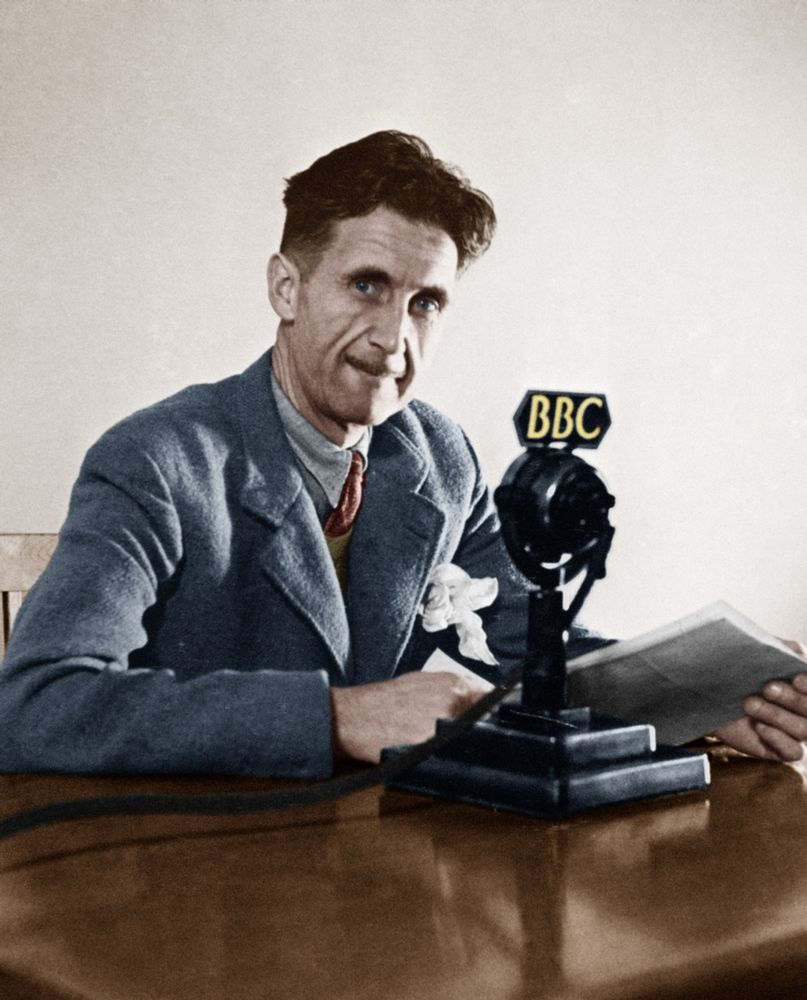
George Orwell at the BBC – Voice Against Totalitarianism
This colorized photograph captures George Orwell, born Eric Arthur Blair, seated at a BBC radio microphone during his time as a broadcaster in the early 1940s. Known for his sharp intellect and unwavering critique of authoritarian regimes, Orwell worked for the BBC’s Eastern Service during World War II, producing cultural programming aimed at countering Nazi propaganda. Although he later became disillusioned with the institution, believing it to be complicit in state messaging, his time there deeply informed his understanding of mass communication, surveillance, and state power—concepts that would be central to his most enduring work. Orwell’s subtle smirk and alert eyes reflect a man deeply engaged with the contradictions of his era, balancing duty and dissent. Behind the iconic BBC microphone, emblazoned with its black-and-yellow logo, Orwell is both symbol and critic of the modern state’s communication machinery.
This image holds additional historical resonance given Orwell’s later publication of Nineteen Eighty-Four on June 8, 1949. In that dystopian novel, he introduced the world to the terrifying concept of “Big Brother,” drawing heavily from his firsthand experiences with propaganda and censorship. His appearance here, framed in modest attire and a sparse setting, stands in contrast to the looming, monolithic authority he would later describe in fiction. This image not only preserves a moment in the life of one of the 20th century’s greatest political thinkers, but it also embodies the subtle war between truth and power that Orwell dedicated his life to exposing.

The Dystopian Warning – Cover Art for Orwell’s 1984
This image showcases a striking piece of cover art for George Orwell’s Nineteen Eighty-Four, his landmark dystopian novel first published on June 8, 1949. Dominated by bold red, black, and gold tones, the cover evokes both totalitarian aesthetics and vintage propaganda posters. At the center looms a stylized eye—symbolizing the all-seeing gaze of “Big Brother,” the omnipresent figurehead of Orwell’s imagined regime. The eye appears layered with texture, as if emerging from aged newsprint or a distorted television screen, reinforcing the novel’s themes of surveillance, control, and mediated reality. Above it, Orwell’s name is emblazoned in an authoritarian font, immediately followed by the bold crimson “1984,” which demands attention and signals a future defined by submission and fear.
The design invokes the oppressive visual language of totalitarian propaganda, echoing real-world regimes Orwell sought to critique—particularly Stalinist Russia and Nazi Germany. It captures the essence of a world where privacy is erased, language is weaponized, and thought itself becomes an act of rebellion. The barbed borders and militaristic typefaces hint at confinement and censorship, key elements in the novel’s fictional society of Oceania, where independent thought is labeled as “thoughtcrime,” and history is rewritten to suit the Party’s needs.
This book cover has become an enduring symbol of resistance against authoritarianism and digital overreach, appearing in countless modern-day protests, tech-ethics debates, and freedom of speech campaigns. The visual identity of 1984 remains as powerful today as when it first appeared, continually reminding audiences that Orwell’s fiction is not a relic of the Cold War—but a chillingly prescient reflection of the ongoing struggle between truth and power in the modern world.
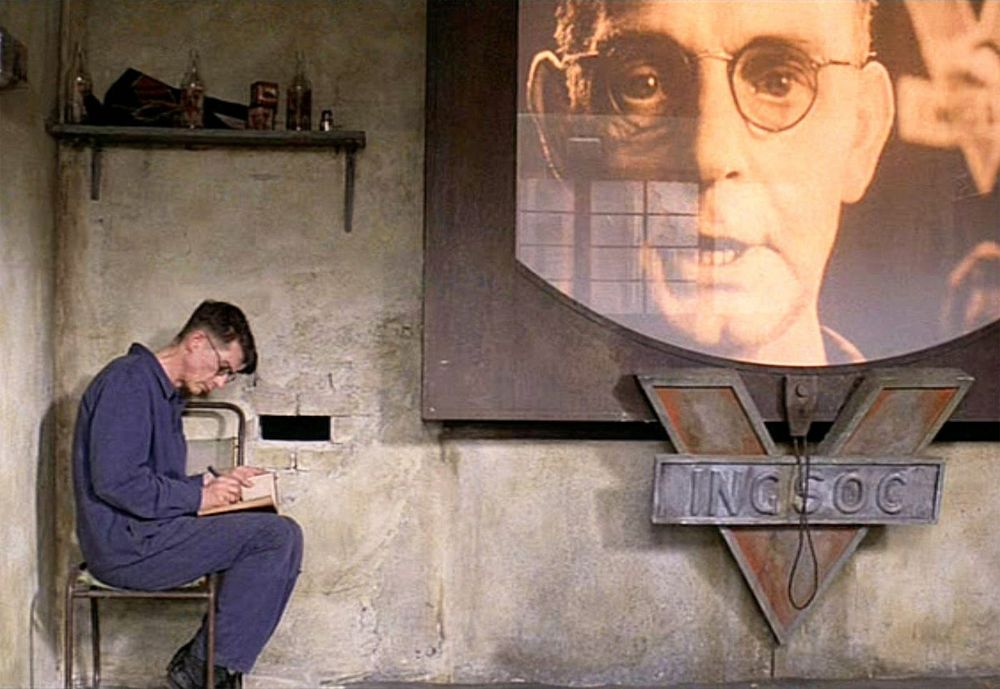
Surveillance and Subversion – A Scene from the 1984 Film Adaptation of Nineteen Eighty-Four
This image captures a hauntingly accurate visual interpretation of George Orwell’s dystopian world as depicted in the 1984 film adaptation of Nineteen Eighty-Four, directed by Michael Radford. The frame centers on Winston Smith, the novel’s protagonist, seated alone in a dilapidated, gray-washed room that bears the stark and worn texture of authoritarian decay. He is hunched over a notebook, quietly committing to paper the rebellious act of thought—an action fraught with danger in the regime of Big Brother. The dim lighting and confined space convey a sense of both isolation and suffocation, echoing the oppressive psychological atmosphere of Oceania.
Dominating the right half of the image is a massive telescreen projecting the ominous visage of Big Brother, whose eyes appear to follow the viewer, reinforcing the regime’s ceaseless surveillance. The screen is mounted above the symbol of INGSOC, the Party’s ideology, shaped like a downward-pointing V flanked by authoritarian steel and a taut cord—a visual metaphor for control and punishment. The televised face speaks not only to the propaganda constantly broadcast to the citizens, but also to the inescapable gaze that defines the narrative’s central conflict.
This visual sequence encapsulates the novel’s most chilling themes: the erosion of privacy, the control of truth, and the existential weight of living under constant observation. It also emphasizes the loneliness of dissent in a world engineered to erase it. Winston’s small act of writing represents the last vestige of human autonomy in a society where language has been sanitized and emotion criminalized.
The scene resonates deeply with contemporary viewers, especially in an age of digital surveillance, data collection, and algorithmic manipulation.

“Big Brother Is Watching You” – The Enduring Symbol of Orwellian Surveillance
This image displays one of the most iconic pieces of visual propaganda in modern literature and political commentary: the chilling phrase “BIG BROTHER IS WATCHING YOU” beneath a stern, all-seeing face. First conceived in George Orwell’s 1984, published on June 8, 1949, this phrase embodies the central mechanism of authoritarian control in the fictional state of Oceania. The face—typically rendered with exaggerated features, furrowed brows, intense eyes, and a neutral mouth—represents Big Brother, the omnipresent, omnipotent figurehead of the totalitarian regime. Although never confirmed to exist within the story, Big Brother operates as both god and tyrant, a psychological weapon used to enforce obedience, suppress dissent, and maintain a state of perpetual fear.
The simple yet stark design of the image is deliberate. The use of bold, black capital letters conveys an unyielding tone, giving the message the weight of law. The central eye contact of the portrait creates an illusion that the viewer is constantly being observed, reinforcing the themes of constant surveillance and the loss of privacy. The aesthetic is militaristic, direct, and devoid of warmth—meant to control rather than comfort.
This transcended the pages of Orwell’s novel and entered public consciousness as a universal symbol of state overreach and digital surveillance. In the post-9/11 world, during debates over the Patriot Act, facial recognition technology, government data collection, and corporate surveillance capitalism, the phrase has been reused in protests, graffiti, and political cartoons across the globe. It remains a stark reminder of how technology, when unchecked, can become a tool for repression.
“Big Brother is watching you” endures as a universal shorthand for the perils of unchecked authority. It continues to remind us that freedom is fragile—and vigilance against oppression is a responsibility of all.
On June 8, 1949, George Orwell’s “1984” was published. Though a novel, its chilling vision of surveillance and control foreshadowed real-world debates about data privacy, digital freedoms, and authoritarian technology in the 21st century.
#StayCurious #Skystorians #DiveIntoDiscovery
09.06.2025 04:18 — 👍 19 🔁 6 💬 1 📌 1
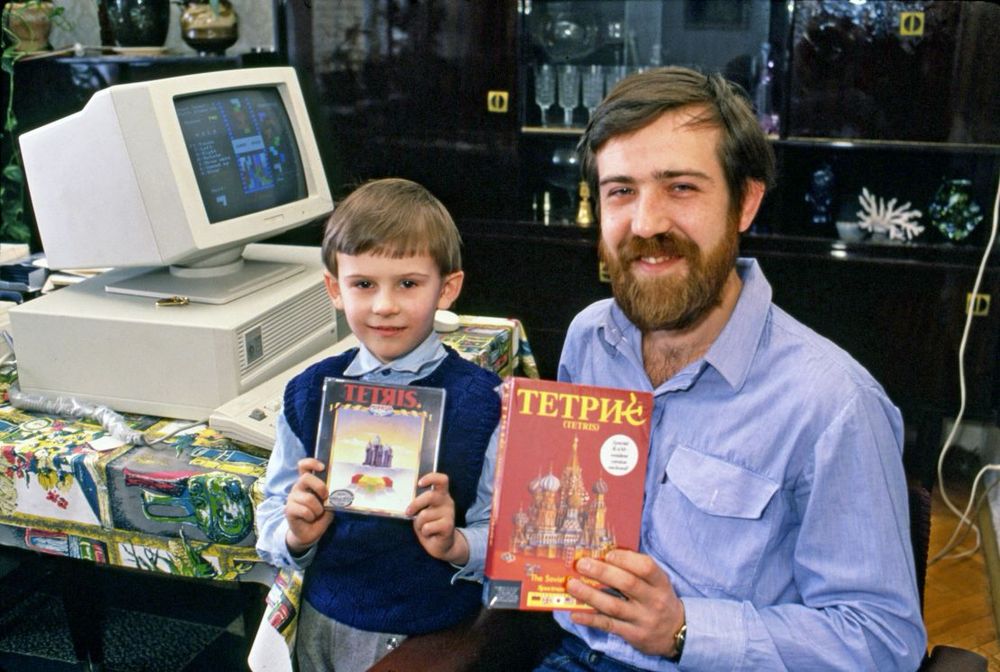
The Birth of Tetris – A Cold War Gaming Breakthrough
This vibrant image captures a moment of playful pride and historic innovation, as Soviet software engineer Alexey Pajitnov poses beside a young boy—likely a family member or young enthusiast—both holding early boxed versions of Tetris, the groundbreaking puzzle game Pajitnov created on June 6, 1984. Behind them, an old Soviet computer displays the game in action. What makes this photo so remarkable is its understated yet powerful reflection of a game that quietly transcended borders in a deeply divided world. Tetris was developed within the walls of the Soviet Academy of Sciences in Moscow at a time when Western and Eastern blocs were politically and ideologically at odds. Inspired by a traditional puzzle game called Pentominoes, Pajitnov simplified the gameplay into falling geometric shapes—tetrominoes—that needed to be rotated and fitted into complete lines. The game’s elegant logic, universal accessibility, and hypnotic pacing helped it leap beyond the Iron Curtain. Despite being state property in its early years due to Soviet copyright rules, Tetris found its way to Hungary, and soon to the West, becoming a hit across PCs, arcade cabinets, and most famously, Nintendo’s Game Boy in 1989. It was the first game exported from the USSR to the U.S., and its mass appeal demonstrated the unifying potential of digital entertainment in an era of political estrangement. In the photo, the juxtaposition of childlike innocence, retro computing, and Soviet innovation visually embodies the cultural permeability of great ideas. Decades later, Tetris remains one of the most beloved and best-selling video games of all time, a rare Cold War relic that brought joy rather than tension to millions.

Alexey Pajitnov at SXSW – The Enduring Legacy of Tetris
In this modern-day photograph, Alexey Pajitnov—creator of Tetris—stands beaming with both thumbs up, captured at the SXSW (South by Southwest) festival in front of a bright yellow step-and-repeat wall. Clad in a lavender blazer over a soft pink sweater, Pajitnov appears relaxed, jovial, and warmly received by an audience that has grown up with his creation. While the backdrop features logos of global tech and media brands like Slack and White Claw, the real spotlight here is on Pajitnov himself, whose enduring legacy stretches across generations and continents. His attendance at SXSW underscores the remarkable journey of Tetris—a game that began as a humble side project in a Moscow computing lab in 1984 and went on to reshape the global gaming landscape. Unlike many developers of that era, Pajitnov saw his creation become a cultural phenomenon not just once, but repeatedly: from the arcade boom to Game Boy success, mobile gaming revolutions, and now modern reimaginings in film and augmented reality. His smile speaks to the quiet pride of a man who bridged East and West not through politics, but pixels. This image not only honors his contribution to game design but also celebrates how intellectual curiosity and elegant design can create tools of joy and unity. At SXSW—a festival that celebrates boundary-breaking creativity—Pajitnov is not just a nostalgic figure. He’s a living reminder that some of the most transformative innovations come from the unlikeliest of places and continue to evolve long after their inception. From Cold War obscurity to pop culture icon, this photo affirms Pajitnov’s place among the digital age’s great innovators, as a symbol of playful resilience and the global language of games.

The Original TETRIS Terminal Interface – Soviet Simplicity in Digital Form
This image captures a stylized modern recreation of the original Tetris launch screen, echoing the minimalist Soviet computer interfaces of the 1980s. Dominated by the bright green glow of monospaced text rendered on a simulated CRT monitor, the word “TETRIS” is formed in a blocky digital font that resembles the very tetrominoes the game made famous. Below it sits a simple rectangular “PLAY” button, inviting the user to start the game—a design as elegant and deceptively simple as the game itself. At the bottom of the screen, metadata appears in a cascading list: a welcome greeting to users “Alexey P.” and “Henk B.” (a nod to Alexey Pajitnov, the game’s creator, and Henk Rogers, who helped popularize Tetris worldwide), followed by the 1985–2023 copyright notice, licensing text, and acknowledgment of the game’s ownership and design.
Though modern in polish, this screen pays homage to Tetris’s original roots on the Elektronika 60, a Soviet computer with no graphics card—meaning the first blocks were formed entirely using text characters. This stark interface serves as a testament to the game’s unique legacy: a piece of Cold War-era software that transcended its technical and political limitations to become a universal phenomenon. The retro-futuristic aesthetic also mirrors the Cold War-era curiosity surrounding computing, where coding often took place in windowless labs yet sparked worldwide revolutions. This single image—static and silent—evokes an era when gameplay didn’t need flashy visuals or complex narratives to captivate. It reminds us that innovation often starts with constraints, and that timeless design can begin with a blinking cursor and a brilliant idea. From Soviet code to global icon, Tetris remains a masterclass in simplicity, strategy, and the infinite replayability of falling blocks.

Playing Tetris on NES – The 8-Bit Global Invasion
This image captures the unmistakable sight of Tetris in action on a Nintendo Entertainment System (NES), the platform that helped solidify the game’s legendary status outside the Soviet Union. A player—seen from behind—is holding a rectangular NES controller, focused intently on the screen as tetrominoes descend. The familiar blue-on-black grid showcases the simplicity and addictiveness that made Tetris a transcendent hit. To the right, the score and level indicators are blank, suggesting the beginning of a game. On the left, statistical readouts document the frequency of each tetromino’s appearance, adding a layer of depth for players obsessed with optimizing their moves. The screen is washed in the glowing blur of CRT scan lines, transporting the viewer back to a time when 8-bit aesthetics were the cutting edge of home entertainment.
While Tetris was originally developed on a Soviet computer in 1984, it was its release on the Game Boy and NES in the late 1980s that launched the game into global superstardom. Henk Rogers, a Dutch-American entrepreneur, played a crucial role in negotiating the Western publishing rights and partnering with Nintendo to bundle the game with its new handheld console. This strategic move didn’t just sell millions of Game Boys—it turned Tetris into a symbol of cross-cultural exchange in the waning years of the Cold War. Despite geopolitical divisions, this small puzzle game became a common language among gamers across the globe.
This image, though simple at first glance, represents how an abstract Soviet algorithm made its way into living rooms from Tokyo to Toronto. Here, as tetrominoes fall and lines clear, history itself plays out in silent increments. It’s a reminder that some of the most enduring cultural legacies don’t come from grand speeches or world leaders—but from clever code, falling blocks, and a well-timed rotation.
On June 6, 1984, Tetris was created by Soviet software engineer Alexey Pajitnov. Born in Moscow, this simple yet addictive puzzle game became a global phenomenon. Redefining gaming across borders during the Cold War.
#StayCurious #Skystorians #DiveIntoDiscovery
07.06.2025 03:48 — 👍 23 🔁 6 💬 2 📌 0

“Tank Man” and the Tiananmen Square Protests of 1989
This historic image captures an anonymous man standing defiantly in front of a line of Chinese Type 59 tanks on June 5, 1989, during the aftermath of the Tiananmen Square protests in Beijing. Known globally as “Tank Man,” the lone figure became an enduring symbol of individual resistance against authoritarianism. The man, holding shopping bags in each hand, stepped into the path of the tanks shortly after the Chinese government launched a violent military crackdown to suppress weeks of pro-democracy protests. These protests, led by students and supported by intellectuals and workers, had occupied Tiananmen Square for nearly two months, demanding political reform, anti-corruption measures, and greater freedoms. The Chinese government declared martial law and, on June 3–4, deployed troops and armored vehicles into the city. Hundreds—possibly thousands—of unarmed civilians were killed in what became one of the most infamous suppressions of dissent in modern history. Despite the government’s efforts to erase the event from domestic memory, the image of “Tank Man,” taken by photographer Jeff Widener from a nearby hotel balcony, was smuggled out and widely published internationally. It has since become a universal emblem of courage and nonviolent protest. The man’s identity and fate remain unknown, adding to the mystique and poignancy of the moment. In the broader historical context, this image underscores the power of visual media in shaping global awareness of human rights violations and remains one of the most iconic photographs of the 20th century.

Mass Demonstrations in Tiananmen Square Before the Crackdown
This powerful image shows the immense scale of the student-led protests in Beijing’s Tiananmen Square during the spring of 1989, prior to the military crackdown. Stretching across the vast plaza in front of the Forbidden City, tens of thousands of demonstrators gathered in peaceful assembly, calling for democratic reforms, greater transparency, and an end to government corruption. The focal point of the square is the towering white statue known as the “Goddess of Democracy,” erected by art students as a symbolic counterpart to the nearby portrait of Mao Zedong and a visual embodiment of the movement’s aspirations. Banners and red flags wave above the sea of people, while makeshift tents and loudspeakers signal a temporary, organized encampment. The protests, which began in April 1989 following the death of reformist leader Hu Yaobang, swelled into a massive and sustained sit-in that captured the attention of the global media. The demonstrators came from across Chinese society—students, journalists, intellectuals, and workers—united by a shared desire for political liberalization. While the movement was largely nonviolent, its demands posed a direct challenge to the Chinese Communist Party’s grip on power. For weeks, negotiations between protest leaders and government officials faltered, ultimately culminating in the decision to forcibly clear the square on the night of June 3–4. This image, therefore, preserves a fleeting moment of hope and collective willpower before the violent suppression that followed. It serves as a visual archive of a historic democratic movement and a sobering reminder of its tragic end.

Protest Banner Demanding Democracy in Front of Mao’s Portrait
This striking photograph captures a defining moment during the 1989 Tiananmen Square protests, as thousands of demonstrators stand beneath a banner reading, “Give Me Democracy or Give Me Death.” Positioned directly in front of the Tiananmen Gate and the towering portrait of Mao Zedong—the founder of the People’s Republic of China—the banner juxtaposes the protesters’ urgent call for reform with the enduring symbol of Chinese Communist authority. The crowd, densely packed and unified in purpose, is composed largely of university students, many wearing hats, armbands, or headbands indicating their affiliations with various institutions or activist groups. The sea of raised fists, open mouths mid-chant, and hand-drawn signs reflect a mix of youthful passion and political resolve. At the time, the protest movement was spurred by dissatisfaction with inflation, nepotism, and a lack of political openness following the death of reformist leader Hu Yaobang. What began as a student vigil evolved into a mass demonstration representing a cross-section of Chinese civil society. The emotional and ideological potency of the sign—echoing revolutionary slogans from both East and West—illustrates how deeply the protesters believed in the urgency of their demands. Visible in the background, Mao’s looming visage acts as both a reminder of past authoritarian rule and a symbol of the ideological monolith they sought to challenge. This image encapsulates the extraordinary courage of the protesters and their audacious efforts to claim political agency in a highly controlled system. Today, it remains one of the most iconic visual artifacts from a movement that dared to imagine a different future for China.

Clashes Between Protesters and Soldiers During the Crackdown
This intense image captures a chaotic and emotional scene from the night of June 3 into the early hours of June 4, 1989, during the violent crackdown on the Tiananmen Square protests. A group of civilians is seen struggling with uniformed Chinese soldiers, some trying to hold them back while others shout, restrain, or confront them face-to-face. The soldiers, wearing olive-green military uniforms and red-collared caps, carry gear and are visibly overwhelmed by the resistance they’re facing. Some are mid-action, pulling away or being shoved, their expressions tense and bewildered. One soldier is bent at the waist, his face obscured, caught in the push-and-pull of the fray. The civilians—mostly middle-aged men and younger activists—grapple with them, faces contorted in anguish, fear, or determination. This confrontation is part of the larger government operation to retake Tiananmen Square by force, as the Chinese Communist Party leadership declared martial law to quell six weeks of growing public dissent. Although tanks and armored vehicles are more often associated with this moment, these close-range skirmishes between unarmed citizens and heavily equipped troops were frequent throughout Beijing that night. The streetlights in the background barely illuminate the crowd, lending a claustrophobic and urgent energy to the image. The photograph reflects the desperation and bravery of ordinary citizens willing to resist military might to protect the spirit of peaceful protest. These nighttime confrontations left an unknown number dead and wounded, as the Chinese government has never released an official death toll. This moment serves as a stark visual reminder of the human cost of authoritarian control and the enduring power of civilian resistance.
On June 4, 1989, the Tiananmen Square protests in Beijing ended in a violent crackdown. What began as a student-led call for democratic reform became a defining moment for global human rights awareness. Marked by the image of “Tank Man.”
#StayCurious #Skystorians #DiveIntoDiscovery
04.06.2025 23:53 — 👍 38 🔁 23 💬 0 📌 0

Ed White’s NASA Portrait Before the Gemini IV Mission
This official NASA portrait features astronaut Edward H. White II, the first American to perform a spacewalk, wearing his silvery Gemini-era spacesuit. Taken shortly before the launch of Gemini IV in 1965, the image captures a moment of calm confidence, underscoring White’s vital role in the early years of NASA’s space program. His gloved hands rest on a small scale model of a Titan II rocket—the launch vehicle used for the Gemini missions—and the U.S. flag in the background emphasizes the national pride surrounding America’s push to compete with the Soviet Union during the height of the Space Race. White’s historic extravehicular activity (EVA) on June 3, 1965, marked a pivotal step forward in American spaceflight capabilities. He remained tethered to the spacecraft for 23 minutes, using a hand-held maneuvering unit known as a “zip gun” to control his movements. This iconic achievement helped NASA gain crucial experience with spacewalks, which would later become essential during the Apollo moon landings and in constructing and maintaining the International Space Station. The Gemini program served as a critical bridge between Project Mercury and the ambitious Apollo lunar missions, allowing NASA to test docking techniques, multi-day missions, and human endurance in space. White, a U.S. Air Force officer and test pilot, was selected in NASA’s second group of astronauts in 1962. His training and engineering background made him a standout candidate for EVA operations, and his success on Gemini IV inspired the design of more advanced suits and procedures for future missions. Tragically, Ed White later lost his life during a launch pad fire in the Apollo 1 accident in 1967, becoming one of NASA’s earliest martyrs. This image stands as a tribute to his legacy, capturing the calm courage of a man who made history with one giant leap into the void.

Ed White’s Historic Spacewalk During Gemini IV
This striking image captures astronaut Ed White floating in the vast darkness of space during NASA’s Gemini IV mission on June 3, 1965. As the first American to perform an extravehicular activity (EVA), White is seen suspended above Earth, connected to the spacecraft by a 25-foot tether. He holds the hand-held maneuvering unit—nicknamed the “zip gun”—that allowed him limited control as he drifted weightlessly outside the Gemini capsule. The deep blackness of space frames the curvature of the Earth below, a dramatic contrast that emphasizes both the grandeur and isolation of early space exploration. White’s 23-minute EVA was not just a bold step forward for American astronauts—it was a technological and physiological milestone. Engineers had to overcome challenges related to life support, suit mobility, and safety in a vacuum, all with limited precedent. Only three months earlier, Soviet cosmonaut Alexei Leonov had become the first human to walk in space, igniting pressure for the U.S. to respond. White’s mission helped validate NASA’s ability to safely manage astronauts outside a spacecraft, paving the way for the Apollo moonwalks and later the complex repairs, construction, and scientific activities conducted on Skylab, the Space Shuttle, and the International Space Station. The suit White wore, designed for flexibility and life support, marked an evolution in EVA technology, helping scientists understand how human bodies function in microgravity for extended periods. His calm demeanor and visible awe—he later said he didn’t want to come back inside—captured the public imagination. This photo endures as a symbol of the courage, innovation, and pioneering spirit that defined NASA’s Gemini program, and honors Ed White’s legacy as a trailblazer in the history of human spaceflight.

Gemini IV Astronauts Ed White and James McDivitt Prepare for Launch
This historic image captures NASA astronauts Ed White (left) and James McDivitt (right) fully suited in their pressure gear just before launch during the Gemini IV mission in June 1965. Smiling confidently, the two men represent the cutting edge of 1960s spaceflight during one of NASA’s most ambitious early efforts. As the command pilot, McDivitt oversaw spacecraft operations while Ed White served as the pilot and was selected for the mission’s most daring experiment—America’s first spacewalk. Their flight was only the second crewed mission in NASA’s Gemini program, which served as the crucial link between the short-duration Mercury missions and the long-term complexities of the Apollo lunar program. The image is a testament to the intense training and trust that existed between crew members. Gemini IV’s four-day journey marked a major step toward prolonged space operations, testing spacecraft endurance, human adaptability, and maneuvering capabilities. White and McDivitt trained extensively for the mission, including underwater simulations and high-altitude flights, helping engineers refine protocols for extravehicular activity (EVA), orbital rendezvous, and long-term life support in zero gravity. Their matching pressure suits—white with reinforced joints and fitted helmets—reflected improvements in mobility and protection. Though McDivitt remained inside the capsule, his steady piloting during White’s EVA was critical to mission success. Their teamwork laid the groundwork for future pair-based astronaut operations seen during Apollo lunar missions. This photograph, taken at a time when spaceflight was still new and deeply experimental, is a portrait of trust, discipline, and pioneering spirit. It reminds us that every iconic space milestone relies not only on engineering breakthroughs but also on the human bonds that make such feats possible.

Ed White’s Historic Spacewalk Above Earth – A Defining Moment in Human Exploration
In this breathtaking photograph, astronaut Ed White floats freely above the Earth during his historic extravehicular activity (EVA) on June 3, 1965, becoming the first American to perform a spacewalk. Captured during NASA’s Gemini IV mission, the image shows White tethered to the spacecraft by an umbilical cord and maneuvering with a hand-held gas-powered “zip gun” called the Hand-Held Maneuvering Unit. His visor reflects the spacecraft and fellow astronaut James McDivitt, who piloted Gemini IV from within. The vibrant blue arc of Earth curves below, dotted with clouds, accentuating the enormity of space and the fragility of the human form against the cosmos. Lasting 23 minutes, White’s EVA was a pivotal step in American spaceflight, demonstrating not only the physical possibility of operating outside a spacecraft but also the psychological readiness of astronauts to handle the isolation and freedom of open space. The image encapsulates a sense of awe, courage, and scientific achievement that defined the space race era. Though the Soviet Union had completed the world’s first spacewalk just months earlier, White’s EVA marked a leap in NASA’s capabilities and offered valuable data that would shape future missions, including Apollo’s lunar EVAs and decades of work aboard the International Space Station. The suit he wears was a modified Gemini G4C pressure suit designed to provide mobility, temperature regulation, and protection from micrometeoroids—critical innovations for future spacewalks. This moment above the Earth was so moving that White resisted returning to the capsule, famously remarking, “It’s the saddest moment of my life.” The image remains one of the most iconic in the history of space exploration, symbolizing not only a triumph of technology but a profound moment in humanity’s quest to explore beyond its home planet.
On June 3, 1965, Ed White became the first American to walk in space, spending 23 minutes outside Gemini IV. His groundbreaking EVA paved the way for Apollo missions and future work on the International Space Station.
#StayCurious #Skystorians #DiveIntoDiscovery
04.06.2025 04:35 — 👍 22 🔁 2 💬 0 📌 1

The Cultural Collage of Sgt. Pepper’s Cover – A Visual Manifesto of 1960s Counterculture
This iconic image shows the cover of The Beatles’ groundbreaking 1967 album Sgt. Pepper’s Lonely Hearts Club Band, an artwork that reshaped how music could be presented to the public. Designed by British pop artists Peter Blake and Jann Haworth, the cover is a dense photo-collage featuring over 70 life-size cardboard cutouts of cultural, literary, political, and spiritual figures. The Beatles themselves appear twice—once as wax figures in their early suits (left), and again in their psychedelic alter-egos wearing vividly colored military-style uniforms (center), a visual representation of their creative transformation. Arranged as a fictional band posing after a brass band concert, they stand around a drum bearing the album’s title. At their feet, the word “Beatles” is spelled out in red flowers. Notable figures in the collage include Bob Dylan, Karl Marx, Carl Jung, Oscar Wilde, Marilyn Monroe, Lewis Carroll, and even a wax figure of Sonny Liston. The visual chaos and harmony mirror the sonic experimentation inside the album, which incorporated orchestras, Indian instrumentation, tape loops, and surrealist lyrics. Released on June 1, 1967, Sgt. Pepper was more than an album—it was a manifesto for the Summer of Love, a symbol of 1960s idealism, and a definitive moment in rock history. The cover broke from traditional band imagery and invited listeners into a complete conceptual world. This image remains a landmark in album art, blurring the boundaries between pop culture and high art, and signaling the dawn of the LP as an immersive artistic experience. Its influence still echoes in how musicians visualize identity and community.
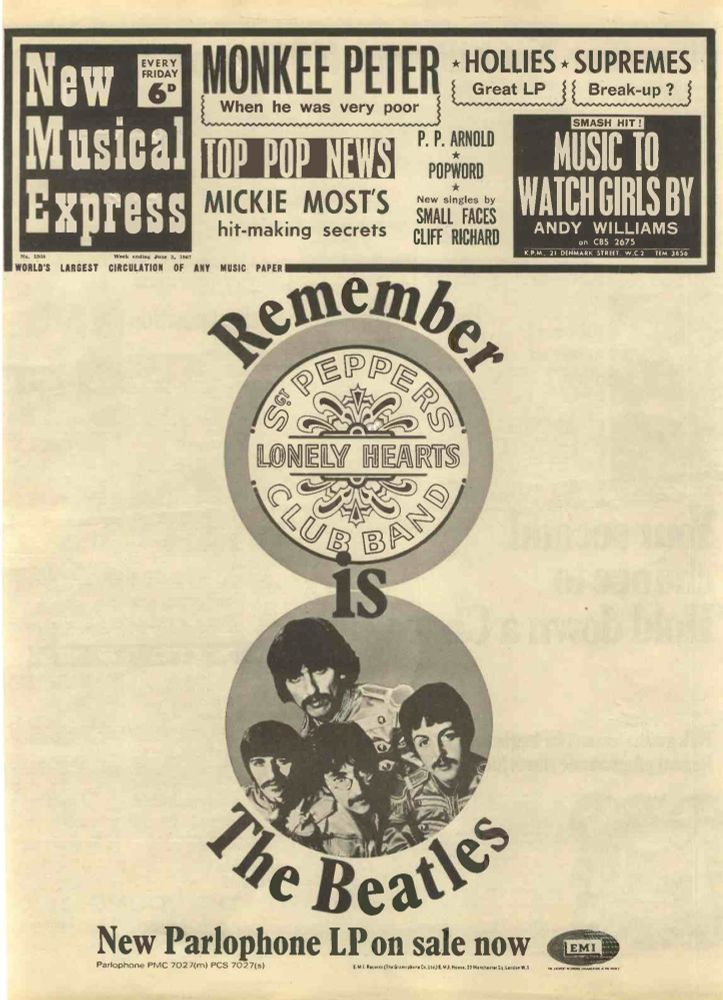
A Press Blitz for the Psychedelic Vanguard – Sgt. Pepper in Print Promotion
This historical image captures a 1967 promotional poster in the style of a tabloid front page from New Musical Express, the UK’s leading music publication at the time, celebrating the release of Sgt. Pepper’s Lonely Hearts Club Band. The bold black text announces The Beatles’ new LP from Parlophone Records, underscoring the album’s immense cultural anticipation. The typography mimics sensational headlines—“Remember Sgt. Pepper’s Lonely Hearts Club Band is The Beatles”—placed over a circular photo of the band in their now-iconic satin military uniforms. John, Paul, George, and Ringo are each adorned in flamboyant colors and handlebar mustaches, symbolizing their transformation from pop idols into avatars of the counterculture. At the time of its release on June 1, 1967, Sgt. Pepper was not just another Beatles album—it was a global cultural event. This poster promoted the LP as both sonic innovation and mass media product, using the design language of newspaper ads to generate mainstream hype for a deeply experimental record. The surrounding headlines reference contemporaneous pop news and artists—such as The Monkees, The Hollies, The Supremes, and Andy Williams—signaling the Beatles’ dominance even amidst a crowded music scene. Notably, this advertisement represented a shift in how records were marketed: Sgt. Pepper wasn’t sold on singles, but as a complete album experience, making full use of print to deliver a unified cultural message. The use of the newspaper aesthetic signified trust and urgency, positioning the album as must-hear news. This promotional artifact exemplifies the seamless blend of commercial savvy and artistic ambition that propelled The Beatles to the center of 20th-century music history.
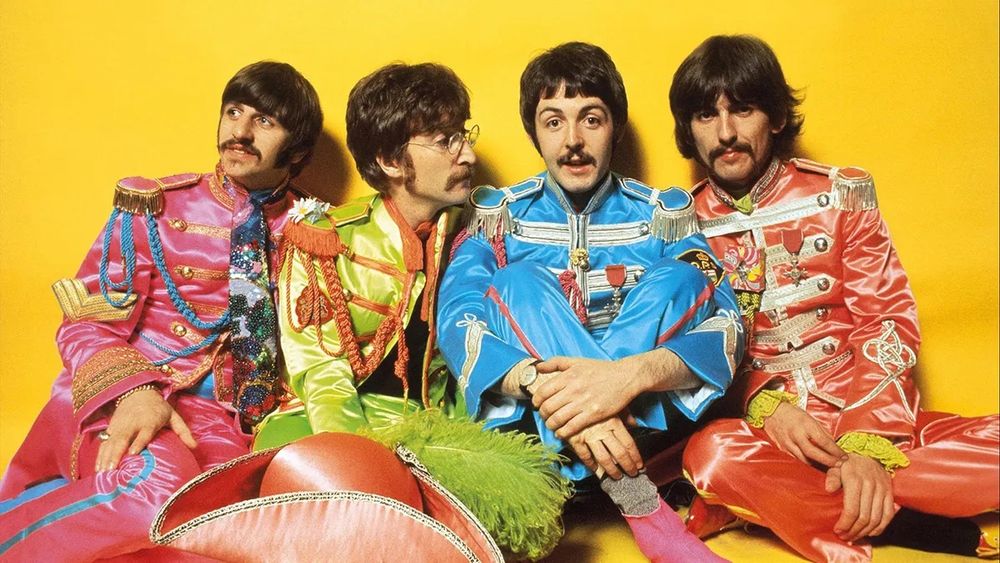
The Beatles in Full Technicolor – Icons of the Summer of Love
This vivid image shows The Beatles seated against a bright yellow background, dressed in the flamboyant satin military uniforms featured on the Sgt. Pepper’s Lonely Hearts Club Band album cover. From left to right: Ringo Starr in hot pink, John Lennon in lime green, Paul McCartney in sky blue, and George Harrison in crimson red. The photo was part of the official promotional campaign for the album, which released on June 1, 1967, and quickly became a cultural phenomenon. Their costumes—embellished with epaulets, tassels, and medals—were more than stage wear; they were a visual representation of the band’s departure from traditional pop and embrace of theatrical alter egos. The “Sgt. Pepper” concept allowed them to experiment musically and visually, unbound by their earlier image. This particular promotional photo became one of the defining images of the Summer of Love. It emphasized not only their new sound but also the psychedelic aesthetic and anti-establishment values of the era. Each member’s expression is relaxed yet distinct, reflecting their evolving artistic personalities. Paul’s front-facing posture with arms resting over his knees gives him a focal presence, underscoring his central role in conceptualizing the album. The bright color palette and exaggerated styling mirrored the visual experimentation of 1960s psychedelia and pushed the boundaries of what a rock band could represent. This photo helped transform The Beatles from pop celebrities into countercultural icons, reinforcing the album’s conceptual framework and its blend of surrealism, satire, and sonic adventure. Capturing the tension between playfulness and reinvention, this image became an enduring symbol of one of the most influential artistic reinventions in modern music history.

A Revolution in Packaging – Sgt. Pepper’s Gatefold and Vinyl Experience
This image showcases the Sgt. Pepper’s Lonely Hearts Club Band album in its iconic physical form: the gatefold vinyl package laid open, the black Parlophone LP prominently displayed, and colorful inserts spilling out. Released on June 1, 1967, this presentation marked a radical departure from conventional album packaging and redefined what a record could be. Inside the gatefold, a vivid portrait of the band members appears in their psychedelic military uniforms, this time against a golden yellow background. The reverse side features track listings, lyrics—a first for a major pop album—and production notes, placing emphasis on the album as a cohesive artistic statement. Surrounding the record are cut-out sheets featuring faux military badges, mustaches, and a cardboard cutout of the band’s fictional conductor, allowing fans to engage with the album’s concept in a tactile, imaginative way. Designed by artist Peter Blake and Jann Haworth, the album’s visual storytelling matched the boundary-pushing sounds etched into the vinyl grooves. The attention to detail in the packaging was revolutionary at the time, elevating the album from a mere music product to an immersive multimedia experience. The Sgt. Pepper vinyl wasn’t just heard—it was read, handled, studied, and performed with. This particular image captures that spirit of total artistry: the convergence of design, sound, and identity in a single format. With this release, The Beatles set a new standard for how albums could be conceived—as holistic works of art that invite the listener into a complete world. That ethos influenced countless musicians, designers, and fans in the decades that followed. The physical album became a canvas, a collectible, and a storytelling device. This photo crystallizes that historical moment, where pop culture met high concept and packaging became part of the performance.
On June 1, 1967, The Beatles released Sgt. Pepper’s Lonely Hearts Club Band, redefining what an album could be. With experimental sounds and iconic cover art, it marked a cultural turning point in music, psychedelia, and youth identity.
#StayCurious #Skystorians #DiveIntoDiscovery
02.06.2025 03:59 — 👍 48 🔁 14 💬 2 📌 1
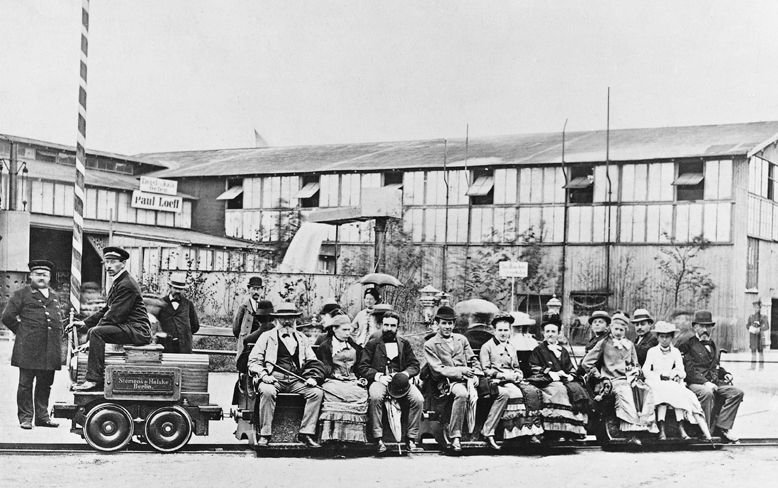
Siemens’ Electric Locomotive Debuts at Berlin Industrial Exposition, 1879
This historical photograph captures the pioneering moment when Werner von Siemens unveiled the world’s first electric locomotive at the Berlin Industrial Exposition on May 31, 1879. In the image, a group of men and women dressed in formal 19th-century attire are seated on open passenger cars attached to a small electric locomotive, which is operated by a uniformed conductor. The track appears temporary, laid for demonstration purposes, winding around a modestly constructed exhibition site filled with pavilions and signs in German. Behind the passengers, observers in hats and coats casually watch the groundbreaking trial run. What seems quaint by today’s standards was, in its time, an engineering marvel—the first time electricity powered a vehicle intended for public transport. Siemens’ locomotive was powered by a 2-horsepower electric motor drawing energy from a central power supply via rails, propelling up to 20 passengers at speeds of around 13 km/h (8 mph). Though it ran on a short 300-meter track, this prototype laid the foundation for future electric trams, underground railways, and the global electrification of mass transit. The demonstration captivated industrialists, inventors, and engineers from across Europe, showing that electric propulsion was not only viable but also cleaner and quieter than steam. Siemens’ work would inspire further innovation, including electric streetcars and subway systems in major cities around the world by the early 20th century. This photo, though static, represents the spark of a transportation revolution—one that continues to evolve in the age of high-speed rail and sustainable energy. The locomotive itself survives today as a preserved relic in the Deutsches Technikmuseum in Berlin, serving as a tangible symbol of this momentous technological leap.
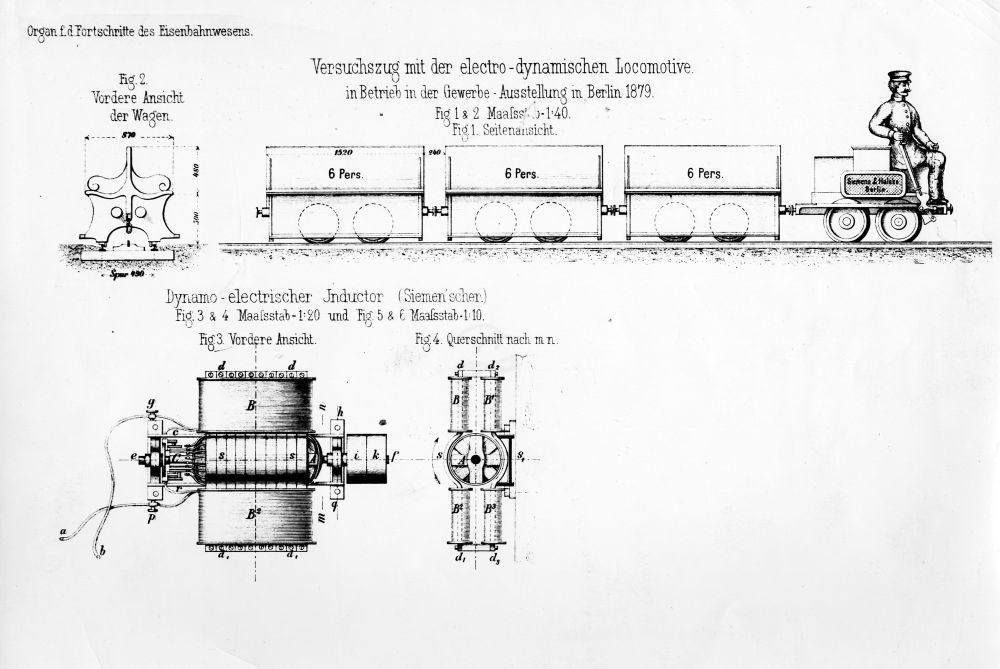
Technical Blueprint of the Siemens Electric Locomotive (1879)
This historical engineering diagram showcases the technical plans of the world’s first electric locomotive, designed by German inventor Werner von Siemens and unveiled at the Berlin Industrial Exposition on May 31, 1879. The upper portion of the schematic presents a side elevation and frontal view of the locomotive with two open passenger cars labeled “6 Pers.”—indicating their capacity to seat six individuals each. The compact locomotive is depicted with a uniformed operator sitting atop a small control bench, its boxy structure housing the electromechanical components beneath. The blueprint includes precise German annotations and measurements, such as “Maassstab 1:40” (scale 1:40), reflecting the locomotive’s dimensions and alignment with industrial standards of the time. Below, cross-sectional views reveal the design of Siemens’ pioneering dynamo-electric inductor. This central innovation transformed mechanical energy into electric current using electromagnetic induction—a principle critical not only to locomotion but also to the broader field of electrical engineering. The labeled components, including coils, shafts, and brushes, are laid out with meticulous care, reflecting the precision and ambition behind Siemens’ creation. Published in the Organ für die Fortschritte des Eisenbahnwesens (“Journal for the Advancement of Railway Technology”), the blueprint served not only as documentation but also as an invitation for engineers and industrialists to imagine new applications of electric transit. At the time, steam engines dominated rail transport, but they were noisy, polluting, and inefficient in urban contexts. Siemens’ electric locomotive offered a silent, smoke-free alternative, and this diagram laid bare the technological promise of electrification.
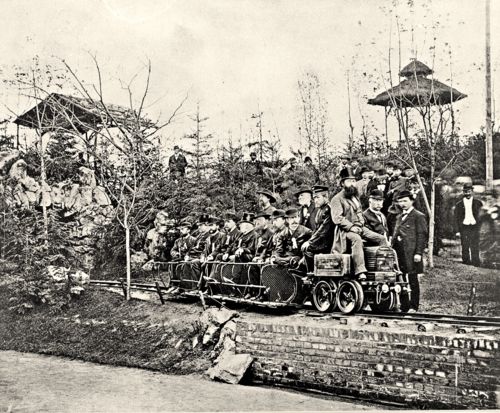
Siemens Electric Locomotive Demonstration at the 1879 Berlin Industrial Exposition
This photograph captures a pivotal moment in the history of transportation: the public demonstration of Werner von Siemens’ electric locomotive at the Berlin Industrial Exposition in 1879. Taken outdoors on a narrow-gauge test track constructed specifically for the event, the image shows the small electric locomotive—bearing the name “Siemens & Halske Berlin”—pulling a procession of passenger cars filled with dignitaries, engineers, and curious onlookers. The locomotive is driven by an operator seated upright at the front, hands on the controls, while Siemens himself is believed to be among the men overseeing the demonstration to the left. Visitors, mostly men in top hats and long coats, are packed closely on the open railcars, some appearing skeptical, others smiling in awe. In the background, trees and viewing platforms are filled with additional observers, and makeshift structures frame the pathway, suggesting the festive and experimental atmosphere of a world’s fair. The modest size of the locomotive stands in stark contrast to its groundbreaking implications. Powered by a 2-horsepower direct current motor supplied through a third rail—visible beneath the track—this prototype was capable of hauling up to 18 passengers at a time over a short loop. It was the first time in recorded history that electricity had been successfully used to propel a vehicle along a track with passengers aboard. The demonstration amazed thousands and sparked global interest in electrified rail systems. More than a novelty, this event planted the seeds of what would later become city streetcars, subways, and electric interurban trains. It marked the shift from coal-driven to current-driven transit, laying foundations for the modernization of global infrastructure. Siemens’ contribution, vividly brought to life in this image, redefined the boundaries of what was technologically possible in public transport
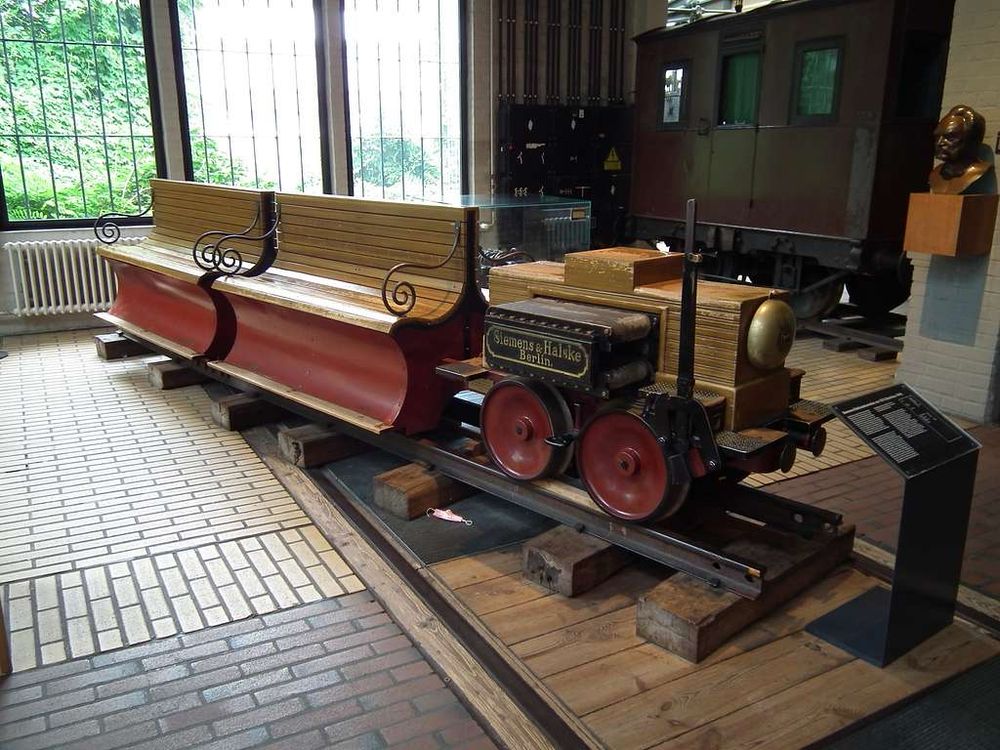
The World’s 1st Electric Locomotive Displayed at the German Museum of Technology
This image shows the preserved Siemens electric locomotive from 1879, housed at the German Museum of Technology in Berlin. The compact, wood-paneled locomotive, marked “Siemens & Halske Berlin,” sits on short rails within a polished exhibition room featuring historical rail artifacts and natural light filtering through iron-framed windows. With four small iron wheels and a brass cylinder casing, the locomotive’s design reflects both simplicity and mechanical ingenuity. Attached is an open-air bench car with finely finished wood seating and decorative wrought-iron side scrolls, designed to carry several passengers in rows. The locomotive and car rest on wooden supports to preserve their condition, and a black interpretive placard stands to the right, offering historical context for visitors
Unveiled on May 31, 1879, at the Berlin Industrial Exhibition, this locomotive was designed by German engineer Werner von Siemens. It ran on a 300-meter circular track and drew electricity from a third rail, not overhead wires—an experimental design choice that emphasized efficiency and novelty. Over 86,000 people rode the train during the exhibition, providing proof of concept for electric-powered transport. The motor used a direct current system powered by an external generator, setting a foundational standard for electric transit systems
This marked a pivotal transition away from steam propulsion, opening the door for electric trams, subways, and light rail networks that would revolutionize urban infrastructure worldwide. The locomotive didn’t just carry passengers—it carried society into a new era of motion, one defined by clean energy, reduced urban pollution, and the scalable electrification of transportation. As cities around the world now return to electric transit in pursuit of sustainable development, this artifact remains a powerful symbol of innovation’s potential to reshape daily life
On May 31, 1879, Werner von Siemens unveiled the first electric locomotive in Berlin. This innovation sparked a revolution in rail transport, paving the way for electric trams and trains that would reshape cities and modern mobility.
#StayCurious #Skystorians #DiveIntoDiscovery
01.06.2025 01:27 — 👍 34 🔁 10 💬 1 📌 0
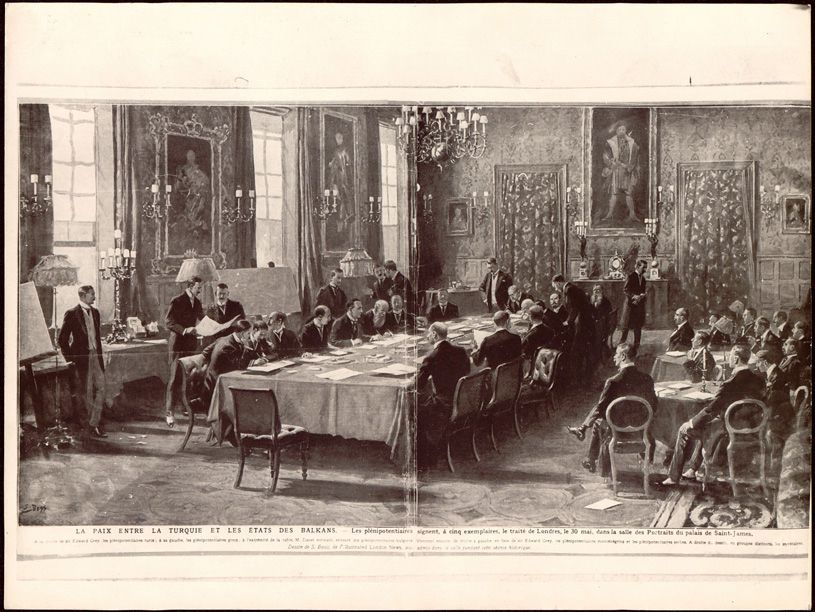
Signing of the Treaty of London – The End of the First Balkan War (1913)
This detailed illustration captures the pivotal moment on May 30, 1913, when representatives from the Balkan League and the Ottoman Empire convened in the opulent Portrait Gallery of St. James’s Palace in London to sign the Treaty of London, officially ending the First Balkan War. The setting exudes the formality and high stakes of early 20th-century diplomacy, with its grand chandeliers, richly patterned drapes, and regal portraits towering over the assembled statesmen. Seated at the table are envoys from the victorious Balkan states—Greece, Serbia, Bulgaria, and Montenegro—as well as Ottoman delegates and mediating powers such as the United Kingdom. These negotiators deliberated the fate of Ottoman territories in Europe after a brutal seven-month conflict that saw the Balkan League decisively defeat the Ottoman Empire, exposing the weakening grip of a centuries-old power.
The Treaty of London redrew the geopolitical map of the Balkans. The Ottoman Empire lost nearly all of its European holdings west of the Enos-Midia line, retaining only a sliver of Eastern Thrace around Constantinople (now Istanbul). The image documents a moment filled with both triumph and uncertainty. While the Balkan states had achieved their military aims, the conference failed to resolve underlying tensions—particularly disputes between Bulgaria and its former allies over territorial gains in Macedonia. These unresolved conflicts would soon erupt into the Second Balkan War later that same year.
This event was more than a regional affair; it was a signal to Europe that the balance of power in the Balkans was rapidly shifting. The vacuum left by the Ottoman retreat, combined with rising nationalism and Great Power rivalries, contributed directly to the chain of events that would spark World War I the following year.

Territorial Shifts in the Balkans After the Treaty of London (1913)
This map comparison offers a visual representation of the dramatic changes brought about by the Treaty of London, signed on May 30, 1913, which concluded the First Balkan War. The top half of the image reflects the pre-war territorial claims and control, while the lower half illustrates the post-treaty landscape after the Ottoman Empire ceded nearly all of its European territories. Prior to the treaty, much of the Balkans remained under Ottoman dominion, with regions like Macedonia, Thrace, and Epirus still tightly integrated into the empire’s administrative framework. However, the swift and decisive victories by the Balkan League—comprising Serbia, Greece, Bulgaria, and Montenegro—resulted in a sweeping transformation of regional boundaries
The darker shaded areas on the second map highlight the lands annexed or claimed by each Balkan nation following the treaty. Serbia significantly expanded southward into Kosovo and parts of Macedonia. Greece secured control over Thessaloniki and Crete, while Montenegro added portions of northern Albania and Herzegovina. Bulgaria, though gaining significant territory in Thrace and parts of Macedonia, would soon grow dissatisfied with the settlement, leading to the outbreak of the Second Balkan War just a month later. The Ottoman Empire, meanwhile, retained only a narrow corridor in Eastern Thrace, including the fortified city of Adrianople (Edirne), as the border was drawn along the Enos-Midia line
The contrast between the two maps underscores how the First Balkan War dismantled centuries of Ottoman hegemony in southeastern Europe. While the Treaty of London was intended to bring lasting peace, the division of spoils among former allies sowed deeper discord, fueling future regional instability. These rapidly shifting borders laid the groundwork for the Second Balkan War and amplified the nationalist tensions that would soon draw Europe into the First World War
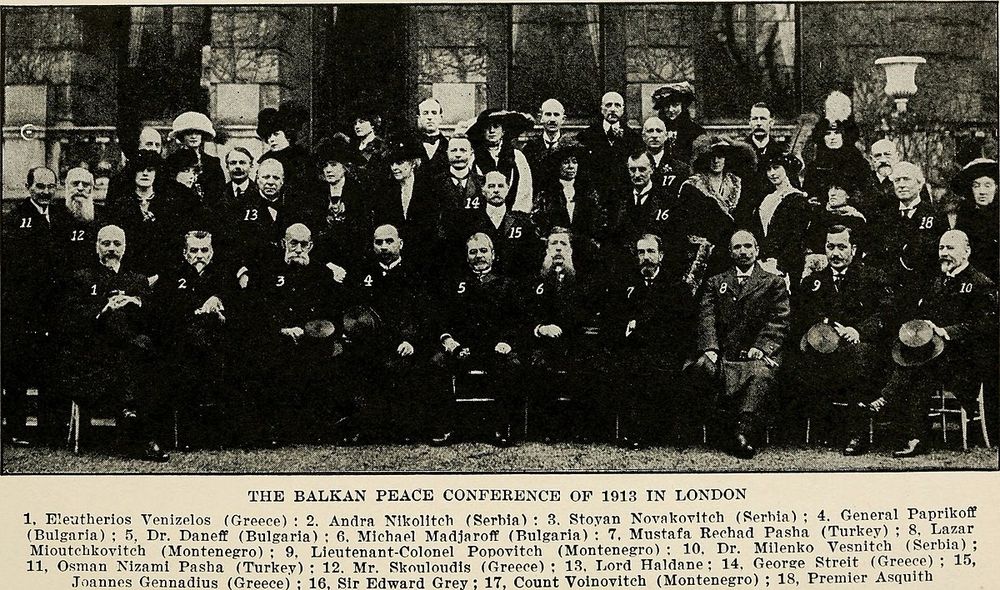
Delegates of the 1913 Balkan Peace Conference in London
This historic photograph captures the assembled delegates of the Balkan Peace Conference of 1913 in London, convened to negotiate and finalize the Treaty of London following the end of the First Balkan War. Seated and standing are statesmen, diplomats, military officers, and political leaders from the countries involved in the conflict—primarily the members of the Balkan League (Greece, Serbia, Montenegro, and Bulgaria) and representatives of the fading Ottoman Empire. The peace talks, hosted in the prestigious St. James’s Palace and overseen by major European powers, were aimed at redrawing borders in southeastern Europe after the collapse of Ottoman military resistance in the Balkans.
In the image, the numbered key below the photograph identifies many of the key figures. Among them is Eleftherios Venizelos of Greece (1), a pivotal architect of Greek military and diplomatic strategy, seated beside Serbian, Bulgarian, Montenegrin, and Turkish delegates. Sir Edward Grey (16), the British Foreign Secretary, played a crucial role as a mediator during the negotiations. The diversity of attire—from military uniforms to formal diplomatic wear—underscores the blend of martial and political influence shaping the post-war landscape.
Though the image conveys a moment of unity, tensions simmered just beneath the surface. Bulgaria, dissatisfied with the division of Macedonia, would soon wage war against its former allies, initiating the Second Balkan War less than two months after this photograph was taken.
This image is more than a diplomatic portrait; it is a snapshot of a crucial moment when old empires crumbled, new borders emerged, and Europe edged closer to a continent-wide conflagration. It illustrates how diplomacy, even when conducted in ornate chambers with handshakes and signatures, can be both the end of one war and the prelude to another.

Post-War Balkan Borders and the Legacy of the Treaty of London (1913)
This modern infographic visually reconstructs the geopolitical landscape of the Balkans immediately following the First Balkan War (1912–1913), finalized by the Treaty of London signed on May 30, 1913. The map provides a clear, color-coded representation of the territorial gains and losses among the Balkan states and the Ottoman Empire, along with concise statistics that summarize the scale and impact of the conflict. It reflects not only the battlefield results but also the complex international diplomacy that reshaped Southeast Europe during this pivotal moment in late modern history.
Each color in the map denotes a different successor state or power: the Kingdom of Serbia in deep red, the Third Bulgarian Tsardom in golden yellow, the Kingdom of Greece in navy blue, the Kingdom of Montenegro in pale blue, and the significantly diminished Ottoman territories in teal. Also featured is the newly declared Independent Albania, shown in orange, which was recognized under intense international pressure—particularly from Austria-Hungary and Italy—despite regional contestation over its borders.
Accompanying the visual are wartime statistics: over 749,000 Balkan League soldiers engaged the Ottoman Empire’s 437,000 troops. The resulting human cost was staggering—more than 100,000 casualties for the Balkan League and over 340,000 for the Ottomans. The graphic also draws attention to one of the Treaty’s most consequential results: the fate of Albania and Macedonia. These contested territories became flashpoints, with Albania’s borders left unsettled and Macedonia divided primarily between Greece and Serbia, sparking tensions that contributed directly to the Second Balkan War.
The Treaty of London was meant to restore peace, but the rigid redivision of ethnic and cultural communities created lingering grievances.
On May 30, 1913, the Treaty of London ended the First Balkan War. The Ottoman Empire ceded much of its European territory, reshaping the Balkans and laying geopolitical groundwork that would later feed into the tensions of World War I.
#StayCurious #Skystorians #DiveIntoDiscovery
30.05.2025 23:53 — 👍 16 🔁 4 💬 0 📌 0
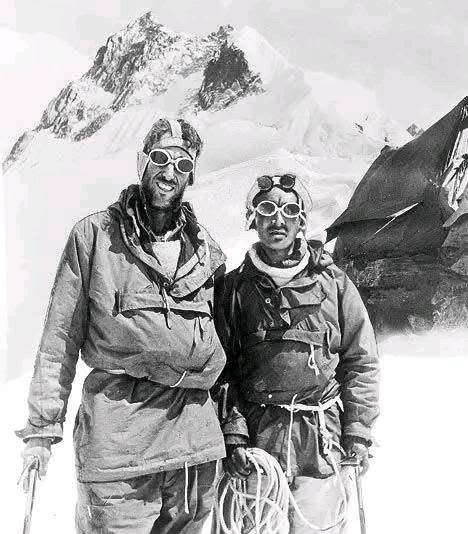
Triumph at the Roof of the World – Hillary and Norgay on Everest (1953)
This iconic photograph captures Sir Edmund Hillary of New Zealand and Tenzing Norgay, a Sherpa of Nepalese and Tibetan heritage, standing triumphantly on the slopes of Mount Everest in the days surrounding their historic ascent on May 29, 1953. Dressed in heavy expedition gear—bulky jackets, protective snow goggles, and ropes coiled at their waists—the duo exudes the physical exhaustion and immense pride that followed their unparalleled achievement. Behind them, the craggy, wind-swept Himalayan peaks loom with an almost spiritual intensity, emphasizing the magnitude of what they had just conquered. Their success marked the first confirmed summit of the world’s highest mountain, a feat long considered the ultimate challenge in mountaineering.
The photograph is a testament not only to their courage and endurance but also to the culmination of years of evolving mountaineering technology. Lightweight but thermally resilient gear, custom oxygen systems, and advancements in high-altitude medicine made this mission possible—tools unavailable to early 20th-century Everest expeditions. Perhaps even more vital was the partnership itself: Hillary, a trained beekeeper turned climber, and Norgay, whose intimate knowledge of the Himalayas and unmatched strength at high altitude had made him essential on previous missions. Their collaboration symbolized the unification of Western exploration and indigenous expertise at a time when such recognition was rare. This image remains one of the most enduring representations of human tenacity, scientific progress, and cross-cultural unity in the face of nature’s most unforgiving extremes.

Above the Clouds – The Summit Moment of Everest’s First Ascent (1953)
This rare color photograph captures Sir Edmund Hillary and Tenzing Norgay near the summit of Mount Everest on May 29, 1953, during their groundbreaking ascent. Surrounded by a breathtaking panorama of snow-covered Himalayan peaks and a sea of clouds stretching endlessly below, the climbers are seen adjusting gear and taking brief respite after reaching the world’s highest point. Both are dressed in thick, insulated clothing—Hillary in a dark blue down suit and Norgay in a mustard yellow jacket—with oxygen masks and tanks secured, highlighting the crucial role technology played in their success. The scene is one of awe, exhaustion, and triumph, symbolizing the moment humankind first stood atop the 8,848-meter giant.
Though lacking in modern satellite communications and GPS, the 1953 British expedition relied on innovative equipment for the time. New designs in oxygen delivery systems made high-altitude survival viable; clothing composed of lightweight synthetic and natural fibers allowed better movement while retaining warmth. This photo immortalizes not just their physical ascent, but a technological and logistical victory that opened new frontiers in mountaineering. It also underscores the equal credit both men received in the wake of their feat, though later records clarified that Hillary was the first to step on the summit. Tenzing’s achievement—breaking barriers for indigenous Sherpas often relegated to supporting roles—elevated him to national hero status in Nepal and India. Their teamwork, captured at this thin-aired pinnacle of the world, remains an enduring example of what’s possible when resilience, trust, and innovation unite in the harshest environments Earth has to offer.

A Pause in the Death Zone – Humanity at the Edge of the World (1953)
In this colorized photograph taken during the 1953 British Mount Everest expedition, Tenzing Norgay and Sir Edmund Hillary sit outside a canvas tent nestled amid snow and ice, resting at one of the final high camps below the summit. The two men, clad in thick layers of wool and insulated jackets, cradle metal mugs—likely filled with warm tea or soup—symbolizing a rare moment of calm and human warmth in the perilous “death zone,” where oxygen levels are dangerously low and every movement drains energy. Ropes, oxygen canisters, and gear lie scattered around their boots, the organized chaos of a life lived on the edge. The diffused sunlight filtering into the frame, reflecting off snowy cliffs, imbues the image with a quiet dignity—a contrast to the monumental effort unfolding just beyond the camera’s reach.
This camp was one of several carefully staged support points designed by expedition leader John Hunt and his team. The use of supplemental oxygen, developed and refined by British engineers, played a critical role in enabling Hillary and Norgay to survive and thrive at such extreme altitudes. Their ability to pause, hydrate, and recover in such a hostile setting speaks not only to their individual strength but also to the detailed planning and teamwork that underpinned the expedition’s success. Moreover, the image hints at the often under-acknowledged labor of Sherpas like Norgay, whose intimate knowledge of the mountain and quiet endurance made the feat possible. In this photograph, we see not two legendary climbers poised for glory, but two men stripped to their essentials—sharing silence, struggle, and strength in a frozen world where life clings by threads.
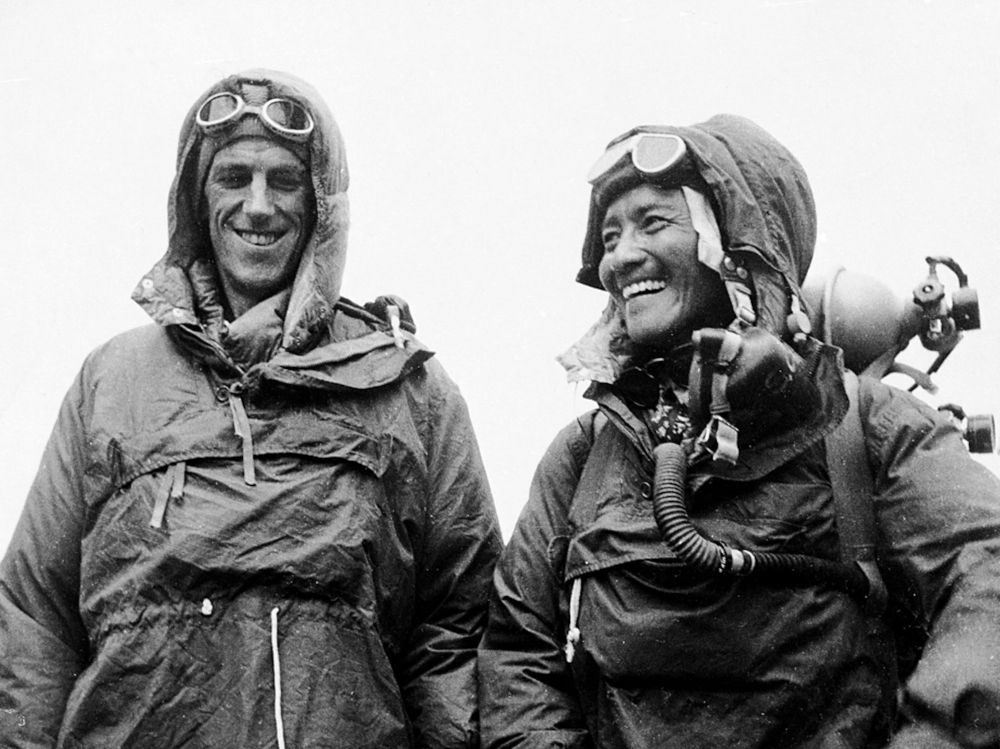
Triumph on the Summit – The First Ascent of Everest (1953)
In this iconic black-and-white photograph taken on May 29, 1953, Sir Edmund Hillary of New Zealand and Tenzing Norgay of Nepal stand atop Mount Everest, having just achieved the first confirmed summit of the world’s highest peak. Both men wear heavy-duty climbing parkas and hoods, their faces radiant with joy and exhaustion. Snow goggles rest atop their foreheads, while coiled ropes, carabiners, and oxygen tanks cling to their chests, marking the technological endurance that supported their success. Despite the harsh conditions and the thinning air of the so-called “death zone” at over 29,000 feet (8,848 meters), their smiles beam with the profound satisfaction of accomplishing what many had deemed impossible.
This moment represents far more than a physical victory. Their ascent came at the tail end of Britain’s extensive Himalayan expeditions, a legacy of geopolitical and scientific ambitions. While Hillary’s name became globally synonymous with Everest, the inclusion and critical contributions of Tenzing Norgay, a Sherpa of humble beginnings, began to shift how the world recognized indigenous expertise in mountaineering. Norgay’s knowledge of the mountain, refined over years of high-altitude portering, was indispensable to the climb’s logistics and safety. Their successful use of closed-circuit oxygen systems—then a cutting-edge adaptation—allowed them to survive and move efficiently through extreme altitudes where atmospheric oxygen drops to just a third of sea-level levels.
The image also captures a pivotal cultural moment: a powerful symbol of international cooperation and technological triumph during a Cold War era that had otherwise been dominated by nationalist competition. Together, Hillary and Norgay stood not just on top of the world, but at the intersection of human spirit, science, and global admiration.
On May 29, 1953, Edmund Hillary and Tenzing Norgay became the first to summit Mount Everest. Their feat symbolized human endurance, international cooperation, and the triumph of modern mountaineering technology.
#StayCurious #Skystorians #DiveIntoDiscovery
29.05.2025 23:12 — 👍 19 🔁 3 💬 1 📌 0
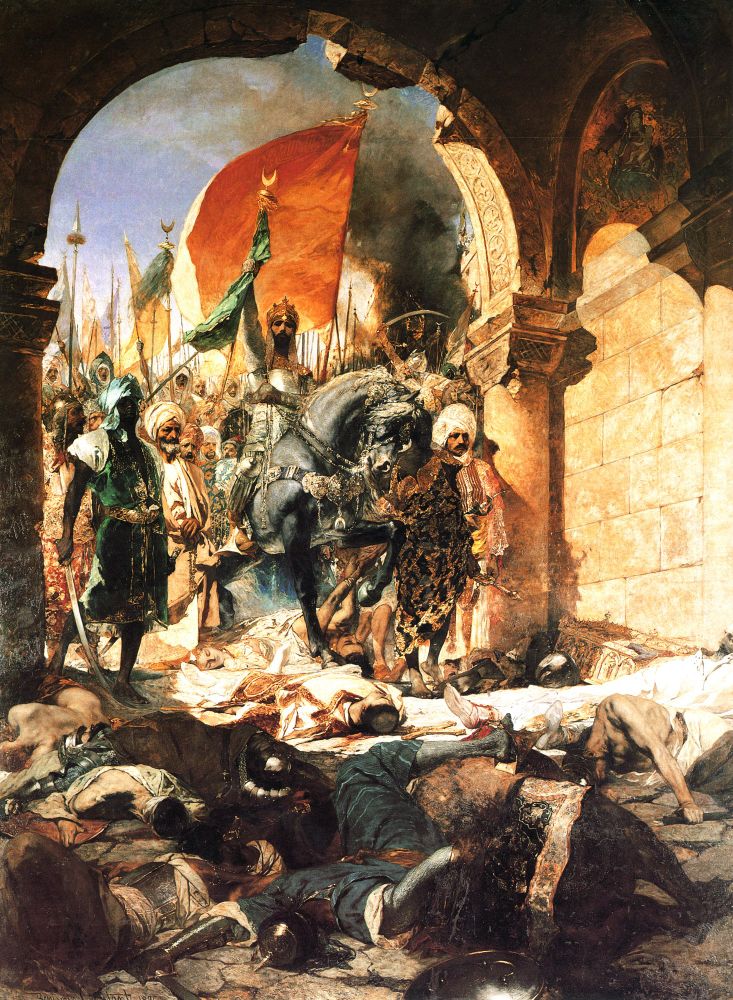
The Fall of Constantinople – The End of Byzantium and Dawn of a New Era
This dramatic painting captures the decisive moment on May 29, 1453, when Ottoman forces, led by Sultan Mehmed II, stormed Constantinople and brought an end to the Byzantine Empire. In this scene, Mehmed II is depicted astride a powerful warhorse, flanked by Ottoman soldiers carrying the crescent banner of Islam. Their faces are resolute, emerging from the smoky ruins of the city’s walls, which have been breached after a 53-day siege. Beneath the archway, the fallen defenders of Constantinople—some armored, some robed—lie scattered in defeat, symbolizing the collapse of a thousand-year-old Christian empire. The image conveys a stark contrast: the triumphant, orderly procession of the Ottomans against the chaos and devastation surrounding the defenders’ final stand. The moment marks a critical turning point in world history. Constantinople, once the eastern bastion of Christendom and the cultural heart of the Byzantine Empire, was transformed into Istanbul, the new capital of the burgeoning Ottoman Empire. Its fall reverberated far beyond the battlefield, disrupting trade routes to Asia and prompting European powers to seek new maritime paths—sparking the Age of Exploration. This conquest not only redefined geopolitical borders but also served as a powerful symbol of the transition from the medieval world to the early modern era. Through the lens of this painting, we glimpse the profound cultural, religious, and technological shifts that followed the collapse of Byzantium and the rise of Ottoman dominance.
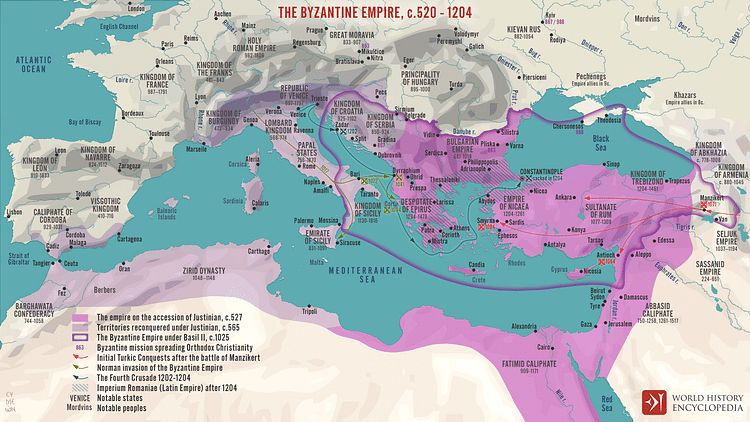
Mapping Byzantium – The Byzantine Empire Before the Fall
This detailed historical map illustrates the extent and gradual contraction of the Byzantine Empire from around 520 to 1204 CE, offering crucial geographic context to the eventual fall of Constantinople in 1453. At its height, the Byzantine Empire—shown here in rich hues of purple and blue—stretched across vast portions of Southern Europe, North Africa, and the Eastern Mediterranean, representing the continuation of the Eastern Roman Empire after the fall of Rome. Notably, the map highlights key regions such as Anatolia, Greece, the Levant, and parts of Italy, all formerly under Byzantine control. Arrows and color-coded overlays chart the ebb and flow of territorial control, from the reconquests of Emperor Justinian I to the territorial losses after the pivotal Battle of Manzikert in 1071 and the Fourth Crusade’s sacking of Constantinople in 1204. By the time of Mehmed II’s siege, the Byzantine Empire had been reduced to little more than the fortified city of Constantinople itself, an isolated remnant of a once-mighty dominion. The surrounding regions had been absorbed by rising powers, including the Seljuk Turks and, most notably, the Ottomans. This map serves as a sobering visual of imperial decline, illustrating how centuries of external invasion, internal strife, and shifting alliances steadily eroded Byzantine sovereignty. By 1453, Constantinople was no longer a seat of a robust empire but a symbolic stronghold awaiting its final chapter. This image deepens the historical resonance of May 29, underscoring how the fall of a single city marked the end of an era shaped by Roman legacy, Orthodox Christianity, and imperial resilience.
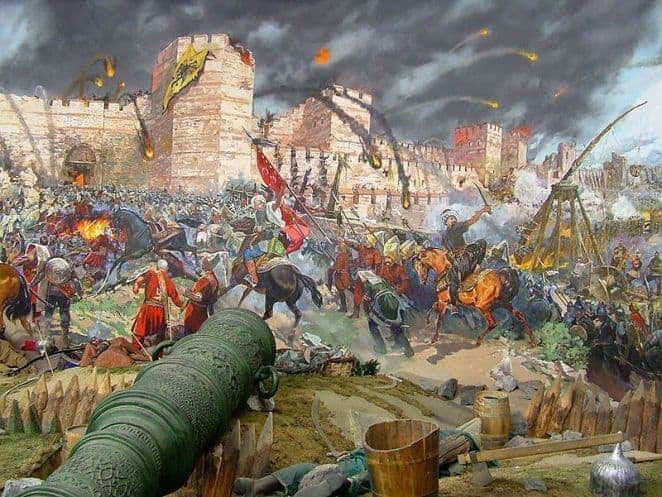
The Siege of Constantinople – The Final Assault of 1453
This dynamic image vividly captures the climactic moment of the Ottoman Empire’s final assault on Constantinople on May 29, 1453. Painted as a dramatic battlefield panorama, it showcases the chaos, fury, and technological power that defined one of the most consequential sieges in world history. In the foreground, massive Ottoman cannons—most notably the legendary bombard designed by Hungarian engineer Orban—dominate the scene, symbolizing the game-changing use of gunpowder artillery that ultimately shattered the once-impregnable Theodosian Walls. Behind them, Ottoman soldiers surge forward on horseback and foot, wielding swords and banners, while fiery projectiles arc through the sky amid smoke and destruction. The defenders of Constantinople, vastly outnumbered and outgunned, are shown making a last desperate stand. This was the final defense of a city that had stood for over a millennium as the heart of Eastern Christianity and Roman legacy. Sultan Mehmed II’s forces included not only Turks but a multiethnic army drawn from across the empire, reflecting the Ottomans’ rising cosmopolitan might. Inside the city, panic reigned as centuries-old structures fell and residents fled or fought. The fall of Constantinople marked not only the death knell of the Byzantine Empire but also a profound geopolitical shift: with the Ottomans now in control of the Bosphorus, European states faced restricted access to Eastern trade routes. This moment accelerated the search for alternative paths to Asia, sparking the Age of Exploration. The image immerses viewers in the thunderous final charge of an empire’s end and the dawn of a new global order forged through conquest, technology, and cultural transformation.

Ottoman Expansion After the Fall of Constantinople
This historical map visualizes the vast territorial growth of the Ottoman Empire from its origins in 1300 through its height in the 17th century, with particular emphasis on the aftermath of the 1453 conquest of Constantinople. Color-coded regions trace each major phase of expansion under successive sultans, beginning with the modest holdings of the early Ottomans in northwestern Anatolia (shown in dark brown), extending through Mehmed II’s rapid acquisitions (in purple) following his decisive capture of the Byzantine capital. The seizure of Constantinople not only marked the death of the Byzantine Empire but also became the launchpad for an imperial campaign that would absorb much of the Balkans, Eastern Europe, and the Arab world. The map highlights how Mehmed II consolidated the city—renamed Istanbul—as his imperial seat, transforming it into a cosmopolitan center of Islamic power, commerce, and scholarship. From there, the Ottomans expanded across Greece, Serbia, and Hungary, confronting Christian Europe while simultaneously conquering Muslim territories in the Middle East and North Africa. Later rulers such as Selim I and Suleiman the Magnificent further extended the empire’s reach into Egypt, Arabia, and deep into the heart of Europe. The red boundary line traces the empire at its greatest territorial extent between 1683 and 1699, when it stretched from Algiers to the Persian Gulf and from the Danube to Mecca. This visualization underscores how the fall of Constantinople was more than a singular conquest—it was a strategic and symbolic moment that transformed the Ottomans from regional power to global empire, changing the course of Eurasian history and global trade for centuries to come.
On May 29, 1453, Constantinople fell to the Ottoman Empire after a 53-day siege. The fall ended the Byzantine Empire, transformed the city into Istanbul, and marked a pivotal shift in global trade and power dynamics.
#StayCurious #Skystorians #DiveIntoDiscovery
29.05.2025 22:53 — 👍 24 🔁 4 💬 1 📌 1
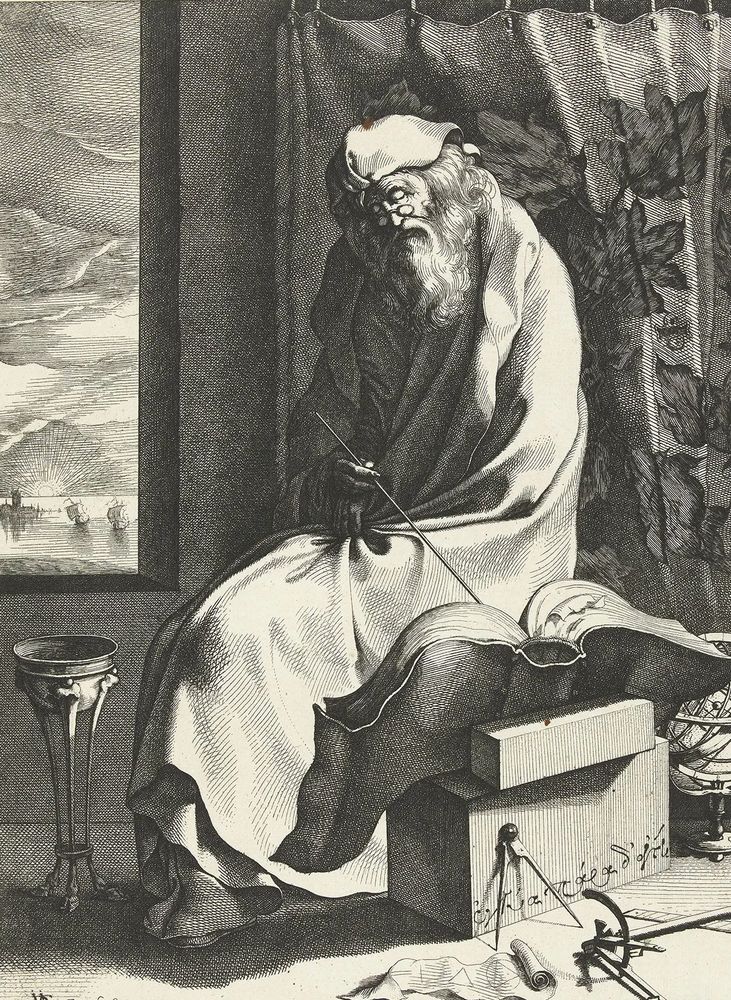
Thales of Miletus and the Eclipse That Stopped a War
This detailed engraving presents the Greek philosopher Thales of Miletus, depicted in scholarly solitude surrounded by scientific instruments, symbolizing his pioneering influence in natural philosophy and early astronomy. Draped in heavy robes with a scroll and compass at his side, Thales gazes contemplatively at a distant horizon—possibly evoking the eclipse he famously predicted. On May 28, 585 BCE, during a fierce battle between the Lydians and the Medes in Anatolia (modern-day Turkey), a sudden total solar eclipse plunged the battlefield into darkness. The celestial event—so dramatic and inexplicable to the soldiers—was interpreted as a divine omen, prompting an immediate ceasefire. Thales’ prediction of the eclipse stands as one of the earliest known applications of scientific reasoning to foresee natural phenomena, and his role in the event elevated him in ancient thought as a bridge between mythos and logos. This moment is not only a testament to ancient Greek advancements in astronomy and mathematics, but also a rare historical instance where science directly altered the course of warfare. By capturing Thales with tools of geometry and celestial observation, the image emphasizes his legacy as the first recorded individual to predict a solar eclipse, shaping humanity’s understanding of the cosmos. The illustration merges realism with allegory, celebrating an event where intellectual insight eclipsed the violence of war, forever enshrining Thales as a foundational figure in both philosophy and scientific history.
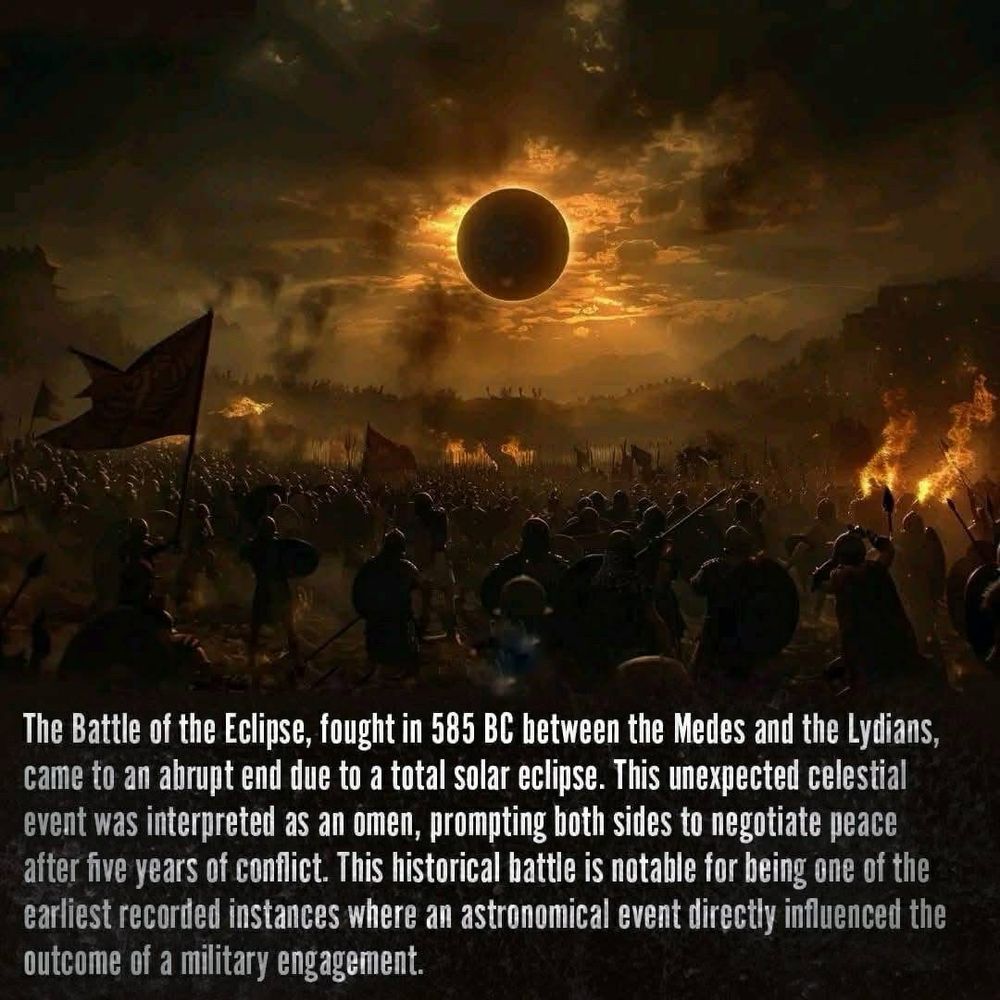
The Battle Beneath the Black Sun – Eclipse of 585 BCE
This dramatic digital artwork captures the surreal moment during the Battle of the Eclipse on May 28, 585 BCE, when a total solar eclipse abruptly halted combat between the Medes and the Lydians. In the foreground, thousands of ancient soldiers clad in bronze armor and gripping spears and shields are frozen mid-conflict as an ominous dark sun dominates the sky above. The eclipse bathes the entire battlefield in an eerie orange glow, with silhouettes of flags, weapons, and plumes of smoke intensifying the sense of awe and confusion. Fire blazes across the horizon, emphasizing the chaos of war interrupted by cosmic wonder. This historically significant moment marked one of the earliest known instances where an astronomical event directly impacted a human conflict. The eclipse, which ancient peoples interpreted as a divine omen, led both sides to cease fighting and negotiate peace after five brutal years of warfare. Famously predicted by the Greek philosopher Thales of Miletus, this celestial phenomenon highlighted a turning point in how nature, science, and diplomacy intersected. The image embodies the profound cultural and symbolic weight of the eclipse, visually echoing how the sudden darkness transcended the battlefield and became a harbinger of peace. It stands as an artistic tribute to a moment when the heavens overshadowed the sword—reminding viewers of the unexpected ways nature can redirect human history and how observation and foresight once reshaped the destiny of nations.

Thales of Miletus – Philosopher Who Predicted the Sky
This modern artistic rendering depicts Thales of Miletus, the pre-Socratic Greek thinker widely credited as the first known philosopher and one of antiquity’s earliest scientific minds. Thales, born in the city of Miletus in Ionia (modern-day Turkey), was a polymath whose insights spanned mathematics, astronomy, and natural philosophy. His calm, analytical expression and meticulously curled beard in this image reflect the gravitas often associated with classical wisdom. The image connects directly to the momentous event of May 28, 585 BCE, when a total solar eclipse unexpectedly interrupted a fierce battle between the Medes and Lydians. Thales had reportedly predicted this celestial event—a feat considered astonishing in his time. While it is debated whether he used Babylonian eclipse cycles or intuitive reasoning, the impact of the forecast was enormous. The eclipse was interpreted by warring factions as a sign from the gods, leading both sides to lay down arms and agree to peace. This image thus symbolizes not just a historical individual but a transformative intellectual moment: the recognition that human understanding of nature could influence political decisions and human behavior. Thales’ prediction marked an early convergence of science and society, making him a pioneer of rational thought and foreshadowing centuries of philosophical and scientific inquiry. By capturing his likeness in a stylized yet dignified form, the portrait invites reflection on how one man’s knowledge of the cosmos changed the course of history, not through conquest, but through foresight and reason.

Path of the 585 BCE Total Solar Eclipse – A Celestial Trigger for Peace
This scientific diagram illustrates the path and timing of the total solar eclipse that occurred on May 28, 585 BCE, one of the earliest eclipses ever recorded with precise historical impact. The image displays a Mercator-style projection of the Earth overlaid with eclipse trajectory curves. The thick blue band marks the path of totality—where the sun was completely obscured by the moon—and it crosses over modern-day Turkey, the probable site of the battlefield between the Medes and the Lydians. The green lines represent zones of partial visibility, while pink and orange arcs trace the broader eclipse geometry across the ancient world. The notation “-0584 May 28” reflects the astronomical calendar’s year-zero correction, confirming the event’s date as May 28, 585 BCE.
What makes this eclipse extraordinary is not just its astronomy but its role in shaping human events. Predicted, according to Herodotus, by the philosopher Thales of Miletus, this eclipse occurred in the midst of a prolonged and bloody war. As the sun vanished from the sky, both armies interpreted the sudden darkness as a divine omen, prompting an immediate ceasefire and the negotiation of peace. This map therefore doesn’t merely chart a solar phenomenon—it serves as a testament to the moment science intersected with statecraft. The image affirms that early civilizations were already observing and recording celestial cycles with sufficient accuracy to affect military and diplomatic outcomes. It reflects how an understanding of natural laws—epitomized by Thales’ astronomical insight—began to influence geopolitical decisions long before the modern scientific method. In essence, the path traced here is not just the moon’s shadow but a line drawn in history where knowledge triumphed over violence.
On May 28, 585 BCE, a total solar eclipse halted a battle between the Lydians and the Medes in what is now Turkey. Predicted by Thales of Miletus, it’s one of the earliest recorded cases where science influenced diplomacy, leading to an unexpected truce.
#StayCurious #Skystorians #DiveIntoDiscovery
28.05.2025 19:35 — 👍 11 🔁 3 💬 0 📌 0

The Arrest of Slobodan Milošević – The Fall of a Former Strongman
This historic black-and-white image captures Slobodan Milošević, the former President of Serbia and the Federal Republic of Yugoslavia, being escorted by a uniformed guard during his arrest and extradition to The Hague in 2001. Clad in a dark suit and striped tie, Milošević’s downcast, stoic expression belies the gravity of the moment—a symbol of a former head of state brought under the jurisdiction of international law. Behind him, the guard’s firm grip underscores the shift from unchecked political power to judicial accountability. This moment directly connects to the landmark event of May 27, 1999, when the International Criminal Tribunal for the former Yugoslavia (ICTY) indicted Milošević for crimes against humanity, including murder, deportation, and persecution during the Kosovo conflict. It was the first time in history a sitting head of state had been charged with war crimes by an international court. The indictment marked a turning point for global justice, signaling that sovereign immunity would no longer shield leaders from prosecution for atrocities. Crucially, the ICTY’s ability to gather digital evidence, including intercepted communications, satellite imagery, and victim testimonies shared across borders, marked a new era of technology-driven accountability. The photo reflects both the fragility of power and the resilience of international legal frameworks that strive to uphold human rights in the wake of violent nationalism and war crimes. The case set precedents used later in tribunals for Rwanda, Sierra Leone, and even influenced the formation of the International Criminal Court. This image freezes the moment when justice caught up to one of the Balkans’ most controversial figures, reshaping post-Cold War perceptions of international law’s reach.
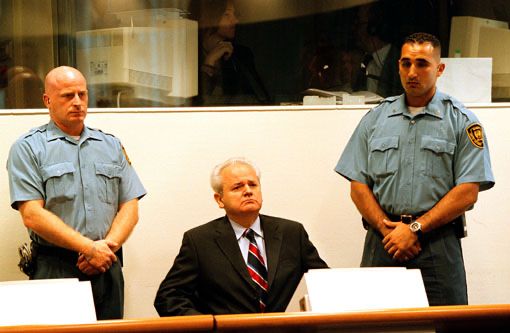
Slobodan Milošević at The Hague – A President on Trial
This striking courtroom image captures Slobodan Milošević seated at the International Criminal Tribunal for the former Yugoslavia (ICTY) in The Hague, flanked by two stern-faced UN guards. Dressed in a black suit and red-striped tie, Milošević sits upright, exuding an air of defiance. This moment represents a profound shift in the post-Cold War international order. Taken during the early stages of his trial beginning in 2002, the image reflects the unprecedented legal accountability of a former head of state for war crimes, crimes against humanity, and genocide. The May 27, 1999 indictment against Milošević, issued while he was still in power, marked the first time such charges were brought against a sitting leader. It signaled a new era in global justice, wherein no office could shield one from prosecution for atrocities. This trial was a culmination of years of conflict across the Balkans—including Bosnia, Croatia, and Kosovo—where Milošević’s policies fueled ethnic cleansing, mass deportations, and systemic violence. In the courtroom, Milošević chose to represent himself, using the global stage to project his nationalist rhetoric while attempting to delegitimize the court’s authority. Behind the symbolism of the scene is a deeper evolution: the role of digital evidence, satellite imagery, forensic data, and cross-border witness testimony transformed the landscape of accountability. The trial was streamed globally, demonstrating how international institutions were evolving into more transparent and technologically integrated systems. Though Milošević died in 2006 before a verdict was reached, his prosecution remains a milestone in enforcing international humanitarian law. The image is not just about one man—it’s a visual testament to the world’s growing commitment to holding leaders accountable, regardless of their power or influence.

Signing the Dayton Accords – Fragile Peace in the Balkans
This historic image captures the formal signing of the Dayton Peace Accords in Paris on December 14, 1995, a pivotal event that brought an end to the brutal Bosnian War. Seated at the table are three central figures: Slobodan Milošević of Serbia, Franjo Tuđman of Croatia, and Alija Izetbegović of Bosnia and Herzegovina. Their expressions range from solemn to guarded, reflecting the weight of the moment and the deep wounds left by years of ethnic conflict. Behind them stand a host of international dignitaries, including U.S. President Bill Clinton, French President Jacques Chirac, German Chancellor Helmut Kohl, and British Prime Minister John Major—underscoring the global stakes and diplomatic pressure that forged this fragile peace. The gold-lettered backdrop reads “Conférence de Paix sur L’Ex-Yougoslavie” (Peace Conference on Former Yugoslavia), reinforcing the gravity of the occasion. This agreement, brokered at Wright-Patterson Air Force Base in Dayton, Ohio, and later formalized here in Paris, ended nearly four years of warfare in Bosnia that claimed over 100,000 lives and displaced more than 2 million people. The accords created a new constitution for Bosnia and Herzegovina, dividing it into two entities: the Federation of Bosnia and Herzegovina and Republika Srpska. The image represents not only a diplomatic breakthrough but also the complexities of peacemaking in the aftermath of genocide and ethnic cleansing. Milošević’s presence at the table would soon become symbolic—just four years later, he would be indicted for war crimes by the ICTY. This moment stands at the crossroads of diplomacy and justice, where peace was prioritized over punishment, at least temporarily. It marks the beginning of a post-war reconstruction era and serves as a visual reminder of both the power and limits of international negotiation in ending deeply entrenched conflicts.

The Dayton Accords in Action – A Closer Look at Balkan Leaders & International Diplomats
This image captures a pivotal moment during the signing of the Dayton Peace Accords, a diplomatic agreement that officially ended the Bosnian War. At the center sits Slobodan Milošević of Serbia, deeply focused as he signs the document that would shape the future of the Balkans. Beside him are key leaders: Croatian President Franjo Tuđman and Bosnian President Alija Izetbegović, each representing opposing sides in one of the most devastating conflicts in post–Cold War Europe. Surrounding the main signatories are a host of aides and international negotiators, notably U.S. diplomat Richard Holbrooke and members of the European Union, guiding and observing the process with intense concentration. This captures not just signatures, but the delicate choreography of peace-making: every pen stroke and whispered consultation speaks to years of bloodshed, political maneuvering, and international intervention. Held in Dayton, Ohio, and finalized here in Paris in December 1995, the agreement ended a conflict that killed more than 100,000 people and displaced over two million. This image reflects the immense global effort to bring the war to a close, including the involvement of the United States, NATO, the EU, and the United Nations. Yet, the moment is also steeped in ambiguity—though it halted the violence, the Dayton Accords institutionalized ethnic divisions within Bosnia and Herzegovina’s governance structure. The contrast between weary Balkan leaders and composed Western diplomats is stark, symbolizing the imbalance of power and the external pressures that shaped the treaty. Milošević, in particular, appears pensive—his role in the war, once obscured by diplomacy, would soon be exposed on a world stage as the ICTY indicted him for crimes against humanity. This marked the beginning of a complex peace, built atop compromise, loss, and fragile hope for a multiethnic future in the Balkans
On May 27, 1999, Slobodan Milošević became the first sitting head of state indicted for war crimes. Enabled by tech-driven evidence gathering, his case marked a turning point in global accountability and international justice.
#StayCurious #Skystorians #DiveIntoDiscovery
27.05.2025 17:48 — 👍 14 🔁 6 💬 3 📌 1

The Bismarck Sets Sail — Prelude to the Hunt
This historic black-and-white photograph captures the German battleship Bismarck as it departs from port on May 19, 1941, launching one of the most infamous naval operations of World War II. Towering at the center of the frame, the Bismarck exudes sheer military might, with its heavily armored hull, massive primary gun turrets, and complex radar and communications rigging prominently visible. Tugboats assist her movement, while a plume of smoke rises from a support ship in the background, symbolizing the tense departure into open waters. This image encapsulates a moment just before history would take a dramatic turn. At over 50,000 tons and equipped with 15-inch guns, the Bismarck was designed as a strategic weapon to disrupt Allied supply lines in the Atlantic. Her breakout from Gotenhafen into the North Sea—code-named Operation Rheinübung—would trigger a relentless pursuit by the Royal Navy. Less than ten days later, the ship would be hunted down and sunk after destroying HMS Hood, the pride of the British fleet. The image evokes not just the engineering prowess of Nazi Germany, but also the fragile supremacy of battleship warfare in an era increasingly defined by air power and radar-guided detection. The serene waters surrounding the vessel starkly contrast with the chaos and destruction that would soon follow. This departure marked the beginning of the Bismarck’s short but devastating legacy, which would culminate in her destruction on May 27, 1941—a symbolic victory for the British and a sobering reminder of the brutal chessboard of WWII naval conflict.
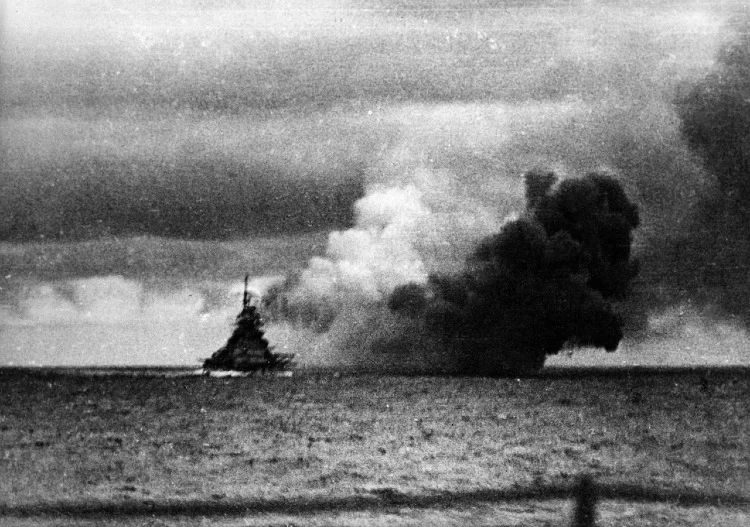
The Sinking of the Bismarck — A Final Blow in the Atlantic
This grainy black-and-white photograph captures the dramatic and chaotic moment of the German battleship Bismarck under heavy attack by British naval forces on May 27, 1941. Taken from a nearby pursuing vessel, the image freezes time as a towering column of dark smoke billows from near the ship’s stern, rising ominously against the overcast sky. The silhouette of the Bismarck can still be seen upright on the horizon, moments before her final demise. This was the climax of one of World War II’s most gripping naval chases. After sinking HMS Hood days earlier, Bismarck became the most wanted target in the Atlantic. Dozens of British warships, submarines, and reconnaissance aircraft were deployed in a relentless pursuit that spanned over 1,700 nautical miles. Crippled by a torpedo strike that jammed her rudder, Bismarck was unable to maneuver and soon faced the concentrated firepower of British battleships HMS King George V and Rodney. For over 90 minutes, she was pounded with hundreds of shells, many striking below the waterline. Yet despite the barrage, the Bismarck refused to sink. German sailors ultimately scuttled the ship to prevent her capture. Over 2,000 crewmen perished; only 114 survived. This image, stark and haunting, serves as a powerful visual of the brutal end of Germany’s most feared battleship. It also symbolized the fading dominance of the battleship era, which would soon be eclipsed by air power and submarines. For Britain, the destruction of the Bismarck was more than a strategic win—it was a morale boost in the dark days of 1941. The smoke curling into the sky is not just evidence of a naval defeat, but a turning point in maritime history, marking the end of an empire’s bold gamble on sea supremacy.
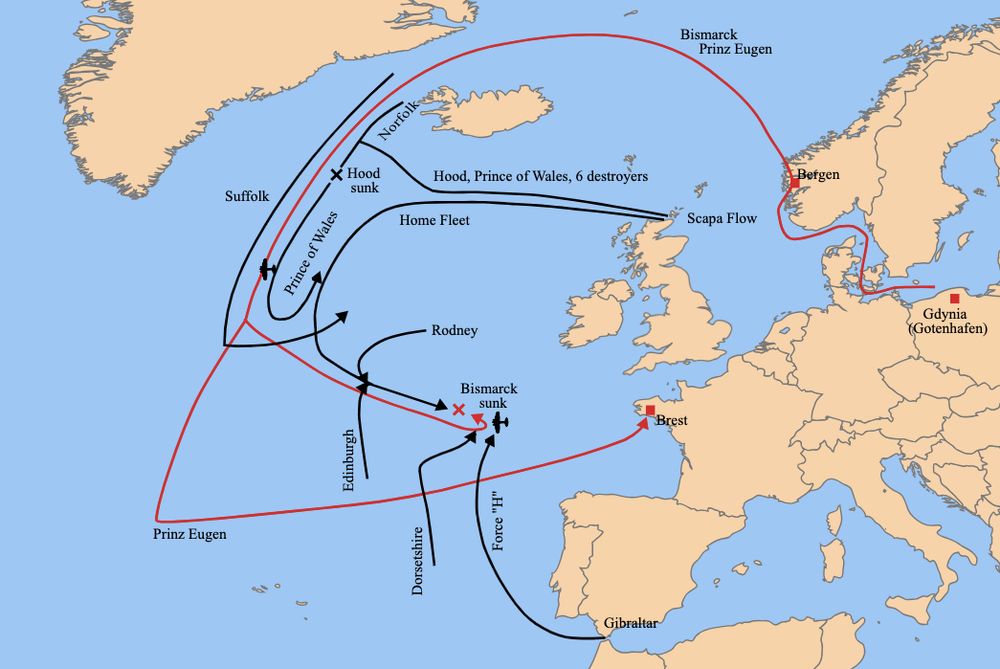
The Hunt for the Bismarck — Naval Pursuit Across the Atlantic
This detailed map traces the dramatic naval engagement that culminated in the sinking of the German battleship Bismarck on May 27, 1941. Rendered in color for clarity, the map captures the vast theater of operations spanning the North Atlantic, British Isles, and western Europe. Red and black lines depict the distinct paths of German and British vessels, respectively. The map begins at Gotenhafen (now Gdynia, Poland), where Bismarck and the heavy cruiser Prinz Eugen departed as part of Operation Rheinübung, a breakout mission into the Atlantic to disrupt Allied shipping. From there, the German warships passed through the Danish Straits near Norway, where they were first spotted by Swedish and British reconnaissance. Arrows trace the encounter in the Denmark Strait, where Bismarck sank HMS Hood, the pride of the Royal Navy, in a catastrophic explosion that killed over 1,400 men. The map continues as Bismarck attempted to flee toward occupied France for repairs in Brest. Her course bends south, but British forces, led by aircraft from HMS Ark Royal, struck a fatal blow—torpedoes disabled her steering near the Bay of Biscay. The convergence of Royal Navy battleships Rodney and King George V, supported by cruisers and destroyers, is clearly plotted. The red “X” marks the site of Bismarck’s final stand and sinking. This map encapsulates the scale, coordination, and urgency of one of the most consequential naval operations of World War II. It also illustrates the importance of intelligence, air reconnaissance, and swift response across vast distances. More than just a tactical victory, the chase for the Bismarck became a symbol of Allied resolve and signaled the strategic importance of controlling Atlantic sea lanes in the fight against Nazi Germany.

Final Confrontation — Warships of the Battle Against the Bismarck
This illustrated comparison of warships involved in the last battle of the Bismarck offers a technical and historical overview of one of World War II’s most dramatic naval confrontations. The image features detailed line drawings of five key vessels: Germany’s Bismarck, and four British warships—King George V, Rodney, Norfolk, and Dorsetshire—that ultimately surrounded and sank her on May 27, 1941. Positioned in descending order of size, the Bismarck stands at the top, showcasing her formidable length, superstructure, and massive artillery. As Nazi Germany’s most powerful battleship, she symbolized a technological leap in naval warfare, equipped with eight 15-inch guns, state-of-the-art armor, and radar systems. Beneath her, the Royal Navy’s King George V class battleship mirrors her firepower and tonnage, armed with ten 14-inch guns and reinforced by strategic modifications after earlier British losses. Next, HMS Rodney, a veteran battleship from World War I, appears with its distinctively low-slung twin turrets, bringing devastating shellfire during the final engagement. The lower two ships, Norfolk and Dorsetshire, are heavy cruisers, smaller in size but vital for tracking and closing in on the Bismarck using their speed and torpedoes. Each ship played a unique role in a naval chess match that stretched across thousands of miles in the Atlantic. Their configurations, weapons placements, and armor schemes visible in this schematic reinforce the broader technological and tactical shifts of naval warfare in the mid-20th century. The inclusion of the title “The Last Battle of the Bismarck” grounds this illustration in its historical context, commemorating a turning point in the war at sea and marking the end of the short but fearsome reign of one of the most feared ships of the era.
On May 27, 1941, British forces sank the German battleship Bismarck in the North Atlantic. The loss of the Nazi warship was a major WWII naval victory and symbolized British resilience in the face of Germany’s maritime threat.
#StayCurious #Skystorians #DiveIntoDiscovery
27.05.2025 17:28 — 👍 5 🔁 2 💬 0 📌 0

Lennon and Ono’s Montreal Bed-In Begins (1969)
This black-and-white image captures the beginning of John Lennon and Yoko Ono’s second “Bed-In for Peace,” launched on May 26, 1969, at the Queen Elizabeth Hotel in Montreal. Sitting upright in a large hotel bed, Lennon and Ono are dressed in white pajamas, surrounded by flowers, a cassette recorder, and an acoustic guitar — the very one later used to record the antiwar anthem “Give Peace a Chance.” Large, hand-drawn signs behind them declare “HAIR PEACE” and “BED PEACE,” intentionally simple messages that would become globally recognized symbols of their protest. The window behind them reveals the Montreal cityscape, a quiet contrast to the political noise they hoped to disrupt. Unlike conventional protests, the Bed-In was meant to be peaceful, absurd, and unignorable — leveraging Lennon’s fame to draw cameras and conversations into a conversation about peace during the Vietnam War era. The media frenzy it sparked brought journalists, activists, and artists into their room across several days, turning a hotel suite into an unexpected epicenter of global activism. Their Montreal Bed-In followed a similar event in Amsterdam earlier that year and was conceived as a response to escalating conflict, not just in Vietnam, but globally. This iconic image freezes a moment when pop culture and pacifism met with intentionality — using celebrity as a megaphone for peace. The recording of “Give Peace a Chance” would follow days later in this very room, with dozens of guests joining the chorus, immortalizing this unconventional protest in both music and memory.

Morning Routine During the Montreal Bed-In (1969)
This black-and-white photograph captures a candid moment from John Lennon and Yoko Ono’s second “Bed-In for Peace,” held in May 1969 in Montreal. The image shows Lennon in a white bathrobe, standing beside Yoko Ono, who is seated cross-legged and barefoot in a chair, also dressed in white. A hotel maid stands at the center, fluffing pillows — a quiet symbol of domestic normalcy in an otherwise radical protest setting. Surrounding them are handmade signs hung on the wall that reinforce the playful yet pointed messaging of the protest: “STAY IN BED,” “GROW YOUR HAIR,” and “SPRING LOVE.” These slogans echoed the couple’s belief in passive resistance and symbolic acts over violence. The Montreal Bed-In, which began on May 26, followed a similar event in Amsterdam and was planned as a weeklong media-engaged protest against war, especially the Vietnam War. Instead of marching, Lennon and Ono invited the world’s press into their hotel room to discuss peace — turning what would otherwise be a private honeymoon into a global statement. This particular scene underscores the surreal blend of the mundane and the revolutionary: the couple framed themselves as ordinary people doing something extraordinary, elevating a daily ritual like staying in bed to an act of philosophical resistance. The presence of the maid also highlights the lived-in, ongoing nature of the protest — this wasn’t a staged photo op but a multi-day event that blurred the line between personal life and public activism. With every moment, including this one, the Bed-In invited onlookers to reconsider how peace could be performed — not with confrontation, but with presence and intentional absurdity.
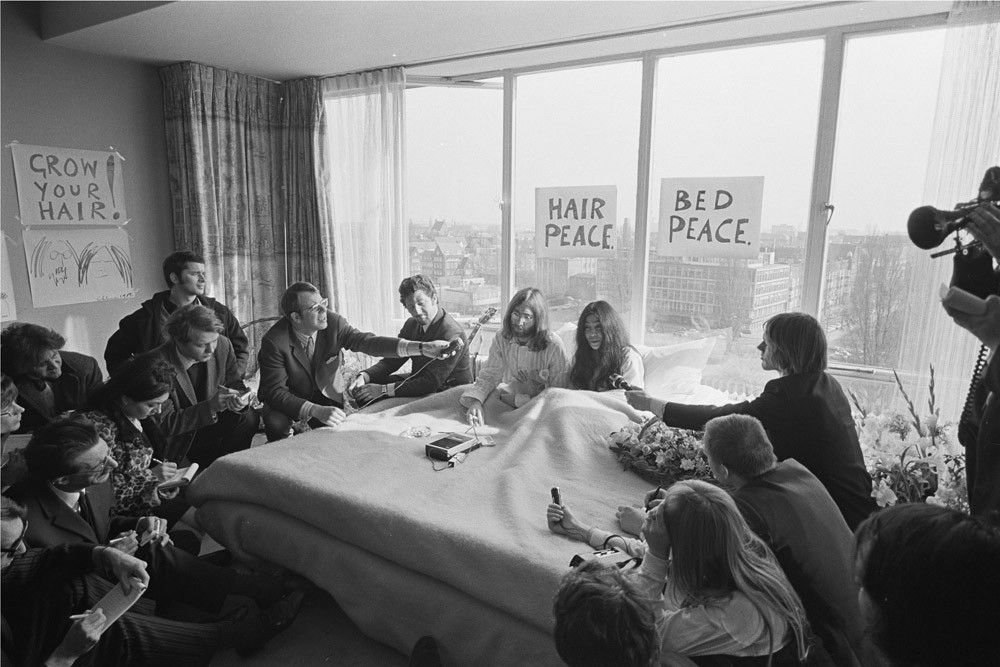
Press Conference in Pajamas – The Montreal Bed-In Begins
This black-and-white photograph captures a media-saturated moment during the opening day of John Lennon and Yoko Ono’s second “Bed-In for Peace,” launched on May 26, 1969, at the Queen Elizabeth Hotel in Montreal. The scene shows the couple seated in bed, smiling and dressed in white pajamas as they face a room packed with journalists, photographers, and documentarians. Around them, reporters sit cross-legged on the floor and lean forward eagerly with pens and notepads, microphones, and recording equipment, capturing every word and gesture. Behind the bed, large hand-lettered signs taped to the window panes declare their now-iconic slogans: “HAIR PEACE” and “BED PEACE.” The slogans were meant to subvert the expected modes of protest and instead present pacifism as both intimate and globally broadcastable. By inviting the media into their bedroom, Lennon and Ono inverted the private/public divide, turning the hotel suite into both a sanctuary and a stage. The Montreal Bed-In was not a spontaneous act but a carefully orchestrated performance of nonviolent activism, timed to attract maximum press coverage. It took place shortly after their wedding and was inspired by Gandhi’s methods of peaceful resistance. Unlike traditional protests marked by confrontation or marching, the Bed-In used the media spectacle — a tool Lennon and Ono understood deeply — to shift conversations toward peace and demilitarization. During this week-long event, the couple gave interviews to outlets around the world and ultimately recorded the anthem “Give Peace a Chance.” This photograph captures the very spirit of their protest: sincere idealism blended with theatrical showmanship, challenging viewers to rethink how peace could be enacted not just in the streets, but in the everyday act of being.

A Song for Peace – “Give Peace a Chance” is Born
This evocative black-and-white image captures the creative and cultural climax of John Lennon and Yoko Ono’s second “Bed-In for Peace,” which began on May 26, 1969, in Montreal. The photograph shows the couple sitting upright in bed surrounded by microphones, audio cables, and musical instruments as they record the now-iconic antiwar anthem “Give Peace a Chance.” Lennon, with his signature long hair and round glasses, strums an acoustic guitar, while Yoko Ono sits beside him in serene stillness, symbolizing both partnership and protest. Around them, a small group of musicians, sound engineers, and journalists crowd into the modest hotel room, which has been transformed into an unlikely recording studio. Signs above their heads read “HAIR PEACE” and “PEACE,” echoing the couple’s core message and acting as backdrops to one of the most memorable acts of musical activism of the 20th century. The atmosphere in the room blends intimacy with urgency, making the recording session feel like both a jam session and a political demonstration. This image immortalizes the moment when the ideals of the 1960s counterculture—peace, resistance, and global unity—were distilled into a single phrase repeated in chorus. The song, improvised and recorded with minimal equipment, became the rallying cry of antiwar protests around the world, used in demonstrations from the Vietnam War era to more recent movements. It marked the moment when pop culture and political dissent fused through performance art, creating an enduring global symbol of peaceful resistance. More than a publicity stunt, the Bed-In became a platform where celebrity, creativity, and conviction converged to challenge violence with music, humor, and radical vulnerability. In this image, we witness the transformation of a bedroom into a battlefield of ideas—one fought not with weapons, but with chords and convictions.
On May 26, 1969, John Lennon and Yoko Ono began their second “Bed-In for Peace” in Montreal. The nonviolent protest drew global media attention and produced “Give Peace a Chance,” an anthem of antiwar movements around the world.
#StayCurious #Skystorians #DiveIntoDiscovery
26.05.2025 20:05 — 👍 13 🔁 2 💬 0 📌 0
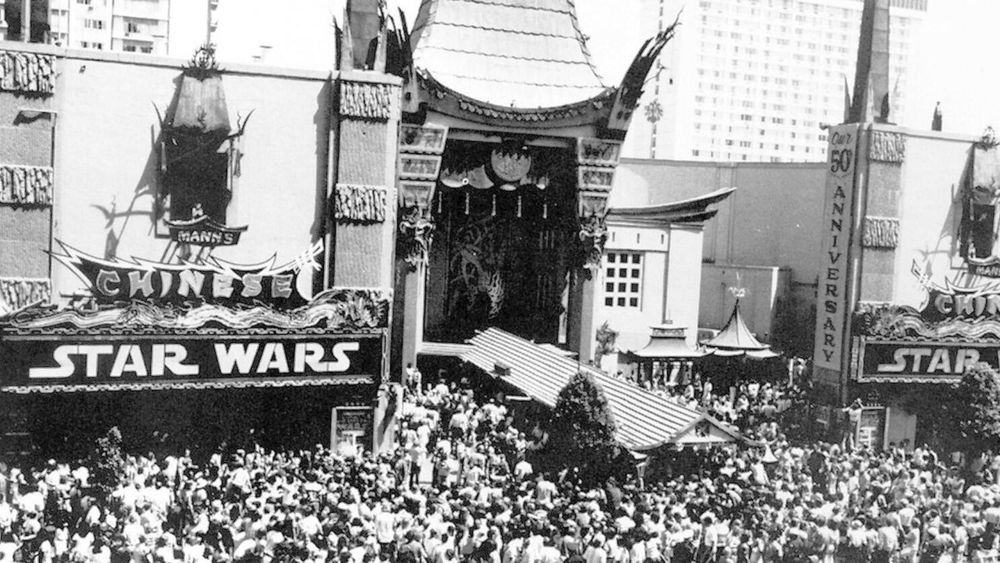
The Birth of a Blockbuster – Star Wars Premieres at Mann’s Chinese Theatre, 1977
This iconic black-and-white photograph captures the explosive premiere of Star Wars on May 25, 1977, outside Mann’s Chinese Theatre in Hollywood, California. The building’s distinct East Asian architectural style forms a dramatic backdrop, with its ornate rooflines and pagoda-style details, providing a fittingly theatrical setting for a moment that would redefine the moviegoing experience forever. Beneath the towering marquee boldly emblazoned with “STAR WARS,” an enormous crowd stretches across the sidewalk and beyond, emphasizing the instant magnetism of the film. At the time, Star Wars had only opened in 32 theaters across the United States, but word-of-mouth, combined with unprecedented enthusiasm, sparked long lines and sold-out shows within hours. What’s seen here is not just a queue—it is a cultural ignition point. The crowd represents a cross-section of curious sci-fi fans, movie lovers, and pop culture enthusiasts, many of whom had no idea they were witnessing the dawn of a cinematic revolution. George Lucas’s vision had blended mythological themes, space opera grandeur, and pioneering visual effects into a genre-defining masterpiece. The audience outside Mann’s Chinese Theatre wasn’t merely waiting to see a movie—they were stepping into a mythos that would soon expand into a galaxy-spanning franchise, inspire generations of creators, and shift the Hollywood model toward blockbuster filmmaking. The photo freezes a transformative day, where cinema history and global pop culture converged under a single marquee.

The Visual Mythos Begins – Original 1977 Star Wars Poster
This vibrant theatrical poster, released in 1977, introduced audiences to Star Wars (later retitled Episode IV: A New Hope), capturing the essence of George Lucas’s ambitious space epic through bold, dynamic artwork. Dominating the center, a young Luke Skywalker raises a glowing lightsaber overhead, evoking classical heroic poses reminiscent of mythological figures. Beside him stands Princess Leia, blaster in hand, evoking both strength and mystery. Behind them looms the ominous visage of Darth Vader, whose presence foreshadowed the saga’s central conflict between light and darkness. The background is filled with X-wing and TIE fighters clashing across a starry battlefield, symbolizing the larger galactic war at play. The menacing silhouette of the Death Star hovers above—a visual shorthand for looming imperial power. Also depicted are key characters such as the wise Obi-Wan Kenobi, the cold and calculating Grand Moff Tarkin, and the beloved droids R2-D2 and C-3PO. Chewbacca and Han Solo are poised for action, underscoring the ensemble nature of the rebellion. This poster not only introduced these characters but also conveyed a sense of scale, urgency, and magic. The hand-painted style lent it a timeless, fantasy-novel aura that set it apart from other science fiction fare of the era. Below the art, the credits highlight George Lucas as writer and director, John Williams as composer, and the cast that would soon become household names. The poster encapsulated the unique blend of myth, science fiction, and adventure that would come to define Star Wars, igniting the imaginations of millions and launching one of the most influential franchises in cinematic history.
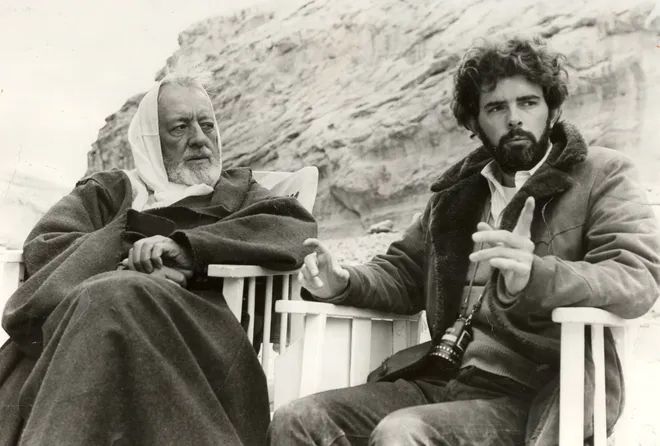
Vision and Legacy – George Lucas Directs Alec Guinness on the Set of Star Wars
This behind-the-scenes black-and-white photograph captures a pivotal moment in cinematic history: George Lucas directing the esteemed Alec Guinness during the filming of Star Wars (1977), later known as Episode IV: A New Hope. Seated outdoors amid the rocky terrain of Tunisia—doubling for the desert planet Tatooine—the image radiates a quiet intensity and mutual respect. Lucas, young and bearded with a camera slung around his neck, gestures with intent as he discusses a scene, his hands illustrating a point with precision. His puffy jacket and thoughtful expression reflect the pressures of shaping a bold vision with limited resources and massive ambition. Opposite him, Guinness—already a legendary British actor known for roles in The Bridge on the River Kwai and Lawrence of Arabia—sits in Obi-Wan Kenobi’s Jedi robes, hood up against the wind, listening with focus. Guinness’s participation lent gravitas to the film and anchored its spiritual dimension. His portrayal of Kenobi would become iconic, despite his initial skepticism about the film’s script and science fiction premise. This image encapsulates the unlikely fusion of classical acting tradition and daring new storytelling that Star Wars achieved. It also highlights Lucas’s role not just as a world-builder, but as a careful director balancing legacy talent with a young, unknown cast. This collaboration bridged generations and genres, blending mythic narrative with futuristic setting. The stark desert backdrop and contemplative mood of the shot foreshadow the quiet wisdom and epic conflict embedded in the galaxy-spanning saga that would follow, changing cinema forever.
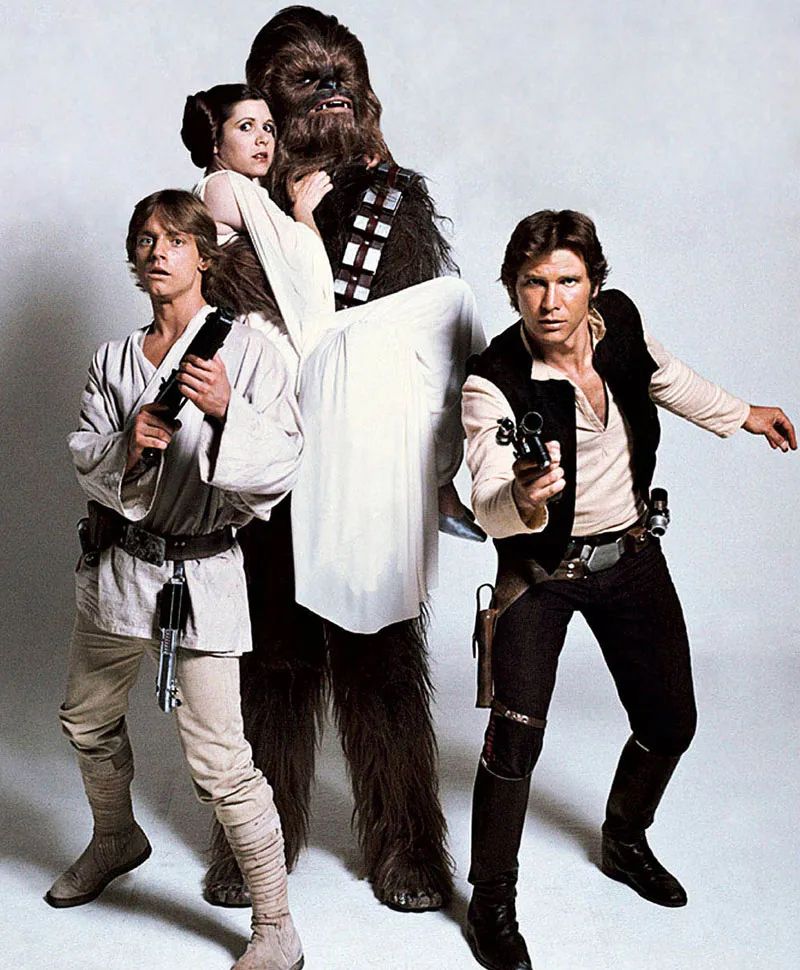
A Galactic Ensemble – The Iconic Cast of Star Wars (1977)
This promotional image showcases the principal heroes of Star Wars (1977), posed in character for a timeless ensemble portrait that would define the saga for generations. From left to right, Luke Skywalker (Mark Hamill), Princess Leia Organa (Carrie Fisher), Chewbacca (Peter Mayhew), and Han Solo (Harrison Ford) stand together in full costume, striking dynamic poses that capture the spirit and essence of the film’s mythic adventure. Hamill’s Luke stands at the ready with his blaster, symbolizing the reluctant farm boy turned Jedi-in-training. Fisher’s Leia, cradled in Chewbacca’s arm and wielding her own blaster, blends royal elegance with revolutionary defiance, embodying the feminist strength that set her apart from earlier Hollywood damsels. Chewbacca towers above the group in his full Wookiee costume—made of yak hair and mohair—exuding loyalty and power as Han Solo’s fiercely protective co-pilot. Ford’s Han stands confidently, blaster drawn, channeling the roguish charm and cynical bravado that made his smuggler-turned-hero one of cinema’s most beloved antiheroes.
Photographed against a clean studio backdrop, the image highlights each character’s design: Luke’s simple Tatooine tunic and boots, Leia’s flowing white gown with a retro-futuristic flair, Han’s vest and holster, and Chewbacca’s bandolier—each a deliberate fusion of science fiction and fantasy aesthetics. The actors’ expressions—some wary, some bold—mirror their characters’ roles in the galactic rebellion. This image was central to Star Wars marketing efforts, often reproduced in merchandise and posters. More than just a cast photo, it became an emblem of cinematic adventure, introducing a universe of archetypes reimagined through George Lucas’s futuristic mythos. It remains one of the most enduring images of 20th-century popular culture.
On May 25, 1977, Star Wars premiered in theaters, sparking a cultural phenomenon. Blending mythology, science fiction, and groundbreaking special effects, it redefined blockbuster cinema and reshaped global pop culture for generations.
#StayCurious #Skystorians #DiveIntoDiscovery
25.05.2025 20:12 — 👍 20 🔁 6 💬 3 📌 1
Thanks for calling this out! We try our best to fit the real in there since these posts can only be so long. 🙂
25.05.2025 20:03 — 👍 1 🔁 0 💬 0 📌 0
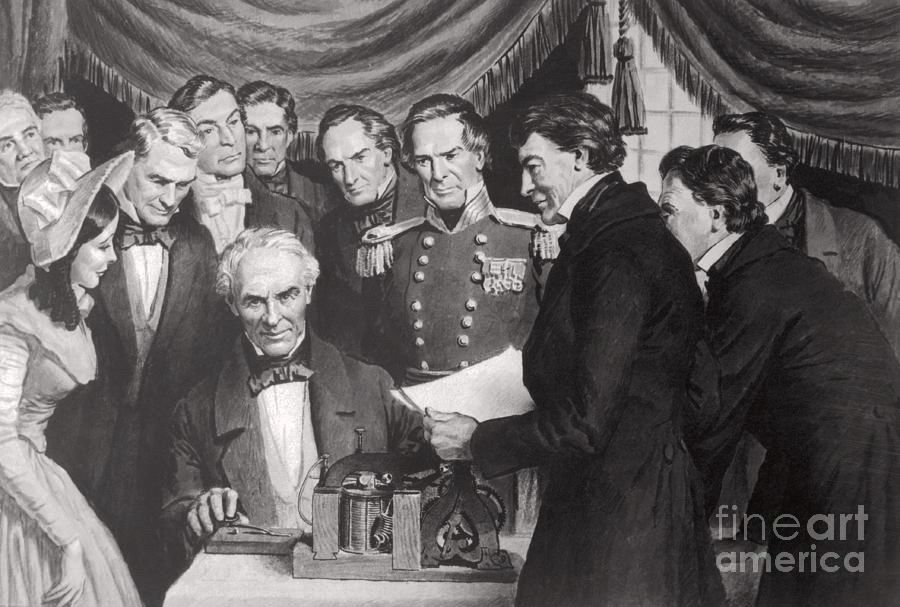
Samuel Morse Sends the First Telegraph Message, 1844
This historical image captures the seminal moment on May 24, 1844, when Samuel F. B. Morse transmitted the world’s first long-distance telegraph message from the U.S. Capitol in Washington, D.C., to Baltimore, Maryland. Seated at the device, Morse is surrounded by a group of dignitaries, military officers, and curious onlookers, all witnessing the birth of a new era in global communication. The mood is one of solemn awe and intellectual curiosity. The message he sent—“What hath God wrought?”—was selected from the Bible (Numbers 23:23) and carried deep spiritual and philosophical meaning, signifying both marvel and humility at the scale of human innovation. This transmission marked a defining moment in the development of information technology, reducing the time needed to send messages over long distances from days or weeks to mere minutes. It paved the way for the modern age of instant communication, from telephones to the internet. The image, though artistic and likely based on contemporary accounts, encapsulates the revolutionary potential recognized by those present at the demonstration. The fine detail in the attire and expressions of the attendees emphasizes the era’s blend of scientific advancement and Victorian decorum. Samuel Morse, once a painter, transitioned into inventing after personal tragedy and went on to co-develop Morse code with Alfred Vail, whose contributions are often overlooked in favor of Morse’s public recognition. This moment did not simply launch a new device—it redefined the relationship between time, distance, and human connection on a global scale. The telegraph line used in this demonstration was strung alongside the B&O Railroad, symbolizing the intersection of two transformative 19th-century infrastructures: the railway and the telegraph network.

The Original Telegraph Device Used by Samuel Morse
This image showcases the original electromagnetic telegraph instrument developed by Samuel Morse and Alfred Vail, the very device used on May 24, 1844, to send the first long-distance message from Washington, D.C., to Baltimore. The design is remarkably compact yet ingenious, consisting of a red-painted electromagnet coil, wooden base, iron armature, and a mechanical gear-driven paper tape system that recorded the dots and dashes of Morse code. The simplicity of its components belies its revolutionary impact on communication and technology. Before this invention, the fastest way to transmit messages over long distances was by horse or ship, which often took days or weeks. The electromagnetic telegraph compressed space and time, enabling the near-instantaneous transfer of information across continents. The device in the image represents not just a tool but the physical beginning of the information age. Its construction reflects early 19th-century American engineering, resourceful and minimalist in form, yet profoundly effective. The telegraph’s mechanism converted electrical impulses into physical markings on a continuous paper strip—code that could be decoded by trained operators. This ability to digitize language into a sequence of short and long electrical signals laid the foundation for all subsequent forms of digital communication. Morse and Vail’s telegraph revolutionized journalism, finance, and military coordination, enabling messages to traverse borders and oceans faster than ever imagined. Its success led to the rapid spread of telegraph lines across the United States and Europe, forming the first global communications network by the late 19th century. This specific device is not only a marvel of innovation but a cultural artifact—testament to the moment when human voices first began to travel via electricity, signaling a new epoch in how societies share knowledge, coordinate actions, and record history.
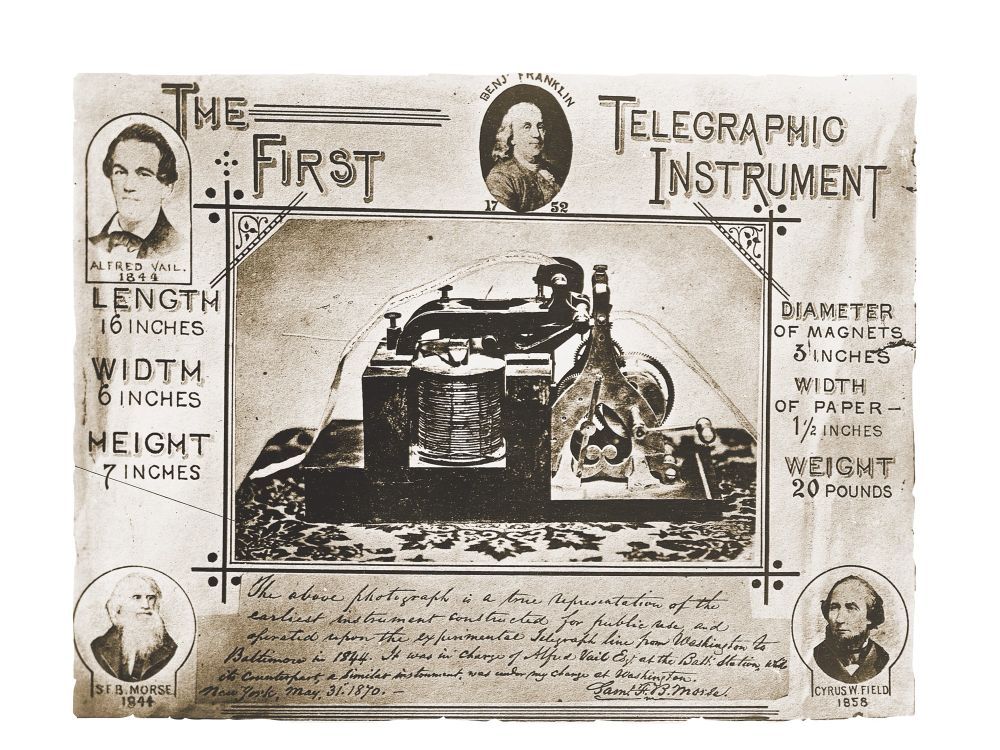
The First Telegraphic Instrument: Historical Poster & Specifications
This archival image features a poster highlighting the first telegraphic instrument used in the 1844 transmission by Samuel Morse. The central focus is a photograph of the original device—an electromagnetic telegraph machine—flanked by ornate text and illustrations that document its specifications and historic importance. The design captures not only the technical details but also the celebratory tone surrounding one of the 19th century’s greatest technological breakthroughs. The poster lists dimensions (16 inches long, 6 inches wide, 7 inches high), weight (20 pounds), and core components including the 3.5-inch diameter magnets and 1.5-inch wide paper used to record Morse code. Portraits of key figures such as Samuel Morse, Alfred Vail (his collaborator), and Cyrus W. Field (a telegraph pioneer who later championed the transatlantic cable) frame the composition. Notably, Benjamin Franklin is included, symbolically linking the telegraph to the broader lineage of American scientific achievement. Beneath the photo, an inscription recounts that this machine transmitted the first official telegraph message from Washington, D.C. to Baltimore on May 24, 1844, a feat accomplished by Morse from the Capitol and received at a Baltimore train station. This message, quoted from the Book of Numbers, underscored the spiritual and cultural weight of the moment, reflecting a sense of awe at mankind’s new ability to command the invisible force of electricity for communication. The telegraph became the backbone of the 19th-century information revolution, laying the groundwork for rapid-fire journalism, global diplomacy, and modern data networks. This poster, beyond its function as a technical snapshot, serves as both homage and artifact—a stylized record of how a simple code of dots and dashes transformed global interaction, compressed time and distance, and redefined the pace at which the world lived and connected

Historic Marker: The First Telegram Sent by Samuel Morse
This image displays a historical roadside marker commemorating one of the most pivotal moments in communication history: the transmission of the first telegram by Samuel F. B. Morse on May 24, 1844. The plaque, issued by the Maryland Historical Trust and the Maryland State Highway Administration, is situated along the route used by the B&O Railroad—the same path along which Morse’s telegraph wires were laid between Washington, D.C., and Baltimore. The marker reads: “The First Telegram ‘What Hath God Wrought’ was sent from the Capitol in Washington to Baltimore May 24, 1844 over wires laid along the right of way of the B&O Railroad adjacent to this highway. The telegraph was invented by Samuel F. B. Morse (1791–1872).” This succinct dedication encapsulates a moment when the world changed forever. With a simple biblical phrase transmitted through electrical pulses, Morse inaugurated a new era in which information could travel faster than any human or horse, bypassing the limitations of geography. This advancement laid the foundation for the global communication networks that define the modern world. Before the telegraph, communication over long distances was dependent on physical transport, but Morse’s system of electromagnetically-controlled signals allowed for near-instantaneous message delivery—a breakthrough that influenced everything from journalism and commerce to diplomacy and warfare. The selection of the phrase “What hath God wrought?” (Numbers 23:23) added a solemn and reverent tone to the technological leap, suggesting a spiritual awe at the human ability to harness nature’s invisible forces. This historical marker not only preserves the memory of Morse’s innovation but also stands as a testament to the interplay of faith, technology, and infrastructure in the shaping of modern civilization.
On May 24, 1844, Samuel Morse sent the first telegraph message from Washington, D.C., to Baltimore. His words, “What hath God wrought?” launched a communications revolution, shrinking distances and transforming how information moved across continents.
#StayCurious #Skystorians #DiveIntoDiscovery
24.05.2025 17:58 — 👍 28 🔁 7 💬 3 📌 4
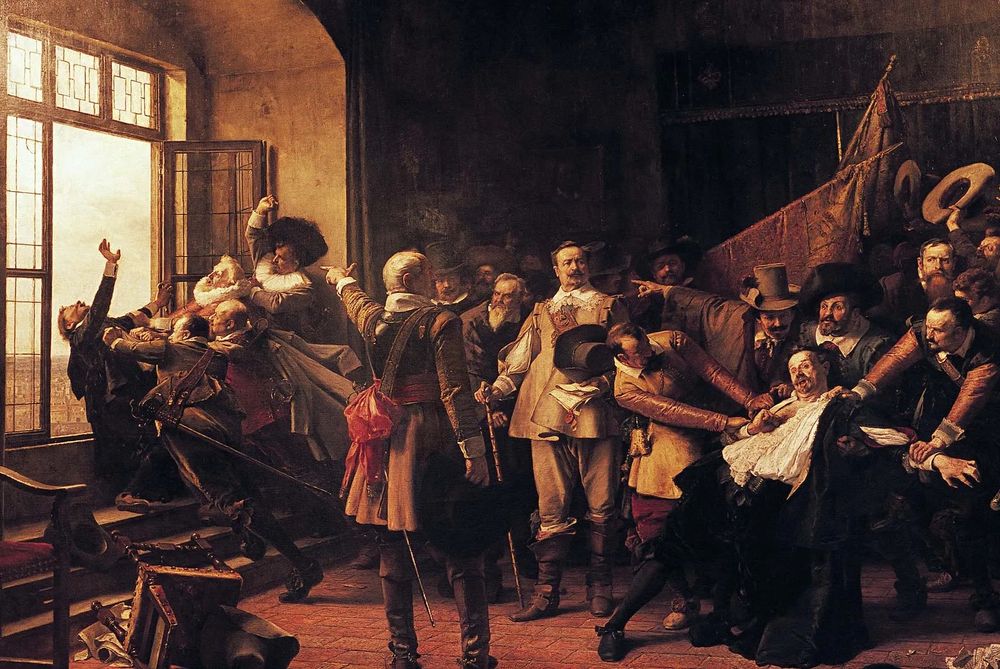
The Second Defenestration of Prague – A Spark That Lit a Continent
This dramatic historical painting captures the pivotal moment of the Second Defenestration of Prague, which occurred on May 23, 1618. The scene shows a chaotic interior chamber in Prague Castle where Protestant Bohemian nobles, enraged by perceived Catholic overreach and violations of religious liberties, confront imperial officials representing Ferdinand II of Habsburg. In a moment charged with fury and defiance, the nobles physically seize the Catholic envoys—most notably Jaroslav Bořita of Martinice and William Slavata of Chlum—and hurl them from a high window of the Bohemian Chancellery. Their descent from this window, seen to the left of the image, was over 20 meters, yet miraculously, the envoys survived, landing in a manure heap or ditch. The act, steeped in both symbolism and violence, sent shockwaves across Europe. What might seem today like political theater was, in fact, the fuse for one of the most devastating conflicts in European history—the Thirty Years’ War. The painting is rich in historical and artistic detail: furrowed brows and extended arms show a range of expressions from determination to shock; the contrast between light flooding through the open window and the shadowy crowd within emphasizes the impending descent into chaos. The defenestration became a defining moment in the struggle between Protestant and Catholic factions, exacerbating existing tensions in the Holy Roman Empire. Ultimately, the war that followed would claim millions of lives, redraw borders, and shift the European balance of power for generations. This image, though a recreation, remains one of the most enduring visual testaments to the explosive power of religious and political conflict in early modern Europe.
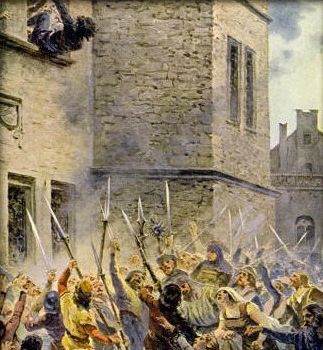
A People’s Fury – The Prague Mob Reacts to the Defenestration
This vivid illustration captures the immediate aftermath of the Second Defenestration of Prague on May 23, 1618, from the street-level perspective of commoners witnessing a seismic political event. The image shows one of the Catholic officials, moments after being thrown from a castle window by Protestant nobles, descending toward a frenzied crowd. The stone façade of the Bohemian Chancellery towers in the background, while swords and spears thrust skyward from the dense assembly of angry citizens below. The mob—composed of peasants, burghers, and soldiers—is depicted in various states of uproar: some scream in protest, others reach upward, and a few appear to brace to catch or strike the falling figure. Their expressions and movements reveal a collective sense of outrage, fear, and empowerment. This moment captures more than a singular act of violence—it reflects the broader mood of Bohemia at the dawn of the Thirty Years’ War. Tensions over religious rights, imperial authority, and Protestant liberties had long simmered. The defenestration crystallized those frustrations into open rebellion. What followed was no mere protest—it was a nationwide revolt that drew in foreign powers and evolved into a continent-wide war. Though the men thrown from the window survived, this act symbolized the rejection of Habsburg dominance and the beginning of a multi-decade conflict that would devastate Europe. The image also underscores the role of ordinary people in shaping historic turning points. Their presence in this scene reminds viewers that history is not only made in palaces or parliaments but also on the streets—where citizens’ reactions can magnify an isolated act into a global crisis. The rough stone, sharpened blades, and collective motion of the crowd give the moment urgency, grounding it in the volatile political and religious upheaval of the early 17th century.
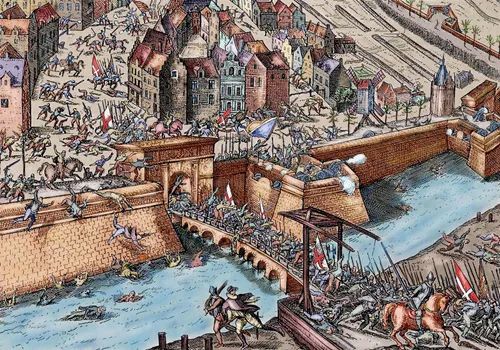
Chaos at the Bridge – Prague Uprising Escalates into Open War
This engraving offers a bird’s-eye view of a violent clash on a stone bridge during the early stages of the Bohemian Revolt following the Second Defenestration of Prague on May 23, 1618. Soldiers, civilians, and cavalry are seen in a chaotic mêlée that has spilled across the bridge and into the adjacent cityscape. The detailed architecture of Renaissance-era Prague surrounds the scene, giving context to the civil unrest that erupted in the wake of religious and political strife. Flags bearing various heraldic emblems flutter over the chaos, suggesting the involvement of competing regional factions. Men in colorful 17th-century uniforms fire muskets and wield swords while others fall into the river or are trampled underfoot. The tightly packed crowd illustrates the scale of the conflict, conveying the moment the Bohemian revolt transitioned from palace intrigue to urban warfare. The bridge, an important passage into the city’s heart, symbolizes the contested control of Prague between imperial Catholic forces and Protestant rebels. This eruption of violence, sparked by the defenestration of two imperial envoys by Protestant nobles, rapidly escalated into the Thirty Years’ War—a pan-European conflict that engulfed the Holy Roman Empire and drew in major powers like Spain, France, Sweden, and the Ottoman Empire. The image underscores the fragility of civil order and the speed with which political symbolism (throwing envoys from a window) can spiral into full-blown war. It also reflects the deeply entangled nature of religious tension and regional autonomy that defined early modern Central Europe. The river, rendered in stark contrast to the violence, appears as a silent witness to the bloodshed—its currents carrying not only bodies but the weight of a continent’s disintegration into religious conflict. The image vividly narrates the grim opening chapter of a war that would claim over eight million lives.
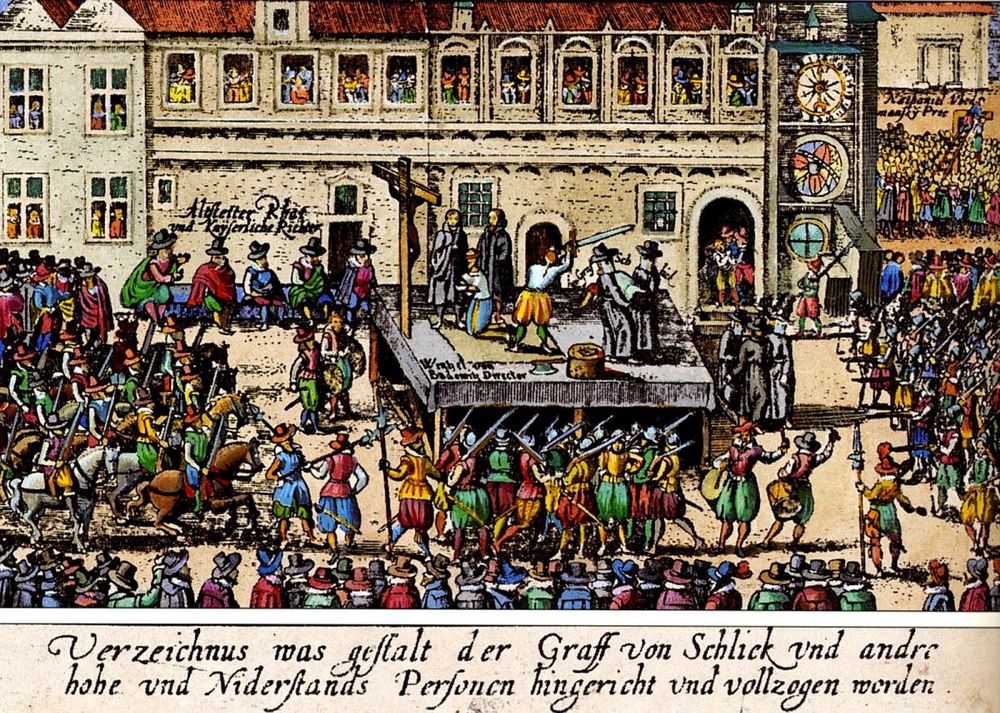
Executions in the Old Town Square – Retribution for the Revolt
This engraving captures the grim aftermath of the Second Defenestration of Prague and the failed Bohemian Revolt, depicting the public execution of Protestant leaders on June 21, 1621, in Prague’s Old Town Square. Central to the image is a raised wooden scaffold where multiple nobles and Protestant figures are beheaded by swordsmen under the watchful eyes of Habsburg authorities. The executioner is mid-swing, sword raised, as a kneeling victim prepares for the fatal blow. The crowd surrounding the platform is a dense mass of soldiers, nobles, townspeople, and clergy—some spectating from balconies, others gathering in the square below. The variety of figures and their vivid attire, from the feathered hats and doublets of nobles to the bright uniforms of soldiers, signal the event’s theatrical and symbolic nature: not just a punishment, but a message of imperial dominance
Inscriptions below the image identify those being executed, including Count von Schlick and other Bohemian lords who had supported the rebellion. At the edges of the scene, Catholic symbols and heraldry emphasize the restoration of Habsburg rule and the suppression of Protestant dissent. The ornate Renaissance buildings and clock tower anchoring the background place the event squarely in Prague’s urban heart—highlighting how the revolt, which began with nobles hurling Catholic officials from a castle window, would end not with negotiations, but executions. These deaths marked a turning point in the Thirty Years’ War, signaling the Habsburgs’ intent to crush religious plurality and enforce Catholic re-Catholicization. The square, once a civic space for markets and celebration, is transformed into a stage of terror and retribution
This is not merely historical record—it is propaganda, memorial, and warning. It immortalizes the price of rebellion and the legacy of the Defenestration: the religious and political reshaping of Central Europe
On May 23, 1618, the Second Defenestration of Prague triggered the Thirty Years’ War. Protestant nobles threw Catholic envoys out a castle window, igniting one of Europe’s deadliest conflicts and reshaping its religious and political landscape.
#StayCurious #Skystorians #DiveIntoDiscovery
24.05.2025 01:52 — 👍 27 🔁 4 💬 0 📌 0

The End of the Eyjafjallajökull Eruption – A Global Disruption from a Remote Volcano
This striking image captures the immense ash plume from Iceland’s Eyjafjallajökull volcano during its 2010 eruption, a natural event that stunned the modern world by halting air travel across Europe. Taken at the height of the eruption, the photograph shows dense, towering clouds of volcanic ash and gas forcefully rising from the volcano’s crater, darkening the sky and demonstrating the raw, unpredictable power of geological forces. Located beneath a glacier, Eyjafjallajökull’s eruption began in April 2010 and lasted until May 22, officially ending after 39 days of activity. Its combination of heat and ice created explosive interactions, releasing massive ash clouds that reached altitudes of over 9 kilometers. The ash, composed of fine particles of rock and glass, spread rapidly across Europe’s airspace, grounding over 100,000 flights and affecting more than 10 million travelers. The eruption underscored the vulnerability of global infrastructure to localized natural events and prompted widespread reevaluation of aviation protocols related to volcanic activity. Eyjafjallajökull also drew attention to Iceland’s geological uniqueness, situated on both the Mid-Atlantic Ridge and a volcanic hotspot, making it one of the most volcanically active regions on Earth. This image, with its haunting beauty, symbolizes not just destruction but also the interconnectedness of natural forces and human systems. It serves as a vivid reminder that even in a world of satellites and global connectivity, nature retains the capacity to paralyze entire continents from afar.
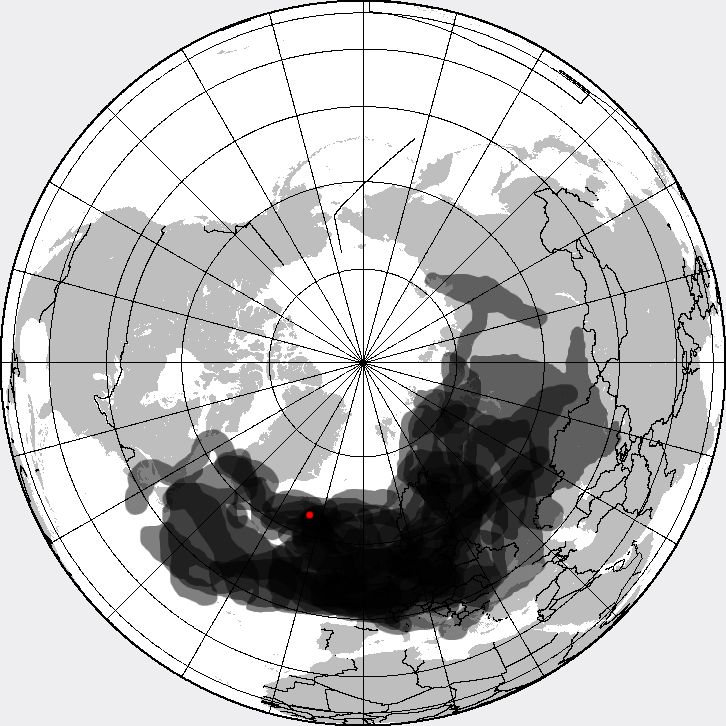
Ash Cloud Trajectory from Eyjafjallajökull – A Volcanic Impact Beyond Borders
This scientific map visualizes the far-reaching extent of the ash cloud produced by Iceland’s Eyjafjallajökull eruption in 2010. Marked by concentric gradients of black and gray, it shows the dispersion of volcanic ash from the eruption site (highlighted in red) across the Northern Hemisphere. The darkest areas indicate the densest concentrations of ash, stretching from Iceland across the North Atlantic and into continental Europe, affecting countries including the United Kingdom, France, Germany, and beyond. What makes this event historically significant is how a single eruption in a relatively remote part of the world disrupted global travel, exposed the fragility of modern logistics, and forced a reevaluation of emergency preparedness for natural disasters. The European airspace saw an unprecedented five-day shutdown, with over 100,000 flights canceled and air freight systems thrown into chaos. The financial cost was estimated at $1.7 billion, and the disruption affected everything from tourism to pharmaceuticals. This visualization illustrates the invisible yet powerful spread of volcanic ash in the upper atmosphere and highlights how quickly localized geological activity can ripple across continents. It underscores the importance of real-time meteorological tracking and international collaboration between aviation authorities, volcanologists, and emergency planners. As a cartographic record, this image serves not only as scientific data but as a testament to the globalized world’s delicate balance with nature’s forces. The Eyjafjallajökull eruption became a defining example of how even the skies can be brought to a standstill by forces deep within the Earth.
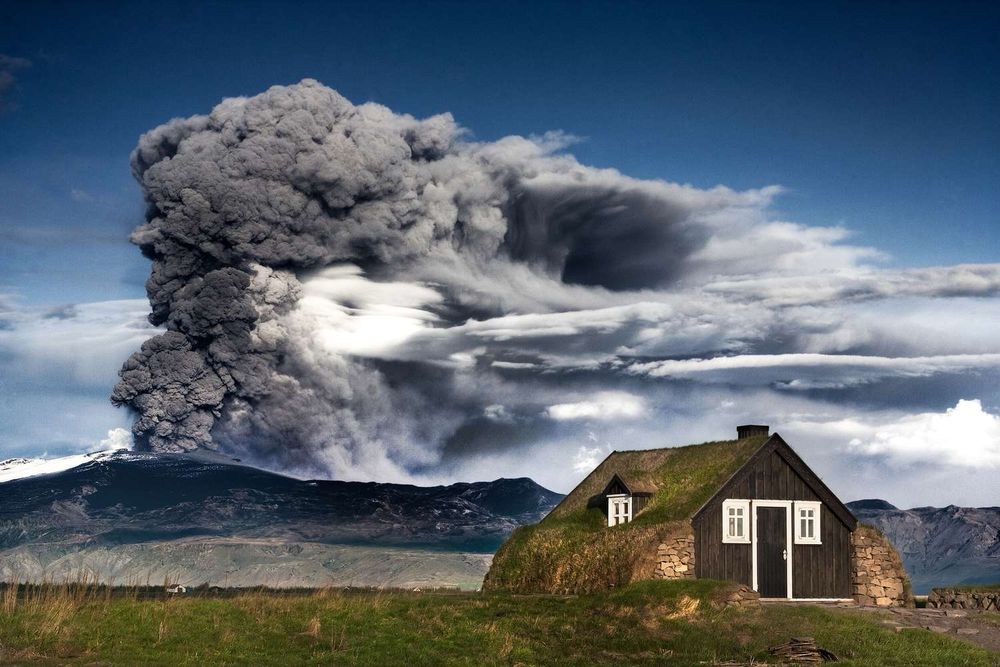
Eyjafjallajökull’s Ash Tower Looms Over Rural Iceland – Nature’s Spectacle Meets Daily Life
This striking image captures a towering ash plume erupting from Iceland’s Eyjafjallajökull volcano during its 2010 eruption, seen from a tranquil rural farmstead in the Icelandic countryside. The contrast between the serene, turf-roofed black wooden cottage in the foreground and the billowing, mushrooming cloud of ash and volcanic gases in the background creates a surreal visual dichotomy between human habitation and the raw power of nature. The Eyjafjallajökull eruption lasted 39 days, beginning in April and officially ending on May 22, 2010. During that time, it spewed an estimated 250 million cubic meters of volcanic material into the atmosphere. The massive ash cloud, lofted high into the jet stream, grounded much of Europe’s air traffic for nearly a week and impacted more than 10 million travelers, highlighting how profoundly natural events can disrupt global infrastructure. Yet for many Icelanders living near the eruption, life carried on under the ever-present shadow of volcanic ash. Iceland’s history is intimately tied to its geological volatility, and this photo captures that enduring coexistence. The turf-roofed house reflects centuries-old Icelandic architectural traditions that prioritized insulation and harmony with the land, making it both a symbol of cultural resilience and sustainable living. As Eyjafjallajökull sent dark clouds into the stratosphere, disrupting economies and headlines worldwide, the people living nearby continued their routines, adapting once again to the island’s fiery temperament. This image serves as a powerful reminder of humanity’s small yet enduring presence in the face of Earth’s elemental forces.
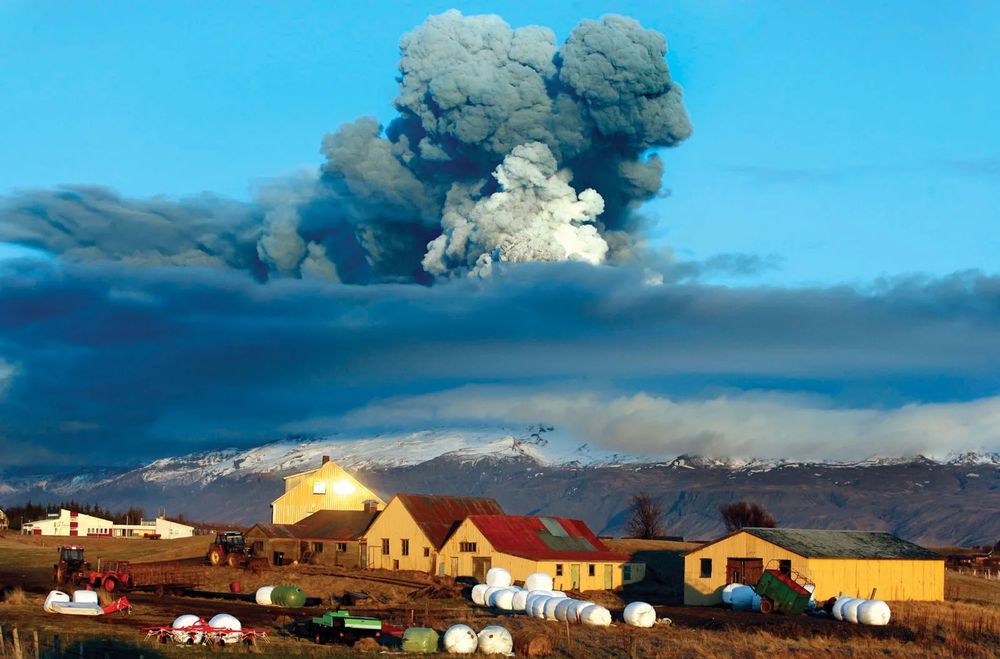
Eyjafjallajökull Ash Cloud Over Icelandic Farmland – A Modern Disruption Rooted in Ancient Power
This image captures the distant ash plume of the Eyjafjallajökull volcano rising ominously above a pastoral Icelandic farm on a crisp, clear day. Taken during the 2010 eruption that began in April and officially ceased on May 22, the photo shows an expansive volcanic cloud contrasting dramatically with the quaint, scattered yellow and red-roofed buildings in the foreground. Wrapped in early morning light, the farm structures and snow-dusted mountains provide a peaceful yet surreal setting for one of the 21st century’s most disruptive natural events. The eruption not only released massive quantities of ash and volcanic gas into the upper atmosphere, but also paralyzed much of Europe’s air travel. Over 100,000 flights were canceled in the span of a week, marking the largest air traffic shutdown since World War II. The photo’s visual balance between human development and natural upheaval encapsulates the geographic and cultural realities of living in Iceland, where volcanism is not just a geological phenomenon, but a formative element of national identity. The vibrant cloud formations in the sky—including darker ash and lighter water vapor—illustrate how quickly conditions can shift, affecting agriculture, health, and communication systems. The eruption’s impact rippled beyond Iceland, prompting discussions on aviation safety, volcanic forecasting, and the fragile interdependence of global networks. This photograph is not just a snapshot of natural drama—it is a lens into the vulnerability of modern systems when confronted with Earth’s untamed forces, and a tribute to the resilience of Icelandic communities long accustomed to coexisting with fire and ice.
On May 22, 2010, Iceland’s Eyjafjallajökull volcano officially ceased erupting after 39 days. Its ash cloud had paralyzed European air traffic, impacting millions and revealing the global fragility of transportation networks to natural events.
#StayCurious #Skystorians #DiveIntoDiscovery
22.05.2025 20:40 — 👍 11 🔁 2 💬 0 📌 1
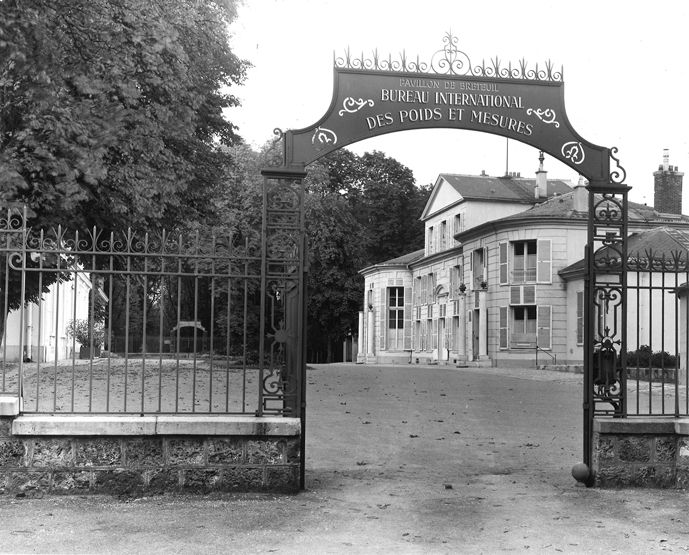
Founding Site of Global Measurement – The Bureau International des Poids et Mesures
This black-and-white image captures the historic entrance of the Bureau International des Poids et Mesures (BIPM) in Sèvres, France, framed by a wrought-iron gate with ornate scrollwork and the institution’s name prominently displayed in French: “Pavillon de Breteuil – Bureau International des Poids et Mesures.” The building seen through the archway is the Pavillon de Breteuil, an 18th-century structure repurposed to house one of the most consequential scientific organizations in modern history. This site became the global headquarters for metrology after the signing of the Metre Convention on May 20, 1875, an international treaty that established a universal framework for standardizing measurements across nations. The agreement initially included 17 countries—now expanded to nearly 60—and formed the foundation of the metric system’s worldwide adoption.
The BIPM was tasked with maintaining prototype standards, including the international prototype of the metre and the kilogram. These physical standards were stored under strict environmental conditions within the building depicted, symbolizing the global commitment to scientific accuracy and consistency. Over time, these prototypes evolved into more precise definitions based on physical constants, but the BIPM remains the core steward of international measurement standards today. This image thus represents more than a gateway—it marks the institutional birthplace of the International System of Units (SI), influencing everything from scientific research and space exploration to trade, medicine, and daily life around the globe. The quiet elegance of the archway belies the immense impact the decisions made behind it have had on unifying how humanity measures and understands the world.
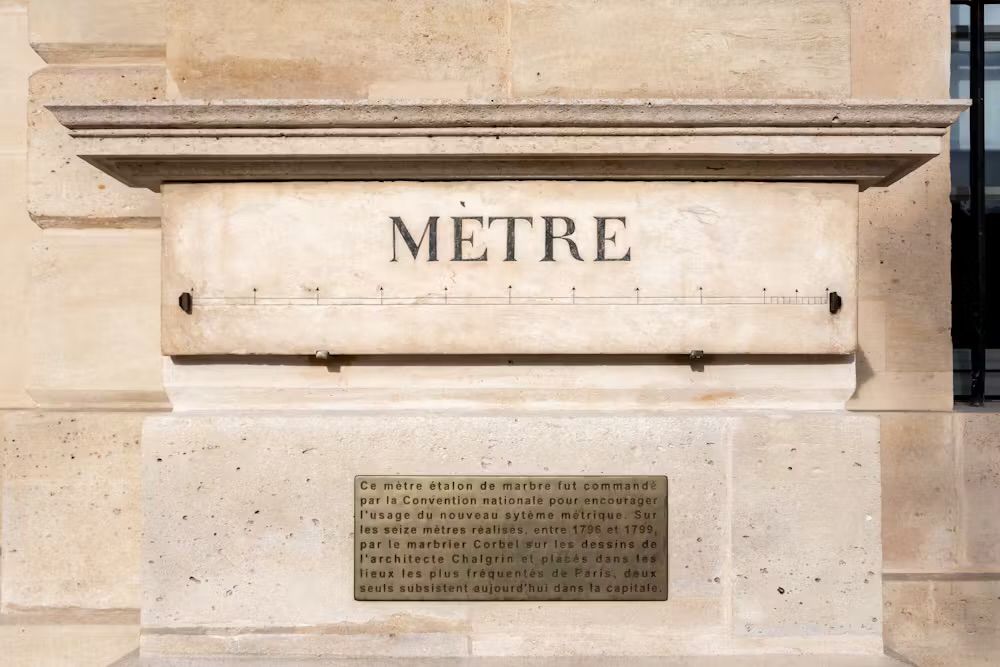
The Marble Metre – A Monument to Metric Standardization
This image showcases a historical marble metre standard affixed to a public wall in Paris, bearing the inscription “MÈTRE” in bold capital letters. Below the etched measurement line, a bronze plaque offers context in French: it explains that this standard metre was commissioned by the National Convention during the French Revolution to promote the use of the newly adopted metric system. Between 1796 and 1799, sixteen such metre standards were distributed across the most frequented locations in Paris. Only a couple remain today, making this one of the few surviving physical links to the dawn of global metric reform.
This physical artefact is a testament to the revolutionary ambition to rationalize and democratize measurements—a dramatic shift from the arbitrary, inconsistent systems previously used across regions and kingdoms. The metre was initially defined as one ten-millionth of the distance from the equator to the North Pole, a bold attempt to root human systems of measure in the natural world. The engraving above and below the line is both decorative and symbolic, intended to make the metre relatable and visible to the public at a time when education and civic unity were seen as revolutionary tools.
The installation of these standards in urban spaces allowed ordinary citizens to verify the length of goods in markets and trades, ensuring transparency and fairness. It reflects how the metric system was more than a scientific innovation—it was a sociopolitical tool for equity, knowledge, and national cohesion. The metre bar captured here is more than just a measure of length; it is a relic of enlightenment thinking, a marker of France’s pivotal role in shaping modern scientific standards, and a reminder that even the most ordinary-seeming measurements can hold profound historical significance.

Metric Life – Everyday Uses of the French Revolutionary System
This colorful 18th-century illustration, titled “Usage des Nouvelles Mesures”, vividly depicts the practical application of France’s revolutionary metric system in everyday life. It was created during the late 1790s, shortly after the adoption of the metric system, and serves as both educational propaganda and civic instruction. Each panel in the print showcases citizens using the newly standardized units of measurement—litre, gramme, mètre, and more—in daily tasks, ranging from trade and cooking to architecture and surveying.
At the top, a woman measures out ingredients with standardized volumes, symbolizing how the metric system brought precision into domestic life. Nearby, a man weighs goods using the gram, a unit that replaced countless inconsistent local weight systems. Below, a mason uses the metre to measure stone for construction, reinforcing how metric measurements unified trades across regions. The images emphasize not just the rationalization of commerce and labor, but also the democratization of knowledge—making measurement consistent, fair, and accessible for all.
This artistic artifact came during a time when the French Revolution was transforming society, not just politically but intellectually. The metric system, born out of Enlightenment ideals, was part of a broader effort to replace feudal, arbitrary systems with ones grounded in reason and universality. It symbolized the rejection of royal decrees and church-imposed units in favor of something that all could agree upon: nature and logic.
The illustration became a tool to educate a largely illiterate population on abstract concepts of mass, length, and volume. It was part of the Republic’s broader mission to unify the nation and promote secular, scientific order. Even today, this image stands as a historical testament to how revolutionary France not only changed politics, but fundamentally redefined how the world measures itself.

The French Republican Calendar and the Symbolism of Enlightenment Order
This richly detailed image depicts an ornate calendar from the French Republican era, specifically covering the years 1793 to 1794. At its center is an allegorical representation of Justice or Reason, portrayed as a seated female figure clad in classical robes. She holds a balanced scale in one hand and a golden weight in the other, embodying Enlightenment ideals of rationality, equality, and measurement. The surrounding imagery bursts with revolutionary symbolism: a radiant all-seeing eye, rays of light, and a pyramid evoke knowledge, vigilance, and a divine order rooted in science. Banners above and below her read, in French, “Indivisible Unity of the Republic” and “Liberty, Equality, Fraternity or Death”—mottoes of the revolutionary ethos.
A cornucopia of fruits and flowers spills forth beside tools of measurement and learning, emphasizing abundance through reason and harmony. Below the seated figure lies the actual Republican calendar grid, which replaces the traditional Gregorian months with uniquely French ones—like Germinal, Floreal, and Prairial. Days are listed using the decimal system, with décades instead of weeks, a radical departure designed to sever ties with religious and monarchical timekeeping. This calendar was part of a broader push for universal standards of weights, measures, and time during the French Revolution, laying cultural groundwork for the metric system. The artwork not only captures a brief moment in France’s sociopolitical experimentation but also celebrates humanity’s quest to measure the world by logic, not legacy.
On May 20, 1875, the Metre Convention was signed in Paris, establishing the metric system. This global agreement laid the foundation for SI units, standardizing measurement across science, medicine, and trade worldwide.
#StayCurious #Skystorians #DiveIntoDiscovery
20.05.2025 21:00 — 👍 2 🔁 0 💬 0 📌 0
















































































































